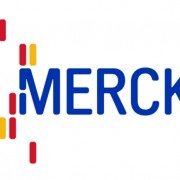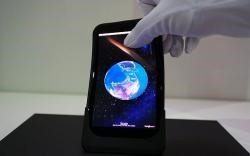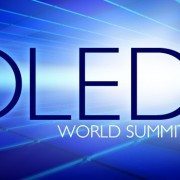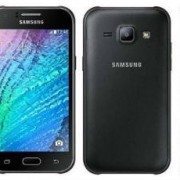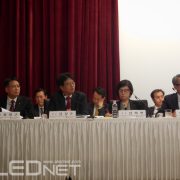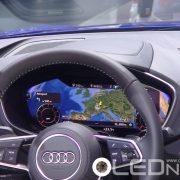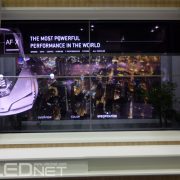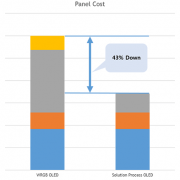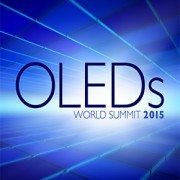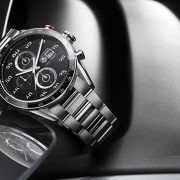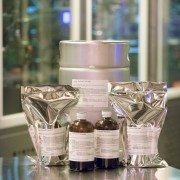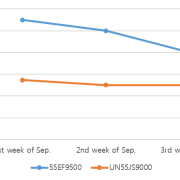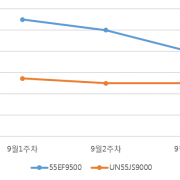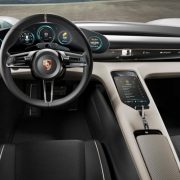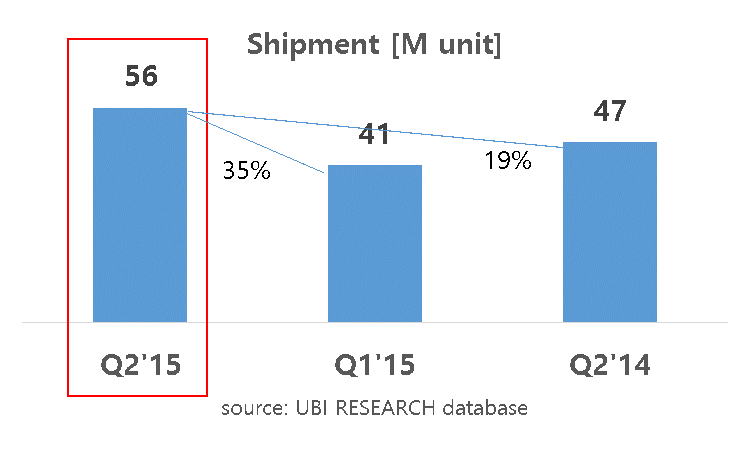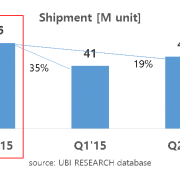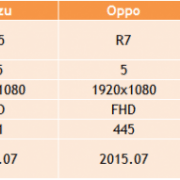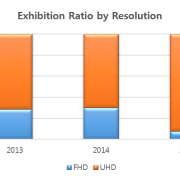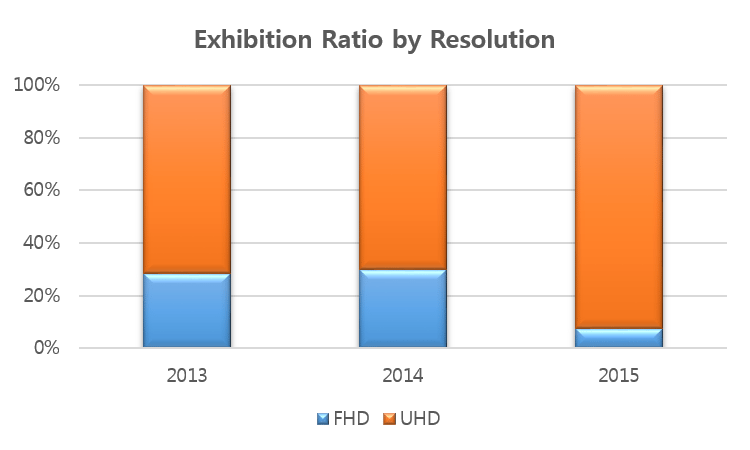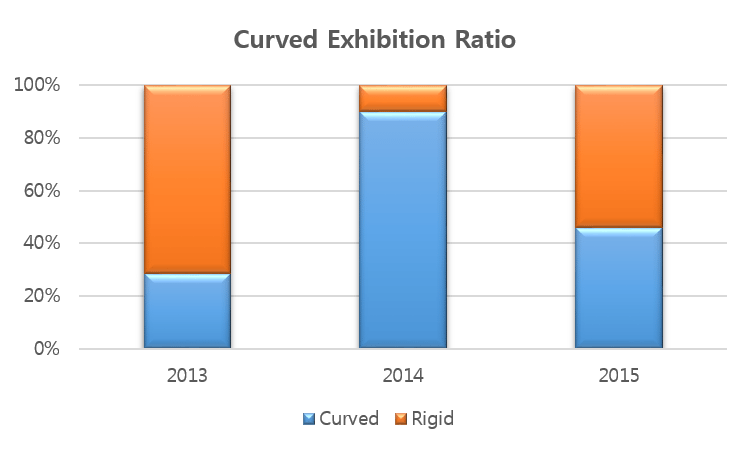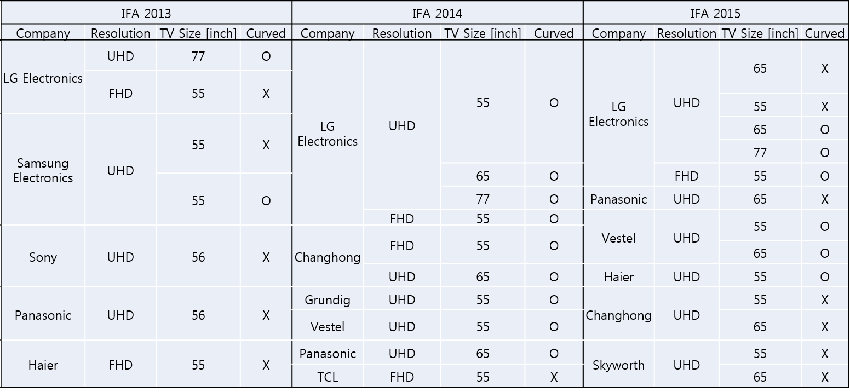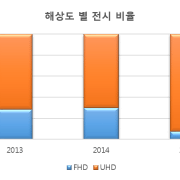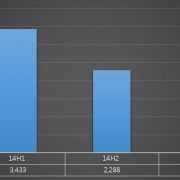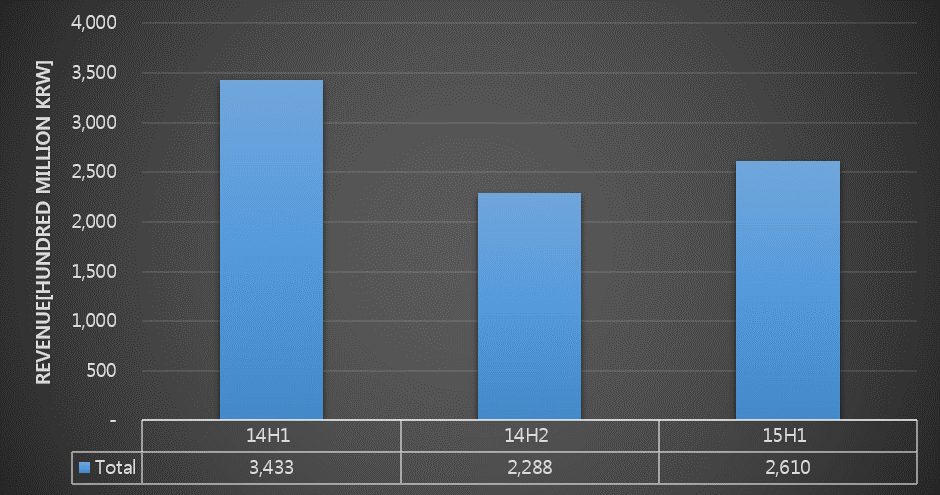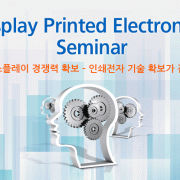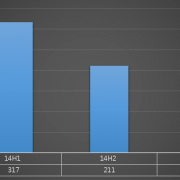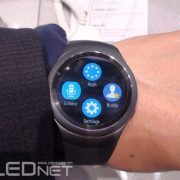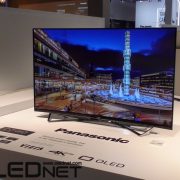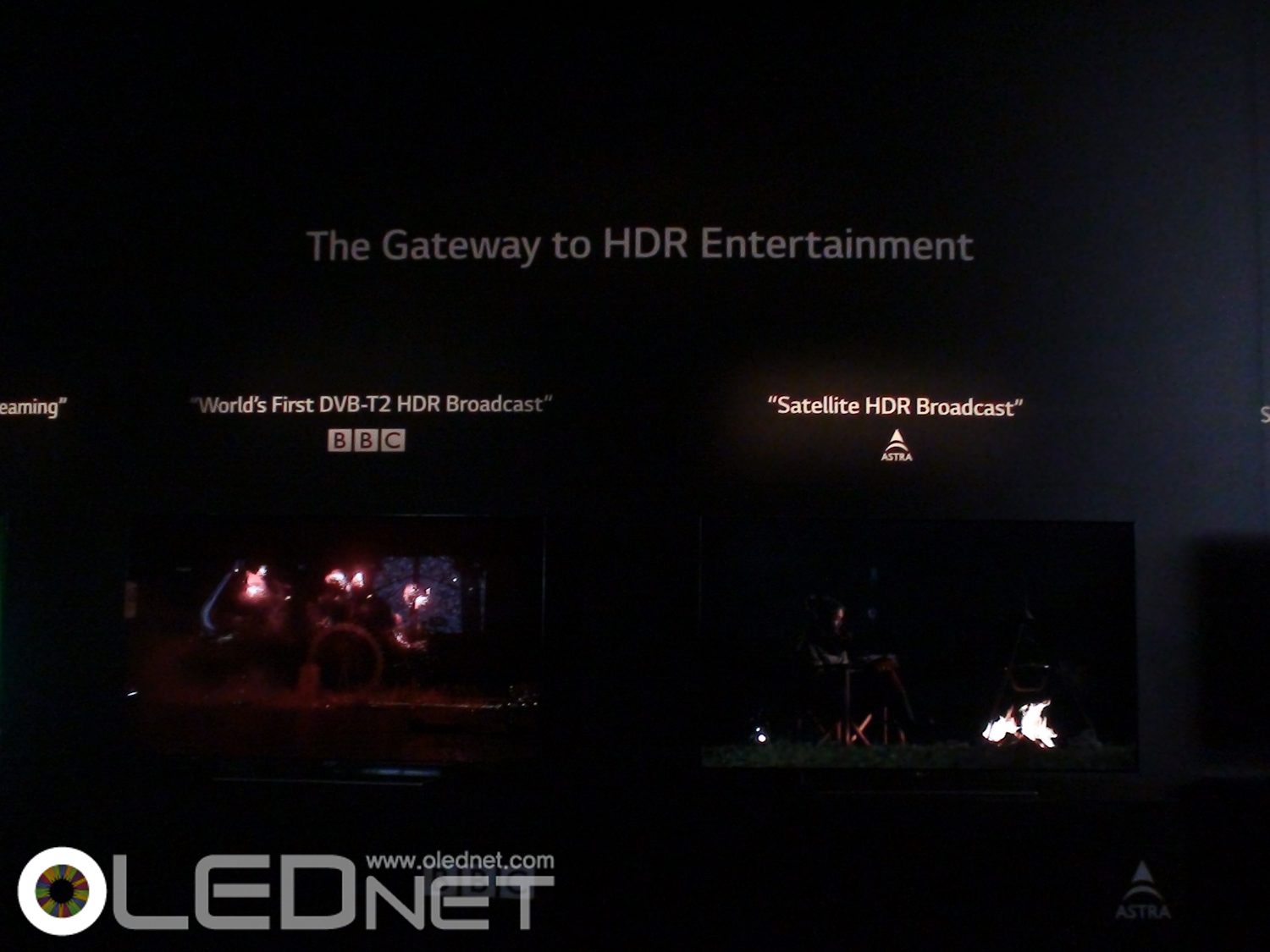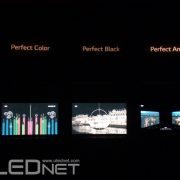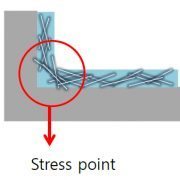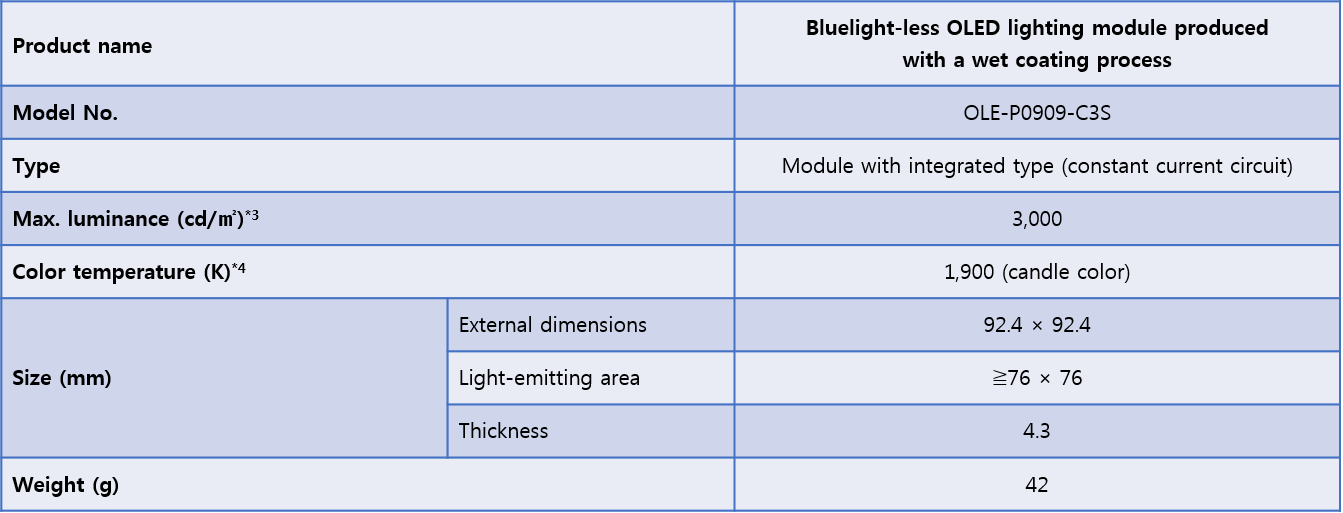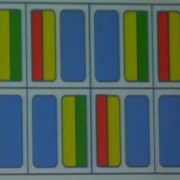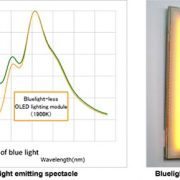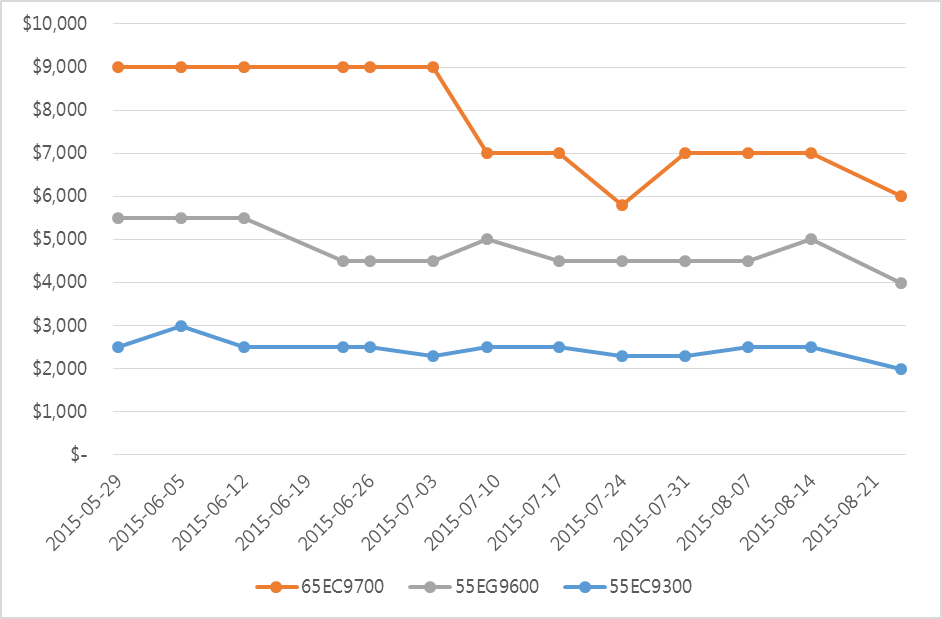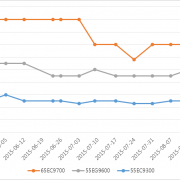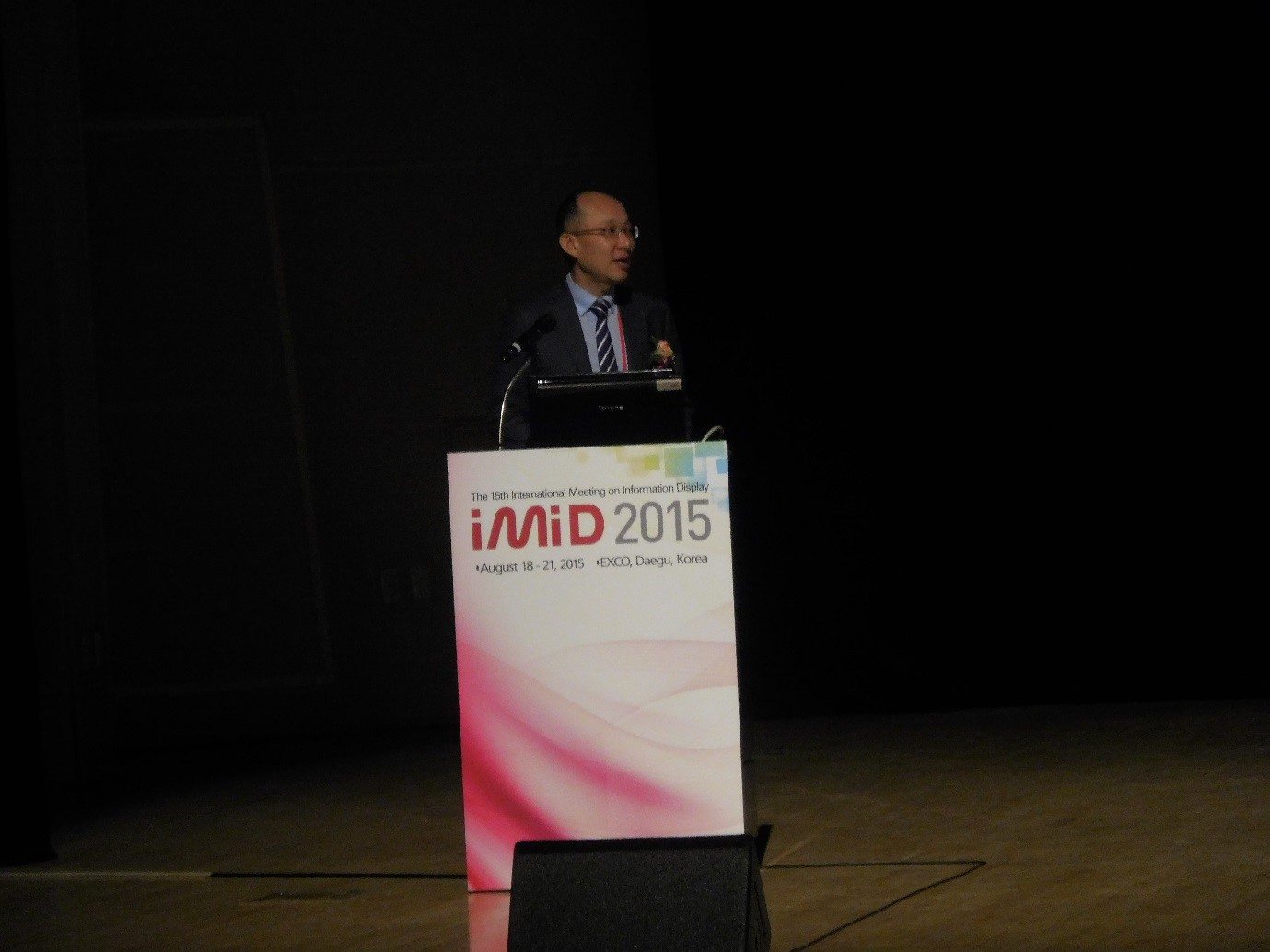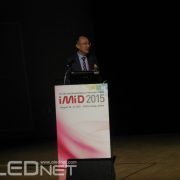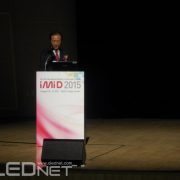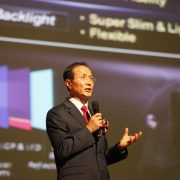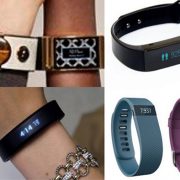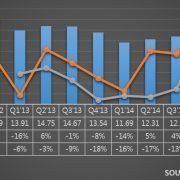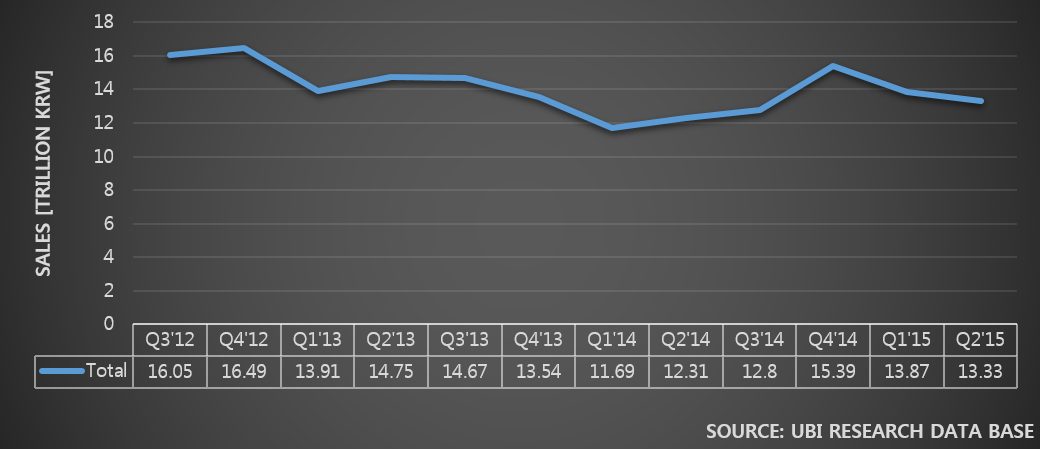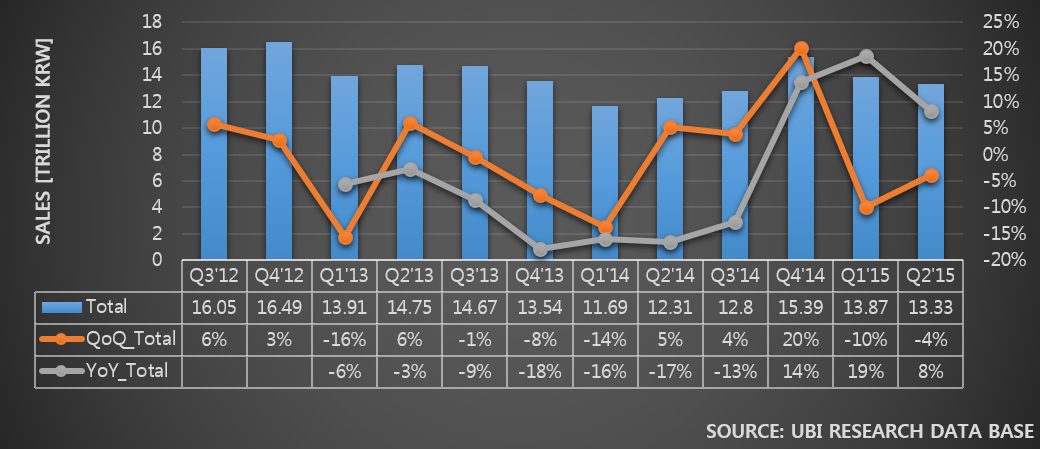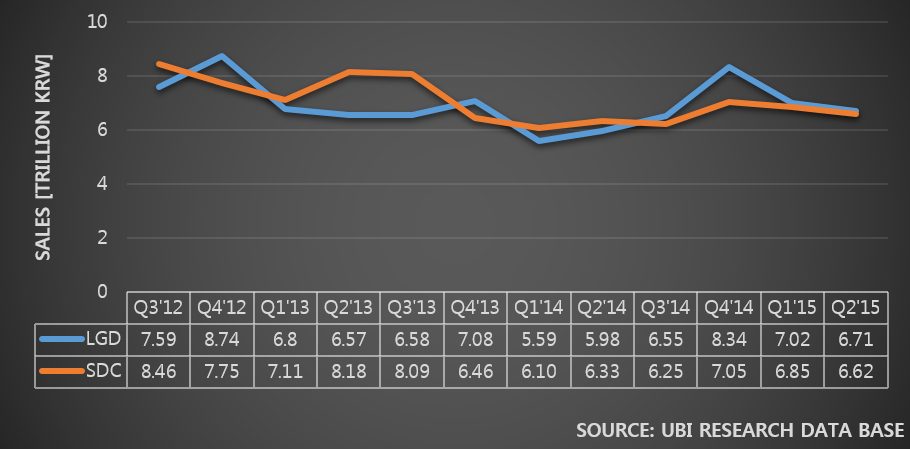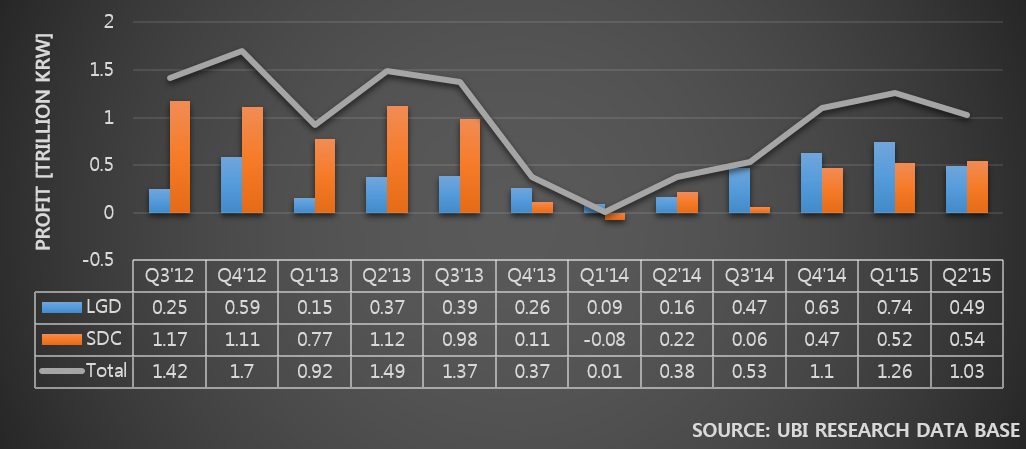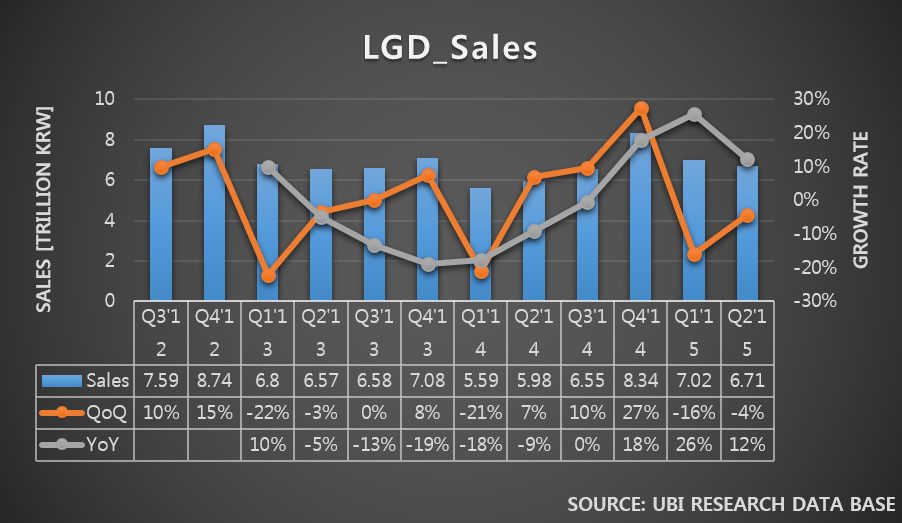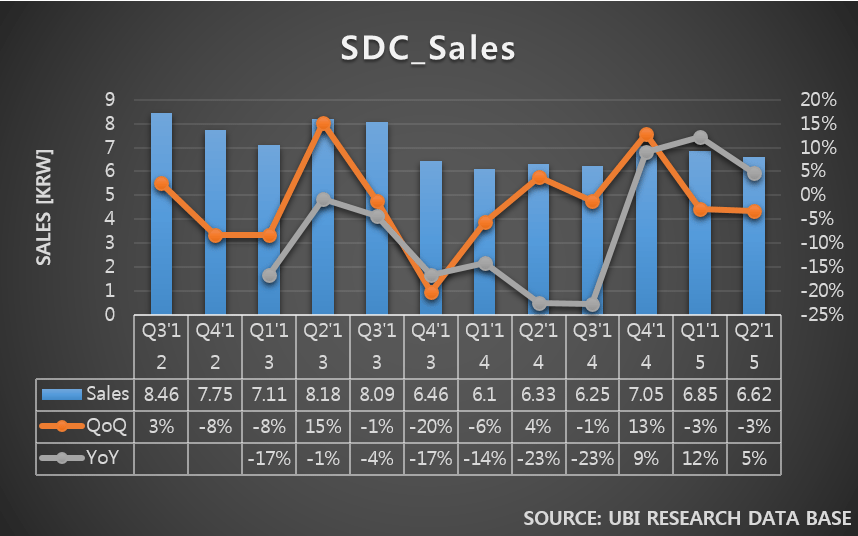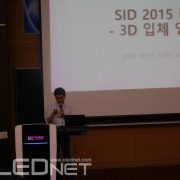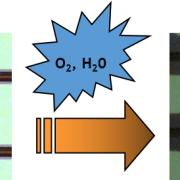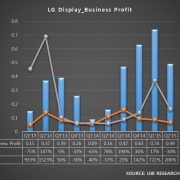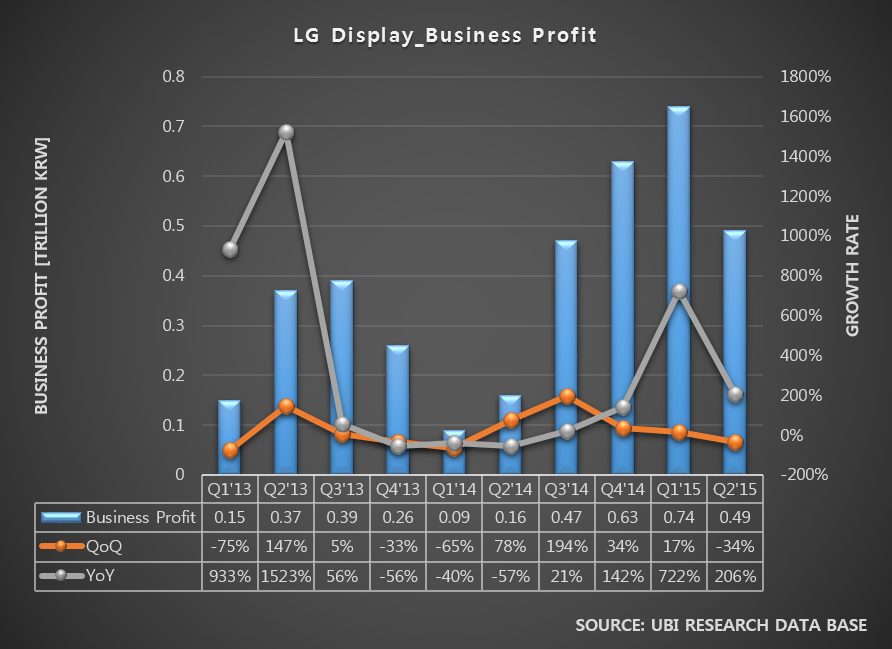Visionox Reveals 604PPI High Resolution AMOLED
/in Technology /by OLEDNETOn November 12, Visionox announced that they recently developed 604ppi (approximately 4.85inch) high resolution full color OLED panel through FMM (fine metal mask) using evaporation technology.
In 2014, Visionox developed 570ppi RGB AMOLED panel with newly developed pixel structure, Z-Type. This Z-Type arrangement had larger blue sub-pixel with green and red sub-pixels beside it. The new panel has resolution of 604ppi which is a 35ppi increase from the 2014 panel. With this new reveal, Visionox displayed their high resolution OLED technology improvement.
The 604ppi panel combined the self-developed pixel layout under proprietary intellectual property rights and co-developed Chinese FMM. The resolution is 2,560 × 1,440, manufactured using real RGB method and not pentile.
Chinese companies are developing their high resolution AMOLED panel technology at a fast pace. In August, EverDisplay presented 734ppi 6inch panel, and the technology difference with Korean panel companies is rapidly decreasing.
Visionox revealed that this OLED panel shows Visionox’s research development for high resolution OLED is continuing and aptly demonstrated the current results.
Visionox, 604PPI의 고해상도 디스플레이 기술을 개발하다.
/in 미분류 /by OLEDNET11월 12일 Visionox에 따르면 최근 FMM(Fine Metal Mask)을 사용한 증착기술을 통해 604PPI(약 4.85inch)의 고해상도 full color OLED 패널을 개발했다고 밝혔다.

Visionox Z-Type(Source : OLED-info)
Visionox는 2014년 Z-Type이라는 새롭게 개발한 픽셀구조로 570PPI의 RGB AMOLED 패널을 개발한 바 있다. Z-Type은 blue sub-pixel의 크기를 늘리고 green과 red sub-pixel을 그 옆에 배치한 pixel 구조이다. 이번에 발표한 패널은 이보다 35PPI가 더 높아진 604PPI이다. 이로써 Visionox의 고해상도 OLED 기술이 한 단계 더 발전한 것으로 보여진다.
이번에 개발된 패널은 자체 개발 pixel 레이아웃과 중국 업체들끼리 공동 개발을 한 FMM을 적용하였다. Pentile 방식이 아닌 real RGB 방식으로 제작되었으며, 해상도는 2,560 × 1,440 이다.
중국업체들의 고해상도 AMOLED 패널 기술개발이 빠르게 진행되고 있다. Everdisplay는 2015년 8월 734PPI의 6인치 패널을 공개 했으며 한국의 패널업체와의 기술격차는 현재 빠르게 줄어들고 있는 것으로 분석된다.
Visionox는 이번에 개발한 OLED 패널은 Visionox의 고해상도 OLED를 위한 연구개발이 지속적으로 이루어지고 있고, 현재의 연구성과를 잘 보여주는 것이라고 밝혔다. 또한 이번 기술 개발 발표를 통해 유비산업리서치는 고해상도 AMOLED 패널 양산이 한 층 앞당겨졌다고 분석했다.

604PPI High Resolution Display Panel (real RGB)(Source : Visionox)
[IWFPE 2015] What Will Replace ITO?
/in Technology /by OLEDNET2015 IWFPE (International Workshop on Flexible & Printable Electronics) was held at Le Win Hotel in Jeonju, South Korea (November 4-6). During the workshop, many OLED display related presentations commented on ITO’s replacement material.
Dr. Jennifer Colegrove, CEO of US research company Touch Display Research, discussed hot trends of 2015-2016. Dr. Colegrove included high resolution, transparent display, wearable device, and flexible display in the hot trends. Of these she pointed out ITO replacement material regarding touch panel. She mentioning metal mesh, silver nanowire, CNT, and graphene as materials that could replace ITO. Dr. Colegrove added that the material has to be flexible in order to be applicable to flexible display and needs to have high efficiency.
Hanwha Techwin’s Dr. Seungmin Cho announced that graphene, which has higher uniformity compared to ITO, will be the material of future. With lower resistance than ITO, graphene shows good characteristics, but Dr. Cho explained that high cost and particles produced are issues that need to be solved. He also commented that China selected graphene related national projects and is striving to develop the technology.
Dr. Hyunkoo Lee of ETRI (Electronics and Telecommunications Research Institute) presented that the multi-layered graphene that ETRI, Sungkyunkwan University, and KAIST (Korea Advanced Institute of Science and Technology) co-developed will become the material that can replace ITO. He also introduced the results that as the transmittance is particularly high, it is suitable for transparent display, and compared to silver nanowire material in high resolution top emission structure, the display’s brightness is higher.
ITO replacement development is an issue for the future of display industry’s progress. It is estimated that research development on graphene as one of the ITO replacement electrodes will be actively carried out.
[IWFPE 2015] ITO의 자리를 꿰찰 소재는?
/in 미분류 /by OLEDNET지난 11월 4일부터 ‘2015 국제 인쇄전자 및 플렉서블 디스플레이 워크숍(IWFPE 2015)’가 전주 르윈호텔에서 열렸다. 이번 워크숍에서 OLED 디스플레이 관련 발표 중에는 ITO의 대체 소재에 대한 언급이 많았다.
미국의 리서치 업체 Touch Display Research의 CEO, Jennifer Colegrove박사는 2015-2016의 핫 트렌드를 발표했다. Colegrove박사가 발표한 핫 트렌드는 고해상도화, 투명 디스플레이, 웨어러블 디바이스, 플렉서블 디스플레이 등이 포함되어 있다. 핫트렌드 중 특히 touch panel에 관련해서 ITO 대체 소재를 꼽았다. ITO를 대체할 수 있는 소재로는 메탈 메쉬, 실버 나노와이어, CNT, 그래핀 등을 언급했다. Colegrove박사는 ‘ITO를 대체할 수 있는 소재는 플렉서블 디스플레이에 맞출 수 있게 유연해야 하며, 효율이 좋은 재료가 필요하다’라고 덧붙였다.

한화테크윈의 조성민 연구원은 ITO보다 균일도가 높은 그래핀이 미래의 소재가 될 것이라고 발표했다. 특히 그래핀은 저항이 ITO 보다 낮아 좋은 특성을 보이지만, 제작 시 발생하는 파티클과 높은 비용은 해결해야 할 이슈라고 말했다. 때문에 중국에서는 그래핀에 관련된 국책과제들이 선정되어 기술 개발에 힘쓰고 있다고 덧붙였다.
ETRI의 이현구 책임연구원은 ETRI, 성균관대, KAIST에서 공동 개발한 다층 그래핀이 ITO를 대체할 수 있는 소재가 될 것이라고 발표했다. 특히 투과율이 높아 미래의 투명 디스플레이에 적합하고, 고해상도 top emission 구조에서 실버 나노와이어 소재와 비교해 디스플레이의 밝기가 더 높다는 결과를 소개했다.
앞으로 미래의 디스플레이 산업 발전을 위해 ITO의 대체 전극개발이 이슈이며, ITO 대체 전극의 하나로 그래핀에 대한 연구개발이 적극적으로 이루어질 것으로 예상된다.

[Merck Display Insight 2015] Merck Reveals Latest Performance Results for Red and Green Solution Process Materials
/in 미분류 /by OLEDNETOn November 5, during the 16th Merck Display Insight 2015 seminar, Merck revealed the development results for solution process materials. The solution process materials presented were red and blue materials’ efficiency, lifetime, and CIE.
At present UDC’s evaporation materials are being used in OLED mass production. UDC’s evaporation material performance, published on the company website, were compared with Merck’s materials. Merck’s red material’s efficiency was 19.1cd/A, lifetime was 5,900 hours, and the CIE was (0.66, 0.34) which were approximately 66% of UDC material’s efficiency (29cd/A), 26% of UDC material’s lifetime (23,000 hours), and showed equal CIE.
For Merck’s green material, efficiency was 76.4cd/A, lifetime was 5,200 hours, and the CIE was (0.32, 0.63). These were approximately 89% of UDC’s green’s 85cd/A of efficiency, and 29% of 18,000 hours of lifetime. The CIE were similar with UDC’s (0.31, 0.63).
The comparison of the published materials’ performance, efficiency of solution process materials are developed to the similar levels as evaporation materials, but material lifetime require more research. Through this seminar, Merck revealed that the LT95’s solution process material’s lifetime will be solution process OLED’s most crucial challenge.
During the question and answer part of the poster session, Merck also revealed positive outlook that full stack solution process OLED product will be produced within the next 3-4 years.
Despite being one of the latecomers within the OLED material business, Merck is producing notable results in solution process material development and OLED material sales. This year’s sales results are anticipated to be higher than expected.
According to 2015 Solution Process OLED Annual Report, published by UBI Research, the key issue for solution process OLED is solution process emitting material performance. The solution process red and green’s efficiency reached to the similar levels as evaporation material. However, lifetime showed to be ≤approx. 30% of evaporation material in LT95. On the other hand, solution process blue is analyzed to be falling behind evaporation material in both lifetime and efficiency. As such, it is estimated that solution process OLED will be mass produced using the hybrid structure where red and green are formed through printing, and blue is formed through evaporation.
[IWFPE 2015] AUO’s Bendable AMOLED
/in Technology /by OLEDNETDuring the IWFPE 2015 (November 4-6) held in Jeonju, South Korea, AUO gave a presentation on bendable AMOLED’s concept and technology first revealed in August.
AUO’s R&D manager Terence Lai reported that the bendable AMOELD can actualize new user interface through applying display’s bending characteristics and this can be the innovation that could change the existing touch interface.
AUO’s bendable AMOLED is 5inch with 295 PPI using the LTPS TFT and hybrid encapsulation with top emission structure. It has 02.mm thickness and through bending sensor of file type, it can process diverse functions by detecting different bending directions.
Current flexible AMOLED trend is moving from curved to foldable, jumping past bendable. Key panel companies and research laboratories are focusing on developing foldable.
It is anticipated that the AUO’s bendable AMOLED panel will provide new direction for the flexible AMOLED development that is heading toward foldable. Development of applications suitable to bendable and functions that utilizes bending characteristics are expected to be key issues.
[IWFPE 2015] AUO의 Bendable AMOLED
/in 미분류 /by OLEDNETAUO가 전주에서 열린 IWFPE 2015에서 지난 8월에 공개한 bendable AMOLED의 컨셉과 기술에 대해 발표했다.
발표자인 AUO의 R&D manager Terence Lai는 “Bendable AMOLED는 display의 bending 특성을 활용하여 새로운 user interface를 구현할 수 있으며, 기존의 터치 인터페이스를 변화시키는 혁신이 될 수 있다.”라고 발표하였다.
AUO의 bendable AMOLED는 5인치, 295 PPI이며, LTPS TFT와 hybrid encapsulation을 적용했으며 top emission 구조이다. 두께는 0.2mm이며 file type의 bending sensor를 적용하여 bending의 방향에 따라 다양한 기능을 할 수 있다.
현재 Flexible AMOLED는 curved에서 bendable을 건너뛰고 foldable로 가는 트랜드로 주요 panel업체들과 연구소에서 foldable 위주의 개발이 진행되고 있다.
AUO가 공개한 bendable AMOLED panel이 foldable로 직행하는 flexible AMOLED 개발 트렌드에 새로운 방향을 제시할 수 있을 것으로 기대되며, bendable에 적합한 application과 bending 특성을 활용한 기능 개발이 이슈가 될 것으로 분석된다.
[Merck Display Insight 2015] Merck, soluble red, green 재료의 최신 성능 공개
/in 미분류 /by OLEDNETMerck는 11월 5일 개최된 제 16회 Merck Display Insight 2015 세미나에서 soluble 재료의 개발성과를 공개했다. 발표한 soluble 재료는 red와 blue재료로, Merck는 이번 세미나에서 재료의 효율과 수명, 색좌표를 공개하였다.
현재 OLED 양산에는 UDC의 증착재료가 적용 중이며 홈페이지에 공개된 UDC의 증착재료 성능과 비교했을 때, Merck가 공개한 red 재료의 효율은 19.1cd/A, 수명은 5,900시간, 색좌표는 (0.66, 0.34)로 UDC 재료의 효율 29cd/A의 약 66%, 수명 23,000시간의 약 26%의 성능을 보였으며 색좌표는 동일했다.
Merck가 공개한 green 재료의 효율은 76.4cd/A, 수명은 5,200시간, 색좌표는 (0.32, 0.63)로 UDC의 증착재료 green의 효율 85cd/A의 약 89%, 수명 18,000시간의 약 29%의 성능을 보였으며 색좌표는 UDC 증착재료의 (0.31, 0.63)와 흡사했다.
공개된 재료들의 성능을 분석해보았을 때 효율은 증착 재료와 거의 근접한 수준까지 개발된 것으로 분석되지만 soluble 재료 수명은 개발이 필요할 것으로 보인다. Merck는 세미나를 통해 LT95에서 soluble 재료의 수명이 solution process OLED의 가장 핵심적인 도전이 될 것이라고 밝혔다.
또한, 포스터 세션에서 이루어진 질의 응답 시간에서는 3~4년내 full stack solution process OLED 제품 생산이 이루어질 것이라는 긍정적인 의견을 내비쳤다.
Merck는 OLED 재료 사업에서 현재 후발주자이지만 솔루션 재료 개발과 양산에 적용되는 OLED 재료의 판매에서 눈에 띄는 성과를 내고 있으며 올해 판매실적이 예상치를 뛰어넘을 것으로 기대되고 있다.
유비산업리서치에서 발간한 ‘2015 Solution Process OLED Annual Report’에 따르면 solution process OLED에서 가장 이슈가 되고 있는 부분은 soluble 발광재료의 성능으로, soluble Red와 green의 효율은 증착 재료와 거의 근접한 수준까지 개발된 것으로 나타났으나 수명은 LT95에서 증착재료의 약 30%이하의 수준으로 나타났다. 반면 soluble blue는 수명과 효율 모두 증착재료에 비해 부족한 것으로 분석되었기 때문에 solution process OLED는 red와 green은 printing 공정으로 형성하고 blue는 증착공정으로 형성하는 hybrid 구조로 첫 양산을 할 수 있을 것으로 전망된다.
LG OLED TV Records Highest Monthly Sales Volume
/in Market, Set /by OLEDNETLG Electronics’ strategy of OLED promotion and OLED TV price reduction appears to be working successfully.
On November 3, LG Electronics reported that the October sales exceeded 4,500 units, twice the volume of early 2015. Particularly, the sales volume of the first week of October exceeded 2,000 units and contributed to breaking the monthly sales volume record.
The OLED TV’s bigger price drops from the last week of September seem to have led the high sales volume in the first week of October. According to Amazon, 55inch FHD curved OLED TV fell to US$ 1,797 from October, approximately a 28% drop from August’s US$ 2,499. 55inch UHD curved OLED TV and UHD flat OLED TV also fell to the US$ 2,000 range, making the price difference with UHD LCD TV to be US$ 500. This price competitiveness is analyzed to contribute to the increased sales volume.
Aggressive marketing is also a factor for this sales volume growth. In September, LG Electronics installed OLED TV in 39 key airports in 23 countries including the US, Germany, and Russia, and revealed plan to install approximately 200 units of OLED TV until the end of October. Advertisement of OLED TV can also be easily seen in Korean subway stations. LG Electronics’ OLED promotion strategy, revealed during the Q2 performance announcement appears to be effective.
Recently, LG Electronics announced their aim to lead the OLED TV market through strengthening OLED=LG image and OLED TV and UHD TV product diversification.
LG OLED TV, 월간 판매량 최대치 경신
/in 미분류 /by OLEDNETLG전자의 OLED TV 가격 하락과 OLED 알리기 전략이 성공적으로 진행되고 있는 것으로 보인다.
LG전자는 10월 판매량이 연초 대비 2배 이상 늘어난 4,500대를 돌파했다고 3일 밝혔다. 특히 10월 첫 주 판매량이 2,000대를 상회하면서 월 판매량 기록을 경신했다.
OLED TV는 9월 마지막 주부터 가격 하락폭이 커지면서 10월 첫 주에 높은 판매량을 기록한 것으로 보인다. 미국의 인터넷 소매 사이트인 아마존 기준에55인치 FHD curved OLED TV는 10월부터 $ 1,797로 8월 $ 2,499에 비해 약 28% 하락했다. 55인치 UHD curved OLED TV와 UHD flat OLED TV도 $ 2,000 대로 떨어져 UHD LCD TV와 $ 500 차이로 가격 경쟁력을 갖춰 판매량이 늘어난 것으로 분석된다.
공격적인 마케팅도 판매량 상승의 요인으로 꼽힌다. LG전자는 지난 9월 미국, 독일, 러시아 등 23개국 39개 주요 공항에 OLED TV를 설치하고 10월 말까지 200여 대의 OLED TV를 설치하겠다는 계획을 밝혔다. 또한 국내 지하철 역에서 OLED TV 광고를 쉽게 접할 수 있다. 이처럼 LG전자가 지난 2분기 실적발표회에서 밝힌 OLED 알리기 전략이 점점 성과를 내고 있는 것으로 보인다.
한편 LG전자는 OLED TV와 UHD TV의 제품 다양화를 통해 OLED=LG라는 이미지 구축에 더욱 힘을 주겠다고 발표해 OLED TV 시장의 선도하겠다는 목표를 밝힌 바 있다.
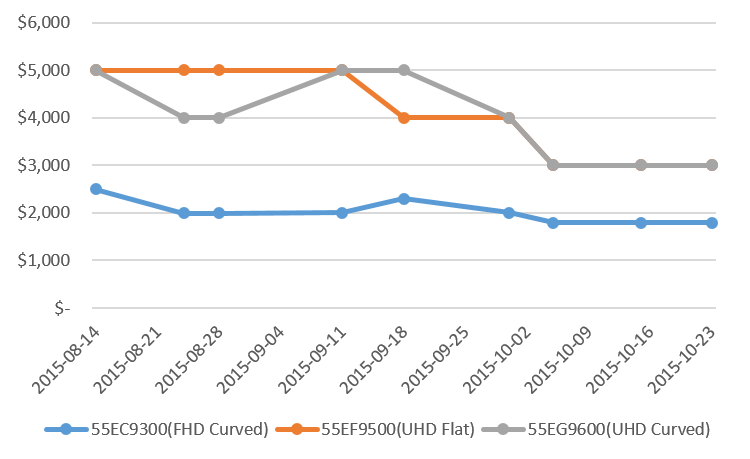
LG 55인치 OLED TV 가격 변화 추이
LG Electronics Strives to Establish OLED=LG Image
/in Market, Set /by OLEDNETOn October 29, during the performance announcement, LG Electronics revealed their plan to carry out aggressive marketing through establishment of OLED=LG image.
LG Electronics Home Entertainment business reported that the TV shipment doubled in this quarter compared its previous quarter due to OLED TV and UHD TV product mix. LG Electronics reported that OLED TV market expansion from Korea and North America into Europe and Russia among others contributed to the sales increase.
LG Electronics is anticipating sales increase in Q4 from peak TV market and general market promotion brought premium TV sales expansion. Accordingly, LG Electronics forecast their Q4 sales to be similar to 2014 and that business profit to increase slightly due to improvement in TV’s profit stabilization.
Regarding aggressive marketing from Chinse TV companies including Hisense, and TCL, Jinho Ha of LG Electronics Home Entertainment planning department, admitted the threat. However, through premium TV technology such as smart TV, design, and OLED, Ha explained that they will secure product superiority. He also added that Chinse companies’ North American TV market share is around 3% in terms of volume and remains minimal in revenue.
New premium OLED TV release brought better than expected response from consumers. It is also receiving positive reviews; several media have selected the product as this year’s TV. The company reported that they will strive to expand the market through extension from the premium TV.
LG Electronics’ total revenue was announced to be 13,000 million USD* with business profit of 270 million USD. Home Entertainment department reported 4,000 million USD, a 9% increase from previous quarter, with business profit of 33 million USD.
* 1 USD = 1,100 KRW
ETRI’s Doo-Hee Cho Receives IEC 1906 Award
/in Lighting /by OLEDNETOn October 23, ETRI (Electronics and Telecommunications Research Institute) Information & Communications Core Technology Research Laboratory’s Dr. Doo-Hee Cho received IEC 1906 Award at World Standards Day ceremony. The IEC 1906 Award recognizes exceptional current achievements and it is presented by the International Electrotechnical Commission, one of the top 3 international standards organizations.
Dr. Cho has been active in IEC since his involvement in 2009. The activities include serving as the president of IEC·TC34 (lighting)’s OLED working group and establishment of IEC 62866: Organic Light Emitting Diode (OLED) panels for general lighting – Safety requirements.
Founded in 1906, IEC is one of the top 3 international standards organizations along with ISO (International Organization for Standardization) and ITU (International Telecommunication Union) with 83 member countries. IEC established IEC 1906 Award in 2004. Since then they have been selecting industry’s experts with outstanding contribution to electrotechnical standardization and IEC development and presenting the award annually. With this award for Dr. Cho, acceleration to OLED lighting’s international standardization and OLED lighting business growth are anticipated.
LG Display Reveals Confidence in OLED
/in Market /by OLEDNETOn October 22, LG Display emphasized their conviction in large area OLED and plastic OLED once again when announcing the performance results held in LG Twin Towers. LG Display revealed that their future business will be OLED and will lead the market through OLED.
LG Display’s CFO Sang-don Kim announced that OLED is the top priority in terms of portfolio, and regarding display’s future direction, explained that there is new momentum through automotive, IoT, and commercial display. He also added that the sales did not quite meet what was estimated earlier this year but it is on proper track.
LG Display is estimating 400-500 thousand units of OLED TV panel shipment for TV and aiming for 1 million units next year. Regarding the poor sales, he gave trial errors in new technology development, which was the main focus, as the reason. LG Display will plan optimized investment after market trend consideration.
In 2015, 55inch or larger panel for TV occupied 8% of the shipment, but the target is gradually increasing it to 20% or higher. LG Display highlighted TVs are becoming larger at a fast pace; 65inch and 77inch OLED TV, rather than what was expected to be the main product 55inch, showed higher than expected sales. Kim explained that to maximize production cost reduction of OLED panel, they are internally adjusting material cost and yield. He also forecast that the demand will increase through production increasing projects.
LG Display recorded 7,000 million USD* of revenue in 2015 Q3. This 7% increase compared to its previous quarter is due to the increase of shipment area through TV’s panel size increase and success of product mix. Business profit fell by 32% compared to previous quarter with 300 million USD*. LG Display revealed they will push for profit improvement through inventory level management and operation rate adjustment. They also reported they will strengthen competitiveness through synergy with OLED lighting business and showed anticipation for future.
* 1 USD = 1,100 KRW
Absolute Requirements for the Automotive OLED Display’s Success
/in Set /by OLEDNETOn October 15, in IMID Exhibition Business Forum held in Korea International Exhibition Center (October 14-16), KATECH (Korea Automotive Technology Institute)’s head of Intelligent Control System R&D Center Dr. Inbeom Yang presented ‘Future of Automotive Technology and the Role of Smart Display’ and forecast the future of automotive display.
Dr. Yang revealed that “if existing vehicles focused on technological factors, future vehicles will evolve entirely centering on the driver, and the automotive display also will develop following this trend”. He also added that the driver’s safety and convenience have to be the priority.
Dr. Yang gave 4 examples of future automotive display. Firstly, he discussed ADAS and their flaws. ADAS (Advanced Driver Assistance Systems) help the driver to operate the vehicle safely. If ADAS can be actualized through displays such as HUD (head-up display), the driver’s safety can be maintained with ease.
The second item mentioned was a function that notifies the driver status reports linked with time and location. Dr. Yang reported that a device needs to be developed that can function in specific situations with sensors and sounds as well as on display.
Dr. Yang forecast that if display, touch technology, and haptic technology are combined and applied to vehicles, operation and feedback will be simpler for the driver. He announced that multi-functional & configuration display will also be introduced which will allow driver to recognize and control.
Audi’s concept vehicle that was presented in IAA 2015 Audi e-tron quattro has full OLED interface and all functions required for the vehicle operation can be controlled via touch display without physical buttons.
As futuristic displays such as these are developed that increases driver’s convenience, the proportion of display within a vehicle is expected to increase, and developed focusing on the driver centered UI (user interface). OLED Display can maximize the driver’s accuracy with fast response rate and high contrast ratio. Along with safety, and design freedom that comes with flexibility, it is suitable for automotive display. However, the linkage with the UI system optimized for the driver is essential rather than performance of the display panel itself; collaboration between display panel companies, and automotive system and peripheral companies is expected to be a major point in early market occupancy between automotive display panel companies.
LG Electronics Bets on OLED TV
/in Exhibition /by OLEDNETLG Electronics actively began aggressive marketing for OLED TV.
In IMID Exhibition (October 14-16), LG Electronics installed an OLED comparison experience zone to allow the visitors to see OLED TV and LCD TV at once. This direct comparison exhibition with OLED and LCD is the 2nd one after one in WIS 2015. In this exhibition in IMID Exhibition 2015, LG Electronics presented their new 2015 release 55inch UHD LCD TV and 55inch UHD OLED TV. This is considered a reflection of LG Electronics’ determination to target the market through OLED TV rather than LCD TV.
LCD TV is illuminated through BLU and therefore difficult to achieve perfect black. Through IMID Exhibition 2015’s comparison experience zone, LG Electronics emphasized OLED TV’s merits such as perfect black, perfect viewing angle, and ultra slim design.
Since the release of OLED TV, LG Electronics continued presentations that emphasized OLED TV’s advantages in diverse exhibitions. However, recently they are pursuing aggressive promotion focusing on OLED even exhibiting comparison against their own latest LCD TV. On the other hand, their rival Samsung Electronics is maintaining their 2-track strategy of using OLED and LCD in different applications each. The industry is focused on how these development will affect the large area TV market.
LG전자, OLED=LG 이미지 구축에 힘쓴다
/in 미분류 /by OLEDNETLG전자가 29일 여의 트윈타워에서 열린 실적발표회에서 OLED=LG라는 이미지 구축으로 공격적인 마케팅을 펼칠 계획을 밝혔다.
LG전자 HE사업부는 이번 3분기에 OLED TV와 UHD TV의 제품 믹스로 TV 출하량이 전분기 대비 2배 증가했다고 발표했다. 또한 한국, 북미 중심의 판매 시장에서 유럽, 러시아 등의 OLED TV 시장 확대도 매출 증가의 요인으로 꼽았다.
LG전자는 TV 시장 성수기와 시장 전체 프로모션을 통한 프리미엄 TV 판매 확대로 4분기 매출의 상승을 기대하고 있다. 이에 LG전자의 4분기 매출액은 전년과 유사할 것으로 전망했으며, 영업이익은 TV의 수익 안정화 개선으로 소폭 상승할 것으로 내다봤다.
LG전자 HE기획관리 하진호 상무는 하이센스, TCL 등 중국 업체의 공격적인 마케팅에 대해 ‘중국 TV업체가 위협적인 것은 사실이다’라며 ‘스마트 TV, 디자인, OLED 등의 프리미엄 TV 기술력으로 제품군 우위를 확보해 나갈 것’이라고 설명했다. 현재 중국 업체의 북미 TV 시장 점유율은 수량 기준 3% 대이고, 매출액 기준으로는 미미한 수준이라고 덧붙였다.
또한 OLED TV의 선신 시장에서 프리미엄 신모델 출시가 소비자 반응이 기대 이상이며 여러 평가 매체에서 올해의 TV로 선정하는 등 호의적인 평가를 받고 있다고 밝혔다. 이에 프리미엄의 위치에서 시장을 확대해 나가는 전략으로 시장 확대에 힘쓰겠다고도 말했다.
한편 LG전자의 전사 매출액은 14조288억원, 영업이익은 2940억원을 기록했고, HE사업부는 전분기 대비 9% 성장한 4조2864억원, 영업이익은 370억원으로 발표했다.
삼성과 LG, OLED의 미래를 공유하다.
/in 미분류 /by OLEDNET10월 27일부터 29일까지 미국 버클리에서 개최되는 OLEDs World Summit의 첫째 날, 삼성디스플레이와 LG디스플레이는 연이어 발표에 나섰다. 삼성디스플레이의 이창훈 상무와 LG디스플레이의 임주수 OLED 기술전략팀장은 각각 ‘The Future of OLEDs’와 A Future Game Changer’라는 주제로 OLED에 대해 발표했다.
삼성디스플레이의 이 상무는 먼저 발표에 나서며 모바일 시장 내에서 삼성디스플레이의 선도적인 역할과 삼성전자의 모바일 디스플레이가 이것을 어떻게 반영하였는지를 강조하였다. 이 상무는 사람의 눈의 구조와 다이아몬드 픽셀 구조 사이의 관계를 통해 일반 RGB픽셀 구조와 다른 삼성디스플레이의 다이아몬드 픽셀 구조를 설명하였다. 사람의 눈은 다른 색상보다 green에 더 민감하다. 다이아몬드 픽셀은 이런 특성을 반영해서 green 서브픽셀을 blue와 red 서브픽셀보다 2배 많도록 배치하여 형성한 픽셀구조다. 다이아몬드 픽셀 구조는 서브픽셀 packing을 최대화하고 PPI를 증가시키는 장점이 있다.
OLED 디스플레이의 이점에 대하여 이 상무는 삼성전자의 최신 스마트폰의 2가지 기능을 예시로 들었다. 먼저 AMOLED 디스플레이는 각 픽셀의 선택적 제어가 가능하다는 점을 말하며 삼성이 색약자를 돕기 위해 제공하는 Vision Aid라는 기술을 예로 들었다. 또한 OLED의 완벽한 블랙을 낼 수 있는 능력은 Super Dimming이라는 기술에 쓰여 어두운 환경에서 화면의 밝기를 2nit까지 줄일 수 있게 한다고 발표하였다.
LG디스플레이의 임 팀장은 미국의 성인들이 하루에 평균적으로 9시간 40분을 디스플레이를 보는데 쓴다고 밝혔다. 고품질 디스플레이의 중요성과 필요성을 강조하며 임 팀장은 삼성의 발표와 마찬가지로 완전한 블랙, 3D효과, 높은 색재현률 등 LCD보다 나은 OLED 디스플레이의 이점들을 발표하였다.
이 부사장과 임 팀장 모두 미래 OLED 디스플레이로 투명이나 거울디스플레이보다 플렉시블(플라스틱)OLED를 좀 더 중점에 두었다. 삼성디스플레이는 플렉시블 디스플레이를 위한 커버윈도우와 flexible backplane, touch sensor, encapsulation등 핵심 요소들에 대해 발표하였다.
LG디스플레이는 플렉시블 디스플레이의 디자인 자유도와 이것이 웨어러블과 모바일, 차량 시장에 미치는 영향에 대해 논했다. 임팀장은 또한 얼마나 OLED가 유연해질 수 있느냐가 가상현실(VR) 디스플레이 시장에 적용되는데 핵심적인 요소가 될 것이라고 전망했다. 두 명의 발표자들은 OLED 기술과 새로운 어플리케이션이 새로운 디스플레이 시장과 혁신에 필요하게 될 것이라고 단언하여 발표를 마쳤다.
삼성디스플레이는 TV에는 LCD 패널을 계속 넣는 대신 투명·미러·플렉서블과 같은 차세대 제품에는 OLED 패널을 적용하는 투 트랙 전략을 고수하고 있으며, LG디스플레이는 중소형 OLED 시장과 OLED TV 패널 시장을 동시에 노리고 있다. 이번 발표를 통해 두 업체 모두 미래 성장동력인 OLED의 기술수준 향상에 집중할 것으로 보이며 특히 단기적으로는 플렉시블 OLED 개발에 중점을 둘 것으로 전망된다.
Samsung to Increase External Transaction by More Than 30%
/in Market /by OLEDNETSamsung Electronics reported a third-quarter earnings through a conference call on October 29 local time. Samsung Display’s Chang Hoon Lee revealed that OLED panel’s production cost can now compete against LCD and the company has plans to increase the external transaction ratio by more than 30% of yield.
The display business department was expected to have a difficult time in Q3 2015 due to the smartphone market’s slowdown of growth and latecomers’ competitiveness increase. However, with the key customer base’s release of new products and increase of new clientele, and secured operation ratio, the performance results improved.
Lee also revealed 2016 strategy of increasing the low-to-medium priced products, expanding the new market, diversifying products, and procuring transaction base. Lee also added that Samsung will prepare to secure new growth power through transparent, mirror, HUD, and automotive display development via technology leadership in areas such as flexible OLED.
It was also announced that the additional installation of OLED line will be decided after examining the market status. A3 line has been in operation since April. Supply competitiveness will be strengthened through complementary investment for existing line.
Samsung Electronics recorded a 6% increase compared to the previous quarter with revenue of USD 47 billion. With the help of currency exchange rate, business profit showed approximately USD455 million compared to the previous quarter with USD 6.7 billion.
Samsung and LG’s Shared Vision for OLED
/in 미분류 /by OLEDNETOn the first day of OLEDs World Summit (October 27-29) held in Berkeley, USA, Samsung Display and LG Display gave their talks back to back. Samsung Display’s Vice President Chang Hoon Lee and LG Display’s Joo Soo Lim discussed their thoughts on OLED under the titles of ‘The Future of OLEDs’ and ‘A Future Game Changer’ respectively.
Samsung Display’s Lee, who gave his presentation first, reiterated Samsung Display’s leadership position in the mobile market and how Samsung Electronics’ recent mobile display reflects this. Comparing RGB pixel structure and their own diamond pixel structure, Lee drew comparison between human eyes and diamond pixels; due to cell distribution in eyes, humans are more sensitive to green colors and that diamond pixels reflect this by having twice as many green subpixels as blue and red ones. The diamond pixels also maximize the sub-pixel packing and increases the PPI.
Regarding the advantages of OLED display, Lee gave 2 examples using Samsung Electronics’ latest smartphone models. Utilizing the fact that selective control of each pixel is possible in AMOLED displays, Samsung provided Vision Aid to help people with color blindness. OLED’s ability to achieve total black is used in Super Dimming function where screen brightness can be reduced to 2nits to be used in the dark environment.
LG Display’s Lim revealed that an adult in the US spends 9 hours 40 minutes a day on average looking at one form of display or another. Highlighting the need and importance of quality display, Lim also discussed advantages of OLED display over LCD such as total black, 3D effects, and color gamut.
As the future OLED display, Both Lee and Lim placed slightly more emphasis on flexible (plastic) OLED than transparent or mirror display. Samsung Display discussed requirements necessary for a successful flexible display in more depth touching on the need for suitable cover window, flexible touch (sensor), flexible encapsulation, and flexible backplane. On the other hand, LG Display discussed flexible display’s design freedom and its influences on the wearable, mobile, and automotive markets. Lim also placed much importance on how flexible OLED can be used in virtual reality display market. The 2 speakers ended their talks affirming the need for new display market and innovation through OLED technology and new applications.
The presentations given by the 2 apparent leaders in the OLED display industry were remarkably similar with both speakers underlining major points of OLED in broad strokes. The need for solutions for future OLED, whether it be flexible, transparent, or mirror display, through innovation and technological advances is an absolute truth if not maybe too obvious. There also may be some comfort to be had in the shared vision within the OLED community. However, it is also a fact that numerous attendees of the conference commented on the similarities of the 2 presentations and the lack of any surprises.
삼성, OLED 외부 거래선 30% 이상 늘릴 계획
/in 미분류 /by OLEDNET삼성전자 DP사업부의 이창훈 상무는 29일 열린 컨퍼런스콜을 통해 OLED 패널 원가를 LCD와 경쟁할 정도로 확보하여 외부 거래선 비중을 생산량의 30% 이상으로 늘릴 계획을 밝혔다.
DP사업부는 2015년 3분기에 스마트폰 시장의 성장 둔화와 경쟁업체들의 성장으로 어려운 시장으로 예상되었었다. 하지만 주요 거래선의 신제품 출시와 신규 외부 거래선 확장, 가동률 확보를 통해 실적이 개선되었다고 발표했다.
이어 중저가 제품과 신흥 시장의 성장, 제품군 다변화, 고객 기반을 확보하는 2016년 전략도 밝혔다. 추가로 이창훈 상무는 ‘플렉서블 OLED 등의 기술 리더십으로 투명, 미러, HUD, 오토모티브용 디스플레이에 대한 개발로 신성장동력을 확보하도록 준비할 것’이라고 말했다.
OLED 라인 증설에 대해서는 4월부터 A3 라인을 가동하고 있고 시장 상황을 보고 결정하겠다는 계획이다. 또한 기존 라인은 보완 투자를 통해 공급에 대한 경쟁력을 강화할 것으로 답했다.
한편 삼성전자는 51조 6,800억원의 매출액을 기록하여 전분기대비 6% 상승했다. 영업이익은 환율 효과에 힘입어 7조 3,900억원 규모로 지난 분기보다 약 5,000억원 증가했다고 발표했다.
ETRI의 조두희 책임연구원 IEC 1906 Award 수상
/in 미분류 /by OLEDNET한국전자통신연구원 (ETRI) 정보통신부품소재연구소 조두희 박사가 23일 ‘세계 표준의 날’ 기념식에서 세계 3대 국제표준기구로 꼽히는 국제전기기술위원회(IEC)의 공로상인 IEC 1906 Award를 수상했다.
지난 2009년부터 IEC에서 활동해온 조두희박사는 IEC·TC34(조명)의 OLED 워킹그룹 의장을 역임하며 OLED 조명의 표준화를 위해 IEC 62866: Organic Light Emitting Diode (OLED) panels for general lighting – Safety requirements를 제정하는 등 국제표준전문가로서 활발한 활동을 펼쳐왔다.
1906년에 설립된 IEC는 국제표준화기구(ISO), 전기통신연합(ITU)와 함께 세계 3대 표준 기구 중 하나로 83개국이 회원으로 참여하고 있으며 2004년부터 IEC 1906 어워드를 제정, 전기기술 분야 국제표준화 업적이 탁월하고 IEC 발전에 기여가 큰 전문가를 선정해 매년 시상하고 있다. 이번 조두희 박사의 수상을 계기로 OLED조명 국제 표준 제정에 속도가 더해지고, 아울러 OLED 조명 산업의 성장이 촉진될 것으로 기대된다.

IEC 1906 Award 뱃지
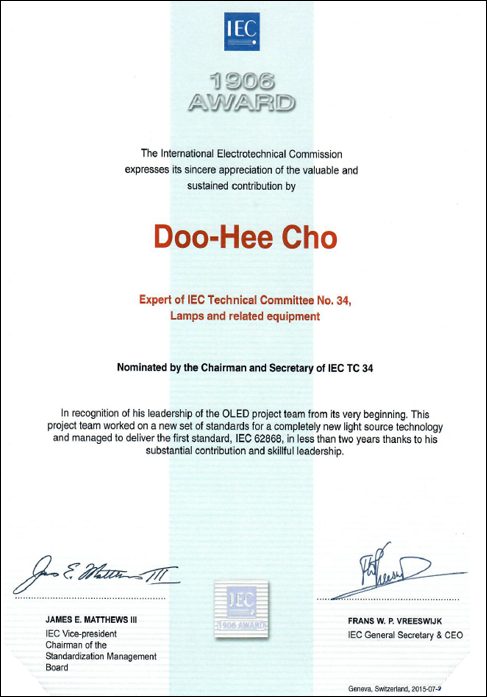
IEC 1906 Award 상장

조두희박사
What is Solution Process OLED’s Key Issue?
/in 미분류 /by OLEDNETIn the 2015 Display Printed Electronics Seminar held in The K Hotel in Seoul on October 7, Dankook University’s Professor Byung Doo Chin and Korea Research Institute of Chemical Technology’s Dr. Jaemin Lee gave presentations. They discussed key issues of solution process OLED; Professor Chin examined technological issues of print OLED/PLED device while Dr. Lee discussed technology trend of solution process OLED device.
Professor Chin reported that of the materials being used in current solution process, red, and green progressed greatly in terms of efficiency and lifetime. However, he explained that as blue’s efficiency and lifetime are lower than the other 2 colors, unless these issues improve, white actualization, as well as blue actualization, is difficult and panel cannot properly perform.
Material research development can occur for evaporation OLED only through material synthesis and purification. However, for solution process OLED, turning the materials to ink has to be additionally considered. Dr. Lee announced that diverse collaboration are happening between material and ink related companies for these reasons.
In the seminar, Professor Chin and Dr. Lee agreed that the key to the solution process OLED development is material characteristics development. According to the solution process material traits presented by Sumitomo Chem. and DuPont, while red and green traits are fast catching up to ones used for evaporation OLED, this is not true for blue. Despite these disadvantages, solution process OLED is a key technology that can produce large area RGB OLED panel using Gen8, or higher, manufacturing equipment; continued research development of solution process technology is expected in future.
Samsung Display Expands AMOLED Panel Supply. A Green Light for AMOLED Business?
/in Market /by OLEDNETOn October 7, Samsung Electronics announced tentative Q3 performance results. The announced sales figure and operating profit are approximately US$ 46,000 million and US$ 7,000 million each. These figures are an increase of 5.07% from previous quarter’s sales (US$ 44 thousand million) and a 5.8% increase from previous quarter’s operating profit (US$ 6,000 million), much higher numbers than industry’s expectations.
Compared to the same period in 2014, operating profit increased by 79.80%, and since last year’s Q4, the rise is continuing for the 4th quarter. The display business department’s much higher figures than expected is considered to be the main reason for this performance increase.
The major cause for this positive effects is increase in demand for general class AMOLED panel through Samsung Display’s aggressive procurement of customer base; AMOLED panel is applied to Samsung Electronics’ mid to low priced smartphones and there is great increase in AMOLED panel applied products by set companies of other countries such as China.
Due to the increased demand, Samsung Display’s operation rate rose, and it is estimated that this will also greatly affect material companies’ performance improvement.
LG디스플레이, OLED에 자신감을 드러내다
/in 미분류 /by OLEDNETLG디스플레이가 미래의 먹거리는 OLED가 될 것이고 OLED로 시장을 리드할 것이라고 밝히며 대면적 OLED와 플라스틱 OLED에 대한 확신을 22일 LG트윈타워에서 열린 실적발표회에서 다시 한번 강조했다.
LG디스플레이의 김상돈 전무는 ‘OLED를 포트폴리오 상 최고의 우선 순위로 두고 있다’고 말하며 앞으로 디스플레이가 나아갈 방향에 대해 ‘자동차용, IoT용, 커머셜 디스플레이 같은 새로운 모멘텀을 가지고 있다’고 설명했다. ‘올해 초에 계획한 판매량에는 미치지 못하지만 본궤도에 진입하고 있다’고 덧붙였다.
LG디스플레이는 OLED TV용 패널을 올해 40~50만대 출하를 전망하고 있고, 내년에는 100만대를 목표로 하고 있다. 올해 판매량 부진에는 신기술 개발에 주력하였으나 시행착오가 많았다는 이유를 밝혔다. 또한 시장 트렌드를 검토 후에 최적화된 투자 계획을 세울 것으로 앞으로의 투자 계획을 밝혔다.
올해 TV용 패널은 55인치 이상이 출하량의 8%를 차지하였지만 차차 20% 이상으로 끌어올릴 것으로 목표를 정했다. OLED TV에서는 주력 제품으로 생각했던 55인치보다 65인치, 77인치 제품이 예상보다 높은 판매를 기록하면서 TV의 대면적화가 더 빠르게 이뤄지고 있음을 강조했다. 김상돈 전무는 ‘OLED 패널을 극한의 원가 절감을 이루기 위해 내부적으로 재료비와 수율을 조정하고 있다’고 말하며 생산성 향상 프로젝트로 올해보다 수요가 증가할 것이라고 예상했다.
LG디스플레이는 2015년 3분기 7조1,580억원의 매출을 기록했다. 이는 전분기 대비 7% 상승한 값으로 TV의 대면적화로 인한 출하면적 상승과 제품 믹스의 성공을 요인으로 꼽았다. 영업이익은 3,330억원으로 전분기 대비 32% 하락했다. 4분기에는 재고 수준 관리와 가동률 조정으로 수익성 개선을 추진할 것으로 밝혔다. 또한 OLED 조명 사업과의 시너지로 경쟁력을 강화할 것을 밝히며 앞으로의 기대감을 내비쳤다.
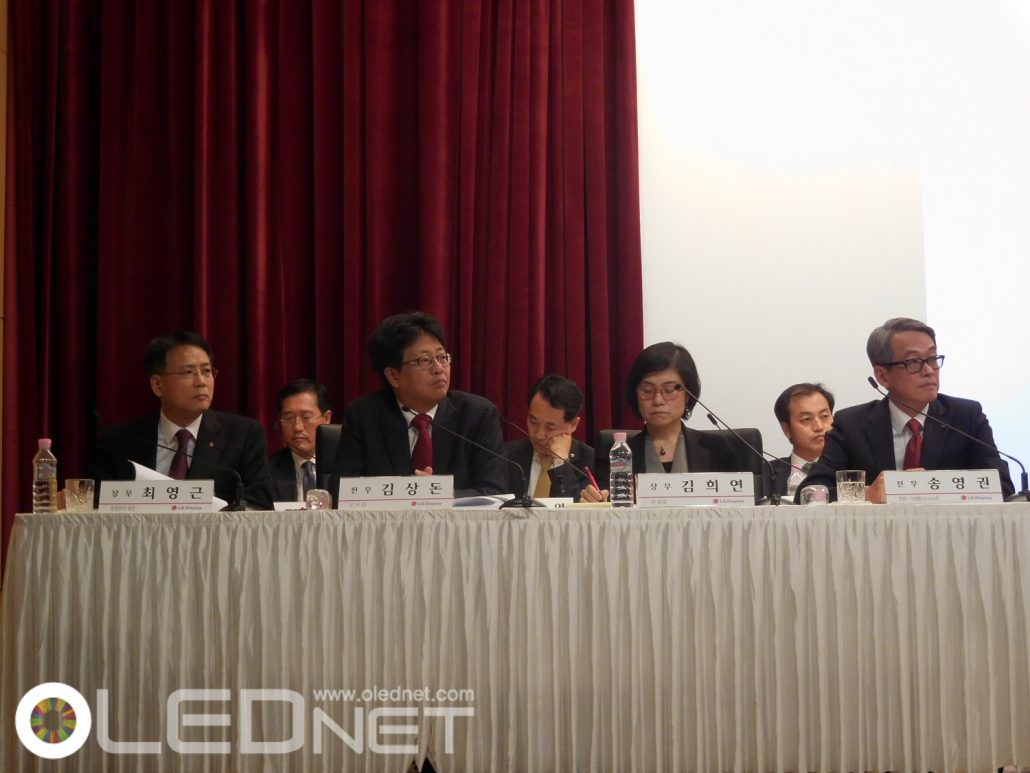
Solution Process Panel, Cheaper To Produce than LCD
/in Display, Focus on /by OLEDNETAccording to 2015 Solution Process OLED Report, published by UBI Research on October 14, solution process technology could produce 55inch OLED panel at approximately 43% cheaper cost compared to WRGB method.
The report added that this value is the result of analysis of 2015 Q2 55inch UHD OLED panel price and yield, which is slightly higher than current production price of 55inch UHD LCD panel. However, considering that the solution process OLED structure will become simplified and that yield of backplane and encapsulation can be improved, the OLED panels will be able to be produced at lower cost than LCD panel. The report also revealed that solution process OLED can be an alternative solution for large area OLED panel in achieving price competitiveness.
Solution process is a technology that can produce large area RGB pixel OLED panel using Gen8, or higher, equipment without cutting the mother glass. Key AMOLED panel companies are active in developing this technology.
However, as solvent is used in order to turn the existing evaporation material into ink, its purity is decreased leading to lower emitting efficiency and therefore lower lifetime. Despite these factors, key panel companies’ enthusiasm for solution process technology is due to the high emitting material usage efficiency without using color filter, and simple structure compared to WRGB OLED panel which leads to production cost decrease.
Panasonic has been most active in developing solution process applied OLED panel, and has presented several times in CES and IFA. BOE and AUO also have revealed solution process OLED panel produced via ink-jet manufacturing equipment, and CSOT is considering solution process development. Samsung Display and LG Display, leaders of AMOLED industry, are also actively developing the technology. LG Display has adopted Gen8 ink-jet manufacturing equipment, and Samsung Display has started solution process OLED panel development with a focus on ink-jet manufacturing equipment companies.
Material and manufacturing equipment companies as well as panel companies are leading the solution process technology development and commercialization. Kateeva agreed on technology collaboration with Sumitomo Chem. while Merck did the same with Seiko Epson. DuPont recently revealed that they enlarged solution process OLED material production facilities and began operation.
Following these participation by key panel, material, and manufacturing equipment companies in solution process technology development and commercialization, it is anticipated that the solution process OLED panel market will record rapid growth.
UBI Research’s 2015 Solution Process OLED Report forecast that solution process OLED panel market will actively begin mass production from 2018 and show approximately US$ 2,329 million in 2020.
LG Chem.’s OLED Lighting Business Toward LGD. What is the Future Direction?
/in Lighting /by OLEDNETIt was announced that LG Display will take over LG Chem.’s OLED lighting business department. As the department that was leading the opening of OLED lighting panel market is being merged into LG Display, a significant change in OLED lighting industry is anticipated.
One of the merits of this merge is expected to be further improving OLED lighting panel’s mass production potential through LG Display’s existing OLED panel mass production line, labor, and technology. Additionally, when new investment of OLED lighting panel mass production line is being processed, time and cost can be reduced on the basis of LG Display’s manufacturing equipment/material supply chains.
On the other hand, as OLED lighting market is still in initial stages the size is not so large. As such, whether LG Display will newly invest is a key issue. Generally, for display panel companies that invest with market size of thousands of millions of dollars in mind, OLED lighting panel line’s new investment does not seem to have a great advantage for LG Display.
Therefore, if LG Display carries out OLED lighting panel business, the first step is estimated to be mass production in parts of Paju’s AP2 line rather than new investment for OLED lighting panel mass production line. If parts of AP2 line begin mass production first, mass production timing can be much sooner than new investment and can positively affect expansion of OLED lighting panel market.
The issue is marketing strategy. In 2009, Samsung Electronics successfully opened AMOLED smartphone market in Korea via push strategy using AMOLED themed music video that became viral. Much like this, in order to show profit in OLED lighting panel business, LG Display should open the market through push marketing strategy.
차량용 OLED display가 성공하기 위한 필수조건
/in 미분류 /by OLEDNET10월 15일 일산 킨텍스에서 열린 IMID 비즈니스 포럼에서 KATECH(Korea Automotive Technology Institute)의 양인범 센터장은 ‘Future of Automotive Technology and the Role of Smart Display’라는 주제의 발표를 통해 차량용 디스플레이의 미래를 전망하였다.
양 센터장은 “기존의 자동차가 기술적 요소에 초점을 맞추었다면 미래의 자동차는 철저히 운전자를 중심으로 진화될 것이며 차량용 디스플레이 또한 이런 흐름에 맞추어 발전할 것”이라고 밝히며 운전자의 안전과 편리를 추구하는 것이 우선시 되어야 한다고 발표하였다.
양 센터장은 미래 자동차용 디스플레이의 예로 4가지를 들었다. 먼저 ADAS시스템과의 결합을 꼽았다. ADAS는 Advanced Driver Assistance Systems의 약자로 안전운전을 도와주는 차량 시스템이라는 의미다. HUD 등을 통해 ADAS가 구현된다면 운전자는 더욱 편리하게 안전을 유지할 수 있다.
두 번째로는 운전자의 시간과 위치를 연동한 상황정보를 운전자에게 알려주는 기능을 꼽았다. Display에 표시될 뿐만 아니라 센서와 소리 등과 결합해 특정상황에서 충분한 기능을 할 수 있는 device가 개발돼야 한다고 밝혔다.
양 센터장은 디스플레이와 터치기술, 햅틱 기술이 결합해 자동차에 적용된다면 운전자의 조작과의 피드백이 용이해질 것이라고 전망했으며 자동차의 다양한 기술들을 디스플레이에 종합하여 운전자가 인식하고 조작할 수 있는 ‘Multi-Functional & Configuration display’도 등장할 것이라고 발표하였다.
IAA 2015에 전시된 컨셉트카인 ‘Audi e-tron quattro’는 풀 OLED 인터페이스가 적용되어 자동차 운행에 필요한 모든 기능들을 물리적인 버튼 없이 디스플레이 터치로 조작할 수 있다.
이와 같이 운전자의 편의를 높이는 미래형 디스플레이가 등장할수록 차량 내의 디스플레이 비중은 증가할 것으로 예상되며 운전자 중심의 UI(user interface)에 맞춰져서 개발될 것으로 예상된다. OLED display는 빠른 응답속도와 높은 명암비로 운전자의 시인성을 극대화 시킬 수 있으며 flexible이 용이하여 디자인 자유도와 안정성이 높아 차량용 디스플레이로 적합하다. 하지만 차량용 display는 display panel 자체의 성능보다는 운전자에 최적화된 UI system과의 연동이 필수적이며, display panel업체들과 차량용 system, 주변기기 업체들간의 collaboration이 앞으로 차량용 display panel 업체들의 시장 선점에 중요한 포인트가 될 것으로 예상된다.
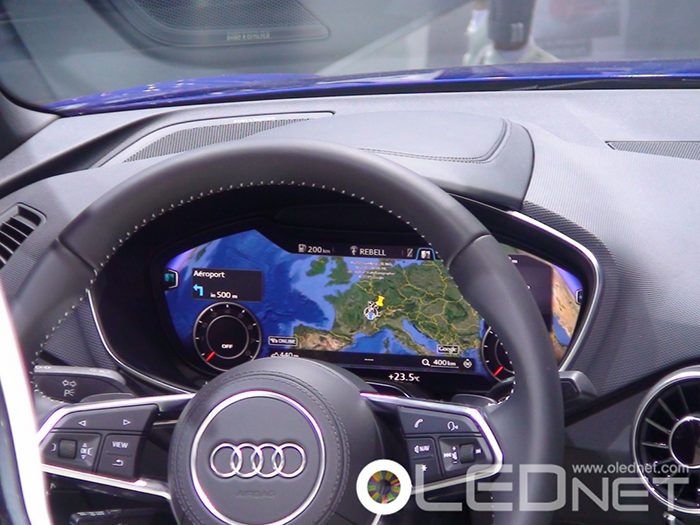
Audi Q7 3.0 TDI quattro , 2015 Geneva International Motor Show
Samsung Display Shows OLED/LCD Confidence in IMID
/in 미분류 /by OLEDNETIn IMID Display 2015 Business Forum (October 14 – 15), Samsung Display Vice President Hak Sun Kim gave a presentation titled ‘New Experience with Large Screen LCD/OLED’ and discussed Samsung Display’s technological points and strategy regarding OLED and LCD.
Kim emphasized that in the current large area display panel market LCD and OLED should be approached through different points of view and strategies; LCD requires additional value on top of existing technology and OLED should develop a new market that LCD cannot reach.
At present, LCD is catching up to OLED in large area panel through diverse technology development. Kim revealed that the key factors in large area LCD panel are immersion and realism. Immersion can catch up to OLED through curved technology, and realism can be matched through contrast increasing technology.
Regarding OLED, Kim mentioned transparent and mirror OLED display, developed by Samsung Display, as examples and stressed that future display’s worth when switched off will become important. Different from LCD, OLED’s transmittance and emitting areas can be separated and increase the transmittance value above that of LCD; when applied to transparent display, adequate transmittance can be achieved. Additionally, when used as mirror display, OLED’s transmittance and reflectance act independently which makes it more suitable in application compared to LCD where the two act in inverse proportion.
In this IMID Display exhibition, Samsung Display presented 55inch ultra-slim UHD curved TV, transparent, and mirror OLED display simultaneously. It is estimated that Samsung Display will continue their 2-track strategy where they reveal both OLED and LCD in different applications. On October 14, Dong-gun Park, CEO of Samsung Display, announced that they will strive to continue leading the market through unrivaled OLED and LCD technology prowess.
LG전자, OLED TV로 승부수 던지다.
/in 미분류 /by OLEDNETLG전자가 OLED TV에 대한 공격적인 마케팅을 본격적으로 시작했다.
LG전자는 10월 14일부터 16일까지 진행되는 IMID 전시회에서 OLED 비교 체험존을 설치해 OLED TV와 LCD TV를 한눈에 비교할 수 있게 하였다. OLED와 LCD의 직접적인 비교 전시는 WIS 2015에 이은 2번째 전시이며, 이번 IMID 2015 전시회에서는 LG전자의 2015년형 신제품인 55inch UHD LCD TV와 55inch UHD OLED TV를 직접 비교했다. 이는 앞으로 LCD TV보다 OLED TV에 힘을 실어 시장을 공략하겠다는 LG전자의 의지로 비쳐진다.
LCD TV는 BLU를 통해 빛을 비추기 때문에 완벽한 black 구현이 힘들다. LG전자는 이번 IMID 2015 비교체험존을 통해 완벽한 블랙, 완벽한 시야각, 초슬림 디자인이 가능한 OLED TV의 장점들을 강조했다.
LG전자는 OLED TV 출시 후 다양한 전시회에서 OLED TV의 장점을 강조하는 전시를 지속해왔지만 최근에는 자사의 최신 LCD TV와 비교하여 전시할 정도로 OLED에 중점을 둔 공격적인 홍보를 이어가고 있다. 반면 경쟁사인 삼성은 OLED와 LCD 각각을 다른 application에 적용해 시장에 공개하는 2-track 전략을 고수하고 있어 앞으로의 대면적 TV 시장의 판도가 어떻게 변할지 업계의 관심이 쏠리고 있다.

2015 IMID 전시회, OLED 비교 체험존, LG디스플레이
Solution process OLED panel, LCD보다 저렴하게 제작 가능
/in 미분류 /by OLEDNET유비산업리서치에서 14일 발간한 “2015 Solution Process OLED Report”에 따르면 “Solution process로 55inch OLED panel을 현재 양산되고 있는 WRGB 방식의 OLED panel보다 약 43% 저렴하게 제작할 수 있다.”라고 분석했다.
보고서에서는 “2015년도 2사분기 기준 55inch UHD OLED panel 가격과 수율을 기준으로 분석한 수치로서 현재 55inch UHD LCD panel의 제조 원가보다는 약간 높게 나타났다. 하지만 solution process OLED의 구조가 단순화 될 것이라는 점과 backplane과 encapsulation 수율이 개선될 수 있는 점을 고려해보면 LCD panel보다 저렴하게 제조할 수 있을 것”이라고 덧붙이며 solution process OLED가 대면적 OLED panel의 가격경쟁력을 확보할 수 있는 대안이 될 것이라고 밝혔다.
Solution process는 대면적 OLED panel을 Gen8 이상의 장비에서 원장 분할 없이 RGB pixel 구조로 제조할 수 있는 기술이며 주요 AMOLED panel 업체에서 적극적으로 개발을 진행 중에 있다.
하지만 solution process에 적용되는 발광재료는 기존 증착재료를 ink화를 시키기 위해 solvent를 섞기 때문에 증착재료보다 순도가 낮아 발광효율이 떨어지고 수명이 낮을 수 밖에 없다. 그럼에도 불구하고 solution process를 주요 panel 업체들에서 적극적으로 개발하고 있는 이유는 color filter를 사용하지 않고 발광재료 사용효율이 높으며 WRGB방식의 OLED panel에 비해 구조가 단순하기 때문에 원가절감을 할 수 있다는 점이다.
Solution process를 적용한 OLED panel은 Panasonic에서 가장 적극적으로 개발을 진행해왔으며 CES와 IFA에서 여러 차례 공개한 적이 있다. BOE와 AUO도 ink-jet 장비를 이용한 solution process OLED panel을 공개한 바 있으며 CSOT에서도 기술개발 방향을 solution process로 검토 중에 있다. AMOLED 산업의 선두주자인 Samsung Display와 LG Display에서도 적극적으로 개발을 진행 중이다. LG Display는 Gen8 ink-jet 장비를 도입하였으며 Samsung Display도 ink-jet 장비업체들을 중심으로 solution process OLED panel 개발에 본격적으로 착수한 상태이다.
Panel 업체뿐만 아니라 재료와 장비업체들도 solution process 기술개발과 상용화에 앞장서고 있다. Kateeva와 Sumitomo Chem., Merck와 Seiko Epson은 기술 협업을 맺었으며 DuPont는 soluble OLED 재료 생산시설 규모를 늘리고 가동을 시작했다고 최근 밝힌 바 있다.
이처럼 solution process 기술 개발과 상용화에 panel 업체뿐만 아니라 주요 재료, 장비업체들이 참여함에 따라 solution process OLED panel 시장은 빠른 시일 내에 성장할 것으로 기대된다.
“2015 Solution Process OLED Report”에서는 solution process OLED panel 시장이 2018년부터 본격적으로 양산되기 시작하여 2020년 약 US$ 2,329 million 규모로 성장할 것으로 전망했다.
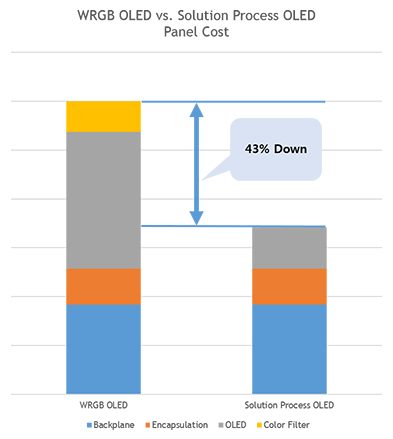
삼성디스플레이, IMID에서 OLED/LCD에 대한 자신감 드러내다.
/in 미분류 /by OLEDNET10월 14일 열린 IMID 2015 비즈니스 포럼에서 삼성디스플레이의 김학선 부사장은 ‘New Experience with Large screen LCD/OLED’라는 제목의 강연을 통해 OLED와 LCD 분야에서 축적해온 삼성디스플레이의 기술력에 대한 포인트와 전략에 대하여 발표하였다.
김 부사장은 현재 대면적 디스플레이 패널 시장에서 LCD와 OLED는 다른 관점과 전략을 가지고 접근해야 한다고 강조하며 LCD는 기존 기술에서 추가적인 가치를 부여해야 하고 OLED는 LCD가 할 수 없는 시장을 개척하는 방향으로 나아가야 된다고 밝혔다.
현재 LCD는 대면적 panel에서 다양한 기술 개발로 OLED의 성능을 따라잡고 있다. 김 부사장은 대면적 LCD panel에서 가장 핵심적인 요소는 몰입감과 현실성이라고 밝히며 몰임감은 커브드 기술을 통해, reality는 명암비를 높이는 기술을 통해 OLED의 기능성을 따라잡을 수 있다고 발표하였다.
OLED와 관련해 김 부사장은 삼성디스플레이에서 개발한 투명, 미러 OLED 디스플레이를 예로 들며 앞으로의 디스플레이는 꺼져있을 때 어떤 가치를 지니느냐가 매우 중요해질 것이라고 강조하였다. OLED는 LCD와 달리 투과영역과 발광영역이 분리가 가능하여 투과율을 LCD보다 높일 수 있어 투명 디스플레이로 활용했을 때 충분한 투과율을 달성할 수 있다. 또한, 미러 디스플레이로 사용될 때도 OLED는 투과율과 반사율이 독립적으로 작용하기 때문에 투과율과 반사율이 반비례 관계에 있는 LCD보다 적용이 용이하다고 발표하였다.
삼성디스플레이는 이번 IMID 전시회에서 55인치 초슬림 UHD 커브드 TV와 투명, 미러 OLED 디스플레이를 동시에 전시하였다. 삼성디스플레이는 앞으로도 OLED와 LCD 각각을 다른 application에 적용해 시장에 공개하는 2-track 전략을 고수할 것으로 전망된다. 박동건 삼성디스플레이 사장은 14일 IMID 전시회에서 “삼성디스플레이가 보유한 OLED와 LCD에 대한 독보적인 기술력으로 앞으로도 지속적으로 시장을 선도하기 위해 노력하겠다.”라고 말했다.
Solution process OLED 핵심이슈는?
/in 미분류 /by OLEDNET10월 7일 서울 the K 호텔에서 개최된 2015 Display Printed Electronics Seminar에서 단국대 진병두 교수와 한국 화학 연구원 이재민 박사는 각각 인쇄공정 OLED/PLED 소자 기술적 이슈와 용액공정 OLED 소재 기술 동향이라는 주제로 solution process OLED의 핵심 이슈를 되짚는 시간을 가졌다.
진병두 교수는 현재 solution process에 사용되는 재료 중 red, green는 효율과 수명 측면에서 많은 진보가 이루어졌지만 blue는 효율과 수명이 다른 두 색보다 낮다고 지적하며 red와 green만큼의 효율과 수명을 가지지 못한다면 blue 구현뿐만 아니라 white 구현이 힘들기 때문에 제대로 된 panel의 성능을 발휘하기 힘들다고 발표하였다.
이재민 박사는 진공증착 OLED는 재료의 합성과 정제만으로 재료 부분의 연구 개발이 가능한 반면, solution process OLED는 어떻게 잉크화를 시킬 것이냐에 대해서도 고려해야 한다고 밝히며 이런 이유로 재료 업체와 잉크화 관련 업체 사이에 다양한 collaboration이 나오고 있다고 발표하였다.
이 날 진병두 교수와 이재민 박사는 solution process OLED 기술의 핵심은 재료 특성 개발에 있다고 입을 모았다. Sumitomo Chem.과 DuPont에서 발표한 soluble 발광재료의 특성에 따르면 red와 green 재료 특성은 증착공정 OLED를 빠르게 따라잡고 있지만 blue 재료 특성은 이에 못 미치고 있는 것으로 나타났다. 이런 단점에도 불구하고 solution process OLED는 Gen8이상의 장비에서 대면적 OLED panel을 RGB 방식으로 양산할 수 있는 주요 기술이기 때문에 앞으로도 solution process에 대한 지속적인 연구개발이 이루어질 전망이다.
삼성디스플레이의 AMOLED panel 공급 확대, AMOLED 산업 청신호?
/in 미분류 /by OLEDNET7일 삼성전자가 3분기 잠정실적을 발표했다. 공시한 매출액과 영업이익은 각각 51조원, 7조 3,000억원이다. 이는 지난 분기 대비 매출액(48조5,400억원)은 5.07%, 영업이익(6조 9,000억원)은 5.8% 증가한 규모로 업계의 예상실적을 많이 뛰어넘은 수치이다.
지난해 동기 대비해서 영업이익은 무려 79.80%나 증가했으며, 지난해 4사분기부터 4분기 연속 오름세를 이어가고 있다. 특히 디스플레이 사업 부문이 시장 전망치를 크게 웃도는 수치가 될 것으로 예상되면서 이번 실적 상승에 주요인으로 평가되고 있다.
이러한 디스플레이 사업의 호조에 큰 영향을 준 요인은 삼성전자에서 출시하는 중저가형 스마트폰 라인에 AMOLED panel이 적용되고 중국 등 다른 국가의 set 업체에서 AMOLED panel을 적용한 제품 출시가 급증하는 등 삼성디스플레이의 공격적인 고객층 확보로 인한 보급형 AMOLED panel 수요량 증가가 영향이 큰 것으로 분석된다.
또한 이러한 수요량 증가로 삼성디스플레이의 가동률이 증가하였으며, 발광재료 업체들의 실적 개선에도 큰 영향을 끼칠 것으로 전망된다.
LGD로 가는 LG화학의 OLED 조명사업, 앞으로의 향방은?
/in 미분류 /by OLEDNETLG화학의 OLED 사업부가 LG Display로의 통합이 결정된 것으로 알려졌다. OLED lighting panel 시장 개화에 가장 앞장섰던 LG 화학의 OLED lighting business가 LG Display로 통합되게 되면서 앞으로의 OLED lighting 산업에 큰 변화가 있을 것으로 전망된다.
이번 통합으로 긍정적인 점은 LG Display가 이미 보유하고 있는 OLED panel 양산 라인과 인력, 기술력을 바탕으로 OLED lighting panel의 양산성을 더욱 향상시킬 수 있을 것으로 예상된다. 또한 OLED lighting panel 양산라인의 신규투자를 진행할 때도 LG Display가 보유하고 있는 장비/재료 supply chain을 바탕으로 시간과 비용을 절감할 수 있다.
반면 OLED lighting 시장은 아직 초기단계로 시장규모가 크지 않기 때문에 LG Display에서 신규투자의 여부가 관건이다. 일반적으로 조 단위의 시장을 바라보고 투자를 하는 디스플레이 패널기업의 특성상 OLED lighting panel 신규라인 투자가 LG Display의 입장에서 큰 메리트는 없을 것으로 예상된다.
따라서 LG Display에서 OLED lighting panel 사업을 진행을 한다면 첫 시작은 OLED lighting panel 양산라인 신규투자보다 파주의 AP2 line 일부에서 양산을 먼저 시작 할 것으로 예상된다. AP2 line의 일부에서 먼저 양산을 시작한다면 신규투자를 하는 것보다 양산시점을 훨씬 앞당길 수 있고 OLED lighting panel 시장 확대에 긍정적인 영향을 끼칠 것으로 예상된다.
문제는 마케팅전략이다. 초창기 삼성전자가 “아몰레드” 마케팅으로 AMOLED smartphone 시장을 push전략으로 열었듯이 LG Display도 OLED lighting panel 사업에서 이윤을 남기기 위해서는 push 마케팅 전략을 통해 OLED lighting panel 시장을 열어야 할 것으로 분석된다.
제 17회 OLED World Summit이 개최된다.
/in 미분류 /by OLEDNET제 17회 OLED World Summit이 10월 27일부터 29까지 San Francisco, CA에서 개최된다. 이번 conference는 OLED의 산업전략과 재료, 기술을 연구하는 200명의 조명과 디스플레이 산업 전문가들이 참석할 예정이다. 이번 OLED World Summit 2015의 프로그램은 산업리더들에게 혁신을 위한 완벽한 포럼을 제공할 것으로 보인다.
OLED World Summit은 다양한 컨텐츠 뿐만 아니라 참석자들에게 많은 인적 네크워크의 기회를 제공하며, 특히 OLED 시장에서의 주요 인사들과 컨택할 수 있는 기회를 제공할 예정이다. 또한, 화요일 저녁에 열리는 리셉션에서는 와인과 오르되브르를 즐기면서 Acuity Brand의 시설을 견학할 수 있으며, 수요일 저녁에 열리는 리셉션에서는 Claremont 호텔 클럽과 스파에서 동료나 산업 리더들과 담화를 나눌 수 있다.
OLED World Summit 관계자에 따르면 conference 기간 중 ‘Preeminent Technical Event’를 가장 오래 진행할 예정이라고 밝혔다..
TAG Heuer, $1,800 가격의 스마트워치를 공개하다.
/in 미분류 /by OLEDNET현지 시각으로 9월 29일, TAG Heuer의 CEO인 Jean-Claude Biver는 11월 9일 뉴욕 LVMH빌딩에서 안드로이드 기반의 스마트워치를 공개할 예정이라고 CNBC뉴스에 밝혔다. 공개된 스마트워치의 가격은 $1,800이다.
이 스마트 워치의 이름은 ‘Carrera 01’로, 프랑스 명품 브랜드인 LVMH의 가장 큰 시계 제작사인 TAG Heuer에 의해 생산된다. 또한 Google의 안드로이드 OS가 장착되며 Intel과 협력하여 제작된다. Biver는 Intel과 Google이 TAG Heuer의 첫 스마트워치를 위한 최고의 파트너라고 말했다. 또한 그는 스마트워치가 기존 명품 시장을 바꿀 것이라고 하며 Apple과 Hermes의 협업을 긍정적인 사례로 본다고 밝혔다.
Biver는 “$1,800에 이 스마트워치를 판매한다는 것에 대해 조금 염려스러운 점은 있다. 하지만 Apple의 사례로 볼 때 $1,500 이나 그 이상의 가격에 팔아도 될 것이라는 확신을 가지게 되었다.”라고 말했다.
또한 그는 TAG Heuer가 Apple을 쫓아가지 않고 스위스의 시계 산업을 공략할 것이라고 밝혔다.
듀폰디스플레이, 앞으로의 TV 시장을 위한 OLED 재료 시설 가동 발표
/in 미분류 /by OLEDNET지난 9월 30일(현지시간), 듀폰디스플레이는 대면적에 적용할 수 있는 용액공정용 OLED 재료에 대한 생산시설 규모를 늘리고 가동을 시작했다고 발표했다.
듀폰의 OLED재료는 OLED 디스플레이를 더 밝고, 더 선명하고, 지속 시간도 길면서 현재 OLED TV 패널보다 저렴하게 개발할 수 있도록 설계되었다. 새로 가동을 시작한 시설은 듀폰의 본사 소재지 미국 Wilmington 근처인 Newark의 DuPont Stine-Haskell 연구센터에 있다.
듀폰디스플레이의 글로벌 사업부장인 Avi Avula는 “OLED 재료는 OLED TV 성능에 매우 중요한 요소이다. 듀폰이 현재 시장에서 가장 뛰어난 용액공정 OLED 재료를 가지고 있다.”고 말했다. 또한 “우리의 비전은 OLED가 디스플레이의 표준이 되는 것이고, 이를 실현시키기 위해서는 2020년까지 대면적 OLED TV용 패널단가를 $ 1,000 이하로 생산하는 것에 초점을 맞추고 있다.”고 덧붙였다.
한편 듀폰디스플레이는 올해 용액공정 재료 성능으로 red 효율은 22 cd/A, green은 70 cd/A, blue는 5.5 cd/A를 표했으며, 이는 증착 재료에 비해 각각 76%, 82%, 11% 수준이다.
TAG Heuer to Unveil Smartwatch Worth $1,800
/in Set /by OLEDNETOn September 29 (local time), the TAG Heuer CEO, Jean-Claude Biver, told CNBC news that they will unveil their Android-powered smartwatch on November 9 at the LVMH building in New York. The announced price for the connected watch is $1,800.
The watch, Carrera 01, is produced by TAG Heuer, French luxury group LVMH’s biggest watchmaker, using Google’s Android OS in a venture with Intel. Biver told CNBC that could not have had better partners than Intel and Google for their first smartwatch. He also revealed he loved the Apple-Hermes deals because it showed that the smartwatch has cracked the luxury market.
“We were a little bit concerned about the price, because we’re going to sell it at $1,800 … and now we are quite reassured because Apple is telling us we can sell at $1,500 or even more,” he said. “I’m very, very pleased.”
Biver also told CNBC that TAG Heuer would not try to chase Apple but instead chase Swiss watch industry.
DuPont Displays Opens OLED Materials Scale-Up Facility for Next Generation TVs
/in 미분류 /by OLEDNETOn 30 September (local time), DuPont Displays announced the opening of a state-of-the-art, scale-up manufacturing facility designed to deliver production scale quantities of advanced materials that enable large-format, solution-based printed OLED displays.
These materials are designed to help manufacturers develop OLED displays that are brighter, more vivid, longer lasting and significantly less expensive than the OLED TVs on the market today. The facility is located at the DuPont Stine-Haskell Research Center (Stine-Haskell) in Newark, Del., near DuPont’s global headquarters in Wilmington, US.
DuPont’s new scale-up facility is sized to meet the future growth expectations of the OLED TV industry, which analysts predict will increase by over 70 percent for the next several years and will require large quantities of highly sophisticated OLED materials. This new OLED facility at Stine-Haskell has large-scale formulation systems and can support simultaneous production of multiple product lines.
“Materials are critical to the performance of an OLED TV and we are confident that DuPont has the best performing solution OLED materials available in the market today,” said Avi Avula, global business director, DuPont Displays. “Our vision is that OLEDs will become the display standard and to make that vision a reality, we are focused on helping our customers bring the cost of large sized OLED TVs down to less than $1000 by 2020.”
LG UHD OLED TV Price Falls Once More
/in Market /by OLEDNETThe price of OLED TV by LG Electronics is falling fast. The 55inch flat UHD OLED TV (55EF9500), released last month, fell to $3,999 in 3 weeks, a 27% decrease from the initial $5,499. This price decrease is much faster than that of LG Electronics’ curved model of 55inch UHD OLED TV released in April.
Samsung Electronics’ 55inch SUHD TV, UN55JS9000, showed approximately over $2,500 price difference in comparison with 55EF9500 between the 1st week and the 2nd week of September. However, in the 3rd week, UN55JS9000 and 55EF9500 each showed 4% and 15% of decrease rate to record $2,497 and $3,999 respectively, with approximately $1,500 difference. This is the highest reduction rate for LG Electronics’ OLED TV.
In addition to the price reduction, LG Electronics is marketing their products aggressively. They are in the process of installing OLED TV this month in 39 key airports in 23 countries including the US, Germany, and Russia, with plans to install approximately 200 units of OLED TV by the end of October.
LG UHD OLED TV가격, 또 하락
/in 미분류 /by OLEDNETLG전자의 OLED TV 가격이 빠르게 하락하고 있다. 지난달 출시한 55인치 Flat UHD OLED TV(55EF9500)는 출고가 $ 5,499에서 3주만에 27% 하락한 $ 3,999를 기록했다. LG전자가 출시한 55인치 UHD OLED TV 중 4월에 출시한 Curved 모델보다 월등히 빠른 속도로 하락했다.
삼성전자가 출시한 55인치 SUHD TV인 UN55JS9000는 9월 1주차와 2주차에는 55EF9500과 비교하여 약 $2,500 이상의 차이를 보였다. 하지만 3주차에 UN55JS9000과 55EF9500은 각각 주별 평균 하락률 4%, 15%를 보이며 $ 2,497, $ 3,999까지 하락하여 약 $ 1,500 차이를 기록했다. 기존 LG전자 OLED TV중 가장 높은 가격하락률이다.
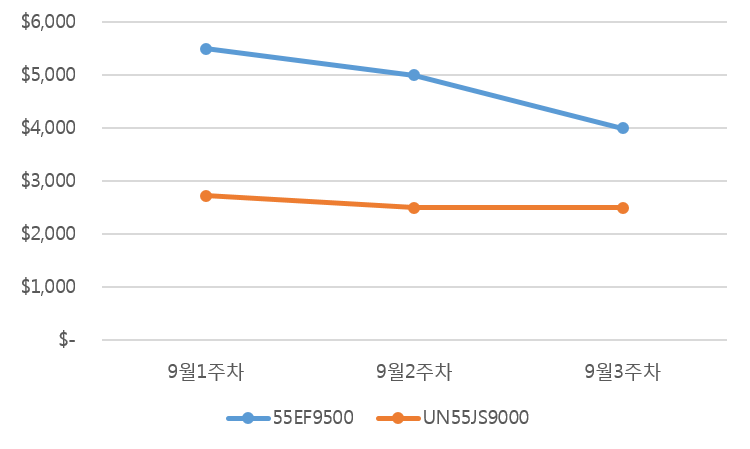
한편 LG전자는 가격 하락뿐만 아니라 마케팅도 공격적으로 하고 있다. 이달 들어 미국, 독일, 러시아 등 23개국 39개 주요 공항에 OLED TV를 설치하고 있다. 10월 말까지 200여 대의 OLED TV 설치하겠다는 계획이다
The 17th Annual OLEDs World Summit
/in Others /by OLEDNETThe 17th annual OLEDs World Summit, located just outside of San Francisco, CA is taking place October 27-29. This conference will bring together over 200 experts from across the lighting and display industries to examine the materials, technology, and strategies needed to push broader OLED use. The OLEDs World Summit 2015 program provides the perfect forum for industry leaders to exchange ideas.
In addition the dynamic content, the OLEDs Word Summit provides attendees with numerous networking opportunities that allow you to connect with key decision makers in the OLEDs marketplace. The OLEDs World Summit features networking opportunities such as a Tuesday evening reception where attendees can tour Acuity Brands Facility while enjoying wine & hors D’oeuvres and a Wednesday evening reception at the Claremont Hotel Club & Spa where you’ll be able to continue conversations with colleagues and industry leaders.
Don’t miss the longest-running, preeminent technical event dedicated exclusively to the OLEDs industry! Register today to take advantage of special pricing!
LG디스플레이, OLED TV 최고화질 평가 받아
/in 미분류 /by OLEDNETLG디스플레이의 OLED TV가 미국 디스플레이 전문가 그룹 디스플레이메이트(DisplayMate)로 부터 최고 화질이라는 극찬을 받았다.
22일(미국 동부시간 기준), 디스플레이메이트는 자사 홈페이지에 ‘최신 OLED TV와 LCD TV 기술 대결(Flagship OLED and LCD TV Display Technology Shoot-Out)’이라는 제목의 포스팅으로 UHD해상도의 65인치 OLED TV와 LCD TV 화질 비교 평가결과를 공개했다.
디스플레이메이트의 비교평가는 현재 시판되고 있는 UHD해상도의 65인치 최신 OLED TV(모델명: 65EG9600)와 LCD TV(모델명: UN65JS9500)를 대상으로 밝기와 명암비, 색정확도 및 선명도, 시야각, 화면반사 등 화질평가 전부분에 걸쳐 이뤄졌다.
특히 이번 평가 결과는 디스플레이 전문기관이 이례적으로 대화면 분야에서 차세대 디스플레이 주도권을 놓고 경쟁관계에 있는 OLED와 LCD를, 그것도 LG와 삼성의 시판중인 하이엔드 제품을 직접비교 평가했다는 점에서 많은 외신과 전문매체의 관심을 받고 있다.
디스플레이메이트의 레이몬드 소네이라(Raymond M. Soneira)박사는 테스트 총평에서 “LG디스플레이의 OLED 패널을 채택한 UHD해상도의 65인치 OLED TV는 비교대상인 LCD TV를 모든 화질 테스트 항목에서 압도했다”며, “OLED TV는 완벽한 화질과 최고의 정확도를 가진 TV로 지금까지 테스트한 제품 중 최고의 화질과 성능을 보여준다”고 극찬했다.
반면 UHD해상도의 65인치 LCD TV에 대해서는 “백라이트를 원하는 곳에만 켜주는 로컬디밍(Local Diming)기술과 색재현율을 높이는 양자점(Quantum Dot)필름 등 첨단 기술을 적용했으나 이것들이 제대로 작동하는 경우는 정면에서 시청할 때뿐”이라며 VA(Vertical Alignment)기술이 적용된 LCD TV의 시야각 문제를 제기했다.
즉 VA방식의 LCD TV는 정면에 형성된 최적점(Sweet Spot)이 존재해 이 영역에서만 봐야 화질 손상이 가장 적은 반면, 이 부분을 조금이라도 지나쳐서 화면을 볼 경우 화질 손상이 심각하게 나타난다는 것이다.
이러한 시야각 문제는 OLED TV의 경우 시청각도에 상관없이 색재현율과 색차, 밝기 등의 변화가 거의 없는 반면, LCD TV는 시청 각도에 따라 현격한 변화가 일어나 화질 손상과 색상 표현의 왜곡을 초래하게 된다.
실제로 항목별 화질평가에서 시야각에 따른 휘도 변화의 경우 OLED TV는 정면 대비 45도에서의 휘도 유지율이 82%인 반면 LCD TV는 51%로 급격히 하락했다.
또한 색재현율의 경우 OLED TV는 정면(0도)과 측면(45도)에서의 측정값이 106%와 113%로 오차가 거의 없으나 LCD TV는 화소와 화소사이에 빛이 간섭하는 혼색문제로 106%에서 62%로 급감하는 결과를 보였다(영화모드 기준).
OLED TV는 시야각뿐만 아니라 화질기술의 화두로 떠오르는 HDR(High Dynamic Range) 구현에 있어서도 LCD TV대비 월등한 성능을 보였다.
UHD 시대에 필수적인 화질기술로 떠오르고 있는 HDR은 어두운 곳은 더욱 어둡게, 밝은 곳은 더욱 밝게 표현하는 기술이다. 예를 들어 밤하늘의 별과 같은 영상을 표현할 경우 OLED TV는 국소적으로 밝은 영역의 휘도를 정확히 표현한 반면, LCD TV는 백라이트의 한계로 밤하늘을 강조할 경우 별빛이 어두워지고 별빛을 강조할 경우 밤하늘의 블랙이 제대로 표현되지 못하는 한계를 보인다.
실제로 디스플레이메이트 실험결과 밤하늘의 은하수를 표현하는 정도인 APL(Average Picture Level: 전체화면 중 흰색 화면의 면적) 1%의 화면에서 OLED TV는 433nit의 밝기로 표현할 수 있으나 LCD TV는 226nit밖에는 구현할 수 없는 것으로 나타났다(선명모드기준).
이외에도 OLED TV는 빠른 응답속도로 화면 끌림이 전혀 없으며 외부 조명에 대한 반사율이 1.2%에 불과해 조명과 태양광의 영향이 큰 가정환경에서도 선명한 화질을 구현하는 것으로 나타났다. 이는 반사율이 2.2%인 LCD TV 에 비해 2배 가량 우수한 결과다.
디스플레이메이트의 평가 결과로 LG디플레이의 OLED TV는 ①자발광으로 완벽한 블랙을 구현하고, ②정확한 색 표현으로 왜곡 없는 완벽한 화질을 자랑하며, ③어느 각도에서도 색 바램이 없는 동일한 컬러를 표현하고, ④ 빠른 응답속도로 끌림 없는 선명한 화면을 보여주며, ⑤높은 디자인 유연성으로 투명과 플렉서블 등에 최적화된 미래형 디스플레이로 차원이 다른 기술이라는 점이 다시 한번 입증되었다.
LG디스플레이 프로모션담당 이정한 상무는 “이제 OLED TV는 그 어떤 디스플레이 기술과도 비교할 수 없을 만큼 완벽한 화질을 자랑한다”며, “OLED TV가 지닌 궁극의 화질을 많은 고객과 소비자가 경험할 수 있도록 글로벌 체험 마케팅을 강화할 계획”이라고 말했다.
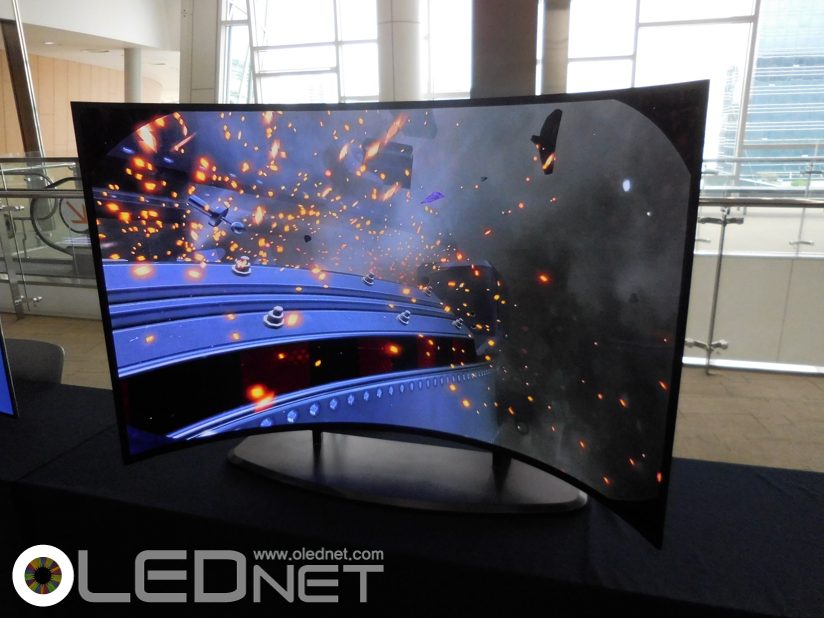
LG Curved OLED TV, IMID 2015
[IAA 2015] Audi and Porsche, Propose Future Models of Smart Car
/in Exhibition, Lighting /by OLEDNETAt IAA 2015 (September 17 – 27), Audi and Porsche presented OLED lighting and display equipped vehicles.
In the past, Audi has proved OLED technology’s excellence through diverse models and demonstrations, including introduction of ‘swarm’ in 2013 with its 3D OLED car rear lighting panels. At this motor show, Audi revealed Audi e-tron quattro, the first concept car with Matrix OLED technology. As well as the Matrix OLED lighting, interior OLED display was also applied to the concept car. Audi explained that the Matrix OLED lighting, which was applied to the rear lighting, can continuously change lights and does not cast shadow. Full OLED interface was also applied to the car and all functions required in driving can be control by display touch. Audi revealed that they will gradually apply these technology to next generation Audi series.
Porsche presented their first four-seat electric sports car Mission E as a concept model. The instrument cluster for this concept car is displayed virtually in OLED. The menu can be activated through buttons on the handle. It can also be automatically activated as the cluster’s eye tracking system can perceive the driver’s attention. The display also follows the seat position and body attitude of the driver in what is known as a parallax effect; the display moves according to the driver’s posture for easier viewing. Porsche revealed that Porsche Car Connect technology will also be applied which will allow the user to control key functions of the vehicle through a smartphone.
As OLED using lighting and display are actively applied to smart cars, attention on the automotive OLED is also increasing. At the National Research Development Industry General Workshop, held in July 2015, Samsung Display and LG Display each stated their thoughts on display that will be applied to future smart cars.
Samsung Display’s executive director Hye Yong Chu asserted that smart is display’s future, including smart car. She also explained that for the actualization of smart technology, other ancillary smart technology, such as eye tracking and voice recognition technology, are required.
Yoon Sooyoung, LG Display’s vice president, stated that automotive display can be used for CID, dashboard, cluster, and window, and that the development of transparent and flexible technology is necessary.
During the keynote session of IMID 2015, Munhyun Kim of Hyundai Motors revealed that OLED panels will mainly be applied to smart car compared to LCD as it can easily be flexible. He also added that the automotive OLED’s percentage within the total OLED market will increase, and anticipated that it will exceed 30% in 2017.
[IAA 2015] Audi와 Porsche, 미래의 스마트카의 모델을 제시하다.
/in 미분류 /by OLEDNET17일부터 독일에서 개최된 2015 프랑크푸르트 모터쇼(IAA 2015)에서는 Audi와 Porsche가 OLED 조명과 디스플레이를 도입한 차량을 선보였다.
Audi는 과거 다양한 모델과 시연을 통해 OLED 기술의 우수성을 입증한 바 있다. 특히 2013년도에는 3차원 입체 OLED 디스플레이 기능을 가진 ‘SWARM’을 선보이기도 했다. 이번 모터쇼에서 Audi는 매트릭스 OLED 기술이 최초로 적용된 컨셉트카인 ‘Audi e-tron quattro’를 공개하였다. 컨셉트카에는 매트릭스 OLED lighting과 내부 OLED 디스플레이가 적용되었다. 매트릭스 OLED lighting은 후미등에 적용되었으며, Audi 측은 이 기술이 조광을 끊임없이 변화시킬 수 있으며 그림자를 발생시키지 않는다는 장점을 가지고 있다고 밝혔다. 또한 콘셉트카에는 풀 OLED 인터페이스가 적용되어 자동차 운행에 필요한 모든 기능들을 물리적인 버튼 없이 디스플레이 터치로 조작할 수 있다. Audi는 이번 콘셉트카의 기술들을 차세대 Audi 시리즈에 점차적으로 적용될 예정이라고 밝혔다.
Porsche는 이번 모터쇼에 Porsche 최초의 4인승 전기 스포츠카인 ‘Porsche Mission E’라는 이름의 컨셉트카를 공개하였다. 이 컨셉트카의 클러스터에는 OLED display가 장착되어 가상이미지로 정보가 표시된다. 운전자는 핸들에 장착된 버튼을 조작해 원하는 메뉴를 활성화할 수 있으며 클러스터가 운전자의 시선을 감지하는 아이트래킹 시스템이 있어 메뉴가 자동으로 활성화되기도 한다. 또한 디스플레이부에는 좌석의 형태와 운전자의 자세에 따라 변형되는 패럴랙스 효과도 구현하였다. 운전자의 자세의 높이에 따라 원형 게시판이 반응하여 운전자가 잘 볼 수 있도록 움직인다. Porsche 측은 스마트폰을 통해 차량의 주요 기능 설정이 가능하게 하는 ‘Porsche Car Connect’ 기술도 함께 적용할 것이라고 밝혔다.
이렇게 OLED를 이용한 조명과 디스플레이가 스마트카에 본격적으로 도입되면서 차량용 OLED에 대한 관심도 높아지고 있다. 삼성디스플레이와 LG디스플레이는 2015년 7월에 개최된 디스플레이 국가연구개발사업 총괄 워크샵에서 각각 미래 스마트카에 적용될 디스플레이에 대한 의견을 피력하였다.
삼성디스플레이의 추혜용 전무는 디스플레이의 미래는 스마트라고 밝히면서 스마트카도 그 중 하나라고 발표하였다. 또한 이런 스마트 기술들이 실현되려면 아이트래킹 기술과 음성인식 기술 등 부수적인 스마트 기술들도 뒷받침 되어야 된다고 밝혔다.
LG디스플레이의 윤수영 상무는 차량용 디스플레이는 CID, dash board, cluster, window에 활용될 수 있으며, 이를 위해서는 투명과 플렉서블 기술의 발전이 필수적이라고 발표하였다.
8월 19일 IMID 2015의 keynote session에서 현대자동차의 김문현 상무는 LCD 패널보다는 플렉시블 구현이 용이한 OLED 패널이 미래의 스마트카에 주로 적용될 것이라고 밝히며 전체 OLED 시장 중 자동차용 OLED의 비중은 증가할 것으로 전망되며 2017년에는 30%이상이 될 것으로 기대하였다.
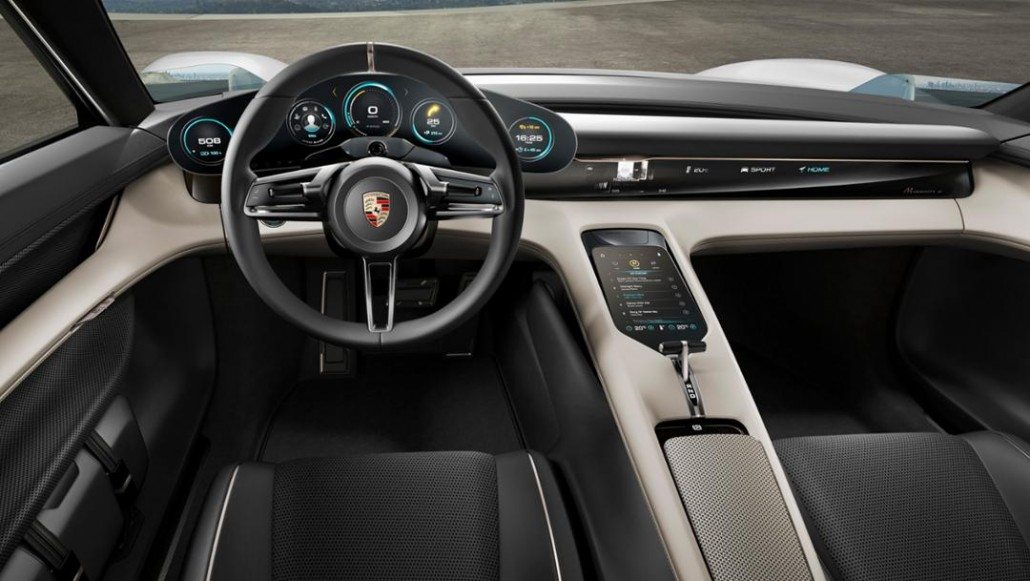
Porsche Mission E, Porsche Home page
Q2 AMOLED Market, the Largest So Far
/in Market /by OLEDNETAccording to UBI Research’s Weekly OLED Analysis Report, Q2 AMOLED panels recorded the largest shipment and sales so far. With 56 million units, the Q2 shipment increased by 35% in comparison with Q1, and a 19% increase compared to the same period last year. US$ 2,800 million was recorded for sales, which is a 65% increase compared to its previous quarter.
Last quarter’s AMOLED market growth is due to Samsung Display’s AMOLED panel supply volume for Chinese set companies and increase in LG Display’s flexible OLED panel production for smartwatch.
2사분기 AMOLED 시장, 역대 최대
/in 미분류 /by OLEDNET유비산업리서치의 [Weekly OLED Industry Analysis Report]에 의하면 2사분기 AMOLED 패널 출하량과 매출이 역대 최대 규모인 것으로 나타났다. 2사분기 출하량은 56백만대로서 1사분기 대비 35% 증가하였고, 지난해 동 분기 대비 19% 성장을 달성하였다. 매출액은 28억달러로서 전 분기 대비 65% 성장이다.
지난 분기 AMOLED 시장이 성장한 것은 삼성디스플레이의 중국 세트 업체용 AMOLED 패널 공급량과 LG디스플레이의 스마트 워치용 flexible OLED 패널 생산량 증가에 따른 것이다.
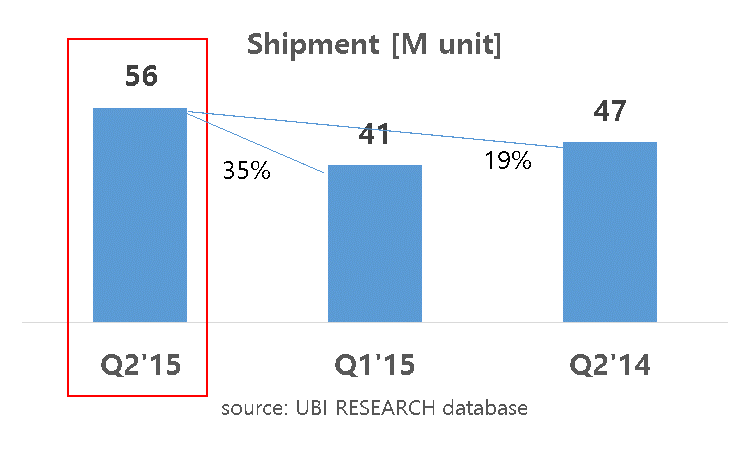
2사분기 AMOLED 출하량
Hon Hai Precision, Actively Participating in AMOLED Panel Business?
/in 미분류 /by OLEDNETOn September 9, Tera Semicon Corporation announced the agreement with Taiwan’s Hon Hai Precision to supply AMOLED manufacturing equipment worth approximately US$ 79,000 million*. Tera Semicon mainly supplies OLED crystallization equipment for poly-Si and curing equipment
Hon Hai Precision is a world leading manufacturing company that began as an electronics component manufacturing company in the 1970s and became a contract manufacturer in the 2000s. Hon Hai Precision is better known to consumers as its subsidiary company as well as its trade name, Foxconn.
Hon Hai Precision has been consistently preparing for OLED panel production. Hon Hai Precision’s subsidiary company Innolux took over Chimei, which has technology to mass produce OLED, and in 2013 announced plans to establish OLED R&D center in LCD factory operated jointly with Sharp. Additionally, in September 2014, Hon Hai Precision mentioned that they will actively begin flexible AMOLED panel development aiming to mass produce in 2016.
This order for Tera Semicon Corporation is analyzed to be in consideration of Apple’s application of flexible AMOLED panel for iPhone series. Apple is Hon Hai Precision’s best client; of the total manufacturing products iPhone occupies 18% and iPad 17%.
At present, Samsung Display and LG Display are the only companies capable of flexible AMOLED panel mass production, with AUO and Japan Display perhaps joining the ranks in the next 2-3 years. With this Hon Hai Precision AMOLED manufacturing equipment order, heated competition for flexible AMOLED panel supply is expected.
*1 USD = 1,100 KRW
LG Display Opens 2015 Tech Forum in Collaboration with Other Companies
/in Others /by OLEDNET
LG Display set out to discover new technology through open innovation in collaboration with other companies.
On September 15, LG Display invited top global display material and component companies to Paju factory and opened 2015 LG Display Tech Forum. The invited companies included Merck, Asahi Glass, and Sumitomo.
Under the heading of ‘OLED, New Opportunity and Challenge’, 13 key collaborating companies in material, process, glass, and circuitry sectors participated. They promised to share market trend, and LG Display’s OLED and LCD technology development direction and cooperate regarding future technology.
LG Display increased emphasis on OLED; LG Display revealed detailed business strategy for large and small size OLED, and discussed technology and products that should be developed together in collaboration with companies in each stage.
Additionally, LG Display newly established Technology Innovation Award for collaborating companies that contributed to LG Display’s product improvement with innovative technology. The award was presented to Asahi Glass for developing glass light guide panel used in thin panel actualization, and display material companies Merck and Nitto Denko.
LG Display’s CEO Han Sang-beom explained that LG Display could pave the way for OLED with world’s first technology due to much effort and enthusiastic corporation from R&D partners. He also entreated each company to continue to change and evolve through their own R&D competitiveness and creativity and lead the future display market.
Hon Hai Precision, AMOLED 패널 사업에 본격적으로 뛰어드나
/in 미분류 /by OLEDNET9월 9일 테라세미콘은 대만 Hon Hai Precision과 87억5056만원 규모의 AMOLED용 제조장비 공급계약을 체결했다고 공시했다. 테라세미콘은 OLED 장비 중 poly-Si를 결정화하는 장비와 curing 장비를 주로 취급하는 기업이다.
Hon Hai Precision은 1970년대 전자부품 생산업체로 출발하여 2000년대부터 위탁생산을 전문적으로 하는 세계 최대 제조 전문 기업이다. 일반인들에게는 자회사이면서 Hon Hai Precision의 상호인 Foxconn으로 더 유명하다.
Hon Hai Precision은 OLED 패널 생산을 꾸준히 준비해왔다. OLED 양산 능력을 가지고 있는 Chimei를 자기업인 Innolux에서 인수하였으며, 2013년 Sharp와 함께 운영하는 LCD 공장에 OLED R&D 센터를 준공할 계획을 발표하였다. 또한 2014년 12월에는 flexible AMOLED panel 개발에 본격적으로 착수할 것이며 2016년 양산을 목표로 한다고 언급한 바 있다.
이번 Hon Hai Precision의 테라세미콘 장비오더는 Apple의 iPhone series에 적용될 것으로 예상되는 flexible AMOLED panel 제작을 본격적으로 염두해 두고 있는 포석으로 분석된다. Apple은 Hon Hai Precision의 최대 고객으로 특히 전체 생산 제품 중 아이폰은 18%, 아이패드는 17%의 비중을 차지하고 있다.
현재 flexible AMOLED panel을 양산할 수 있는 업체는 Samsung Display와 LG Display가 유일하며,향후 2~3년 내에 공급 가능할 것으로 예상되는 업체도 AUO와 Japan Display정도로 예상된다.이번 Hon Hai Precision AMOLED 장비 발주를 통해 앞으로의 flexible AMOLED panel 공급을 놓고 치열한 경쟁이 벌어질 것으로 전망된다.
LG디스플레이, 협력사와 함께하는‘2015 테크포럼’개최
/in 미분류 /by OLEDNET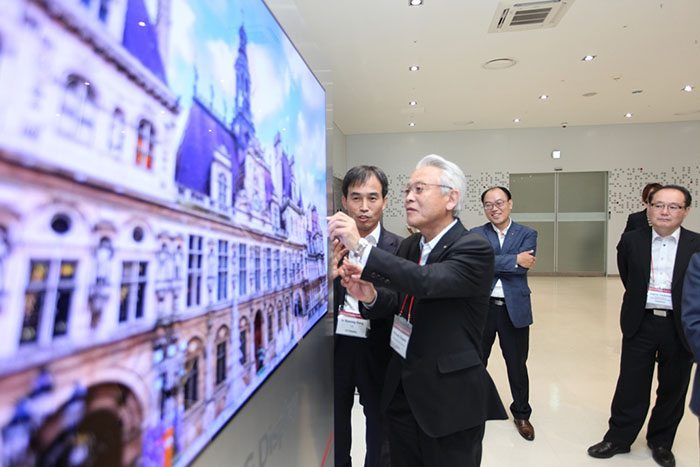
LG디스플레이가 협력사와 함께 ‘오픈 이노베이션(개방형 혁신)’을 통한 미래 신기술 발굴에 나선다.
LG디스플레이는 15일 머크(Merck), 아사히 글라스, 스미토모(Sumitomo) 등 디스플레이 소재 및 부품 각 분야에서 세계 최고의 경쟁력을 갖춘 글로벌 협력사를 파주공장에 초청해 ‘2015 LG디스플레이 테크 포럼(Tech Forum)’을 개최했다.
‘OLED, 새로운 기회와 도전’이라는 주제로 열린 이번 포럼에는 재료, 공정, 글라스, 회로 분야 13개 주요 협력사가 참여해 시장동향과 LG디스플레이의 OLED 및 LCD 기술 개발 방향을 공유하고 미래기술에 대한 변함없는 협력을 다짐했다.
특히 LG디스플레이는 이번 테크포럼에 OLED 비중을 크게 높여 대형과 소형에 따른 OLED 구체적인 사업전략을 발표하며, 각 사업 단계 별로 협력사와 함께 개발해 나가야 할 기술과 제품에 대해 논의했다.
아울러 LG디스플레이는 이번 테크포럼부터 ‘테크놀로지 이노베이션 어워드(Technology Innovation Award)’를 신설, 혁신적인 기술로 LG디스플레이의 제품 성능 향상에 기여한 협력사에게 포상했다. 이에 박형 패널 구현을 위한 글라스 도광판을 개발한 아사히 글라스를 비롯 디스플레이 소재 업체인 머크와 니또덴코가 혁신적 기술을 인정받아 수상의 영예를 안았다.
한상범 사장은 이날 테크포럼에서 “LG디스플레이가 세계 최초의 기술로 OLED 역사를 새롭게 써 갈 수 있는 것은 R&D 파트너사의 값진 노력과 적극적인 협조가 있었기 때문이다”며, “앞으로도 각 사가 갖고 있는 R&D 경쟁력과 창의성을 바탕으로 끊임없이 변화하고 발전해 미래 디스플레이 시장을 지속적으로 이끌어 가자”고 당부했다.
AIXTRON Supplies R&D Encapsulation Equipment OPTACAP
/in 미분류 /by OLEDNETOn 9 September, AIXTRON, a deposition equipment production company, revealed that they supplied encapsulation equipment OPTACAP to a major Asian display maker.
OPTACAP encapsulation is a research equipment that handles substrates size of 200mm x 200mm. AIXTRON revealed that this was ordered in the third quarter in 2015 and is scheduled to be delivered in the first quarter of 2016. The OPTACAP’s PECVD technology enables the deposition of barrier film used in TFE process of OLED display, OLED lighting, organic photovoltaic and flexible electronic device.
CTO (chief technology officer) of AIXTRON, Andreas Toennis, said, “thin-film encapsulation is an essential step within the OLED manufacturing process. Therefore, we are delighted to be able to provide an innovative solution to the industry which delivers excellent barrier films at high throughput. Therefore, this solution contributes to a significant reduction of manufacturing costs for the critical encapsulation process step within the production of flexible as well as rigid OLED devices”.
In April 2015, AIXTRON acquired PlasmaSi, located in Silicon Valley in order to develop OPTACAP encapsulation technology.
AIXTRON, R&D용 encapsulation 장비 OPTACAP 공급
/in 미분류 /by OLEDNET증착장비 생산 기업인 AIXTRON은 9월 9일 OPTACAP라는 이름의 encapsulation 장비를 아시아 주요 디스플레이 생산 업체에 공급했다고 밝혔다.
OPTACAP encapsulation 장비는 200 mm x 200 mm size이며, R&D에 활용될 것으로 밝혔다. AIXTRON사는 “이 장비가 2015년 3분기에 주문되었으며 2016년 1분기에 출하될 예정이다. 또한 OPTACAP 장비의 PECVD 기술을 통해 OLED 디스플레이와 OLED 조명, 유기 광전지 등의 제조 공정 중 TFE에 사용되는 barrier film을 증착할 수 있다”라고 발표하였다.
AIXTRON SE.의 CTO(최고 기술 책임자)인 Andreas Toennis는 “TFE는 OLED 제조공정에서 필수적인 과정으로 AIXTRON는 고품질의 barrier film을 빠르게 형성하는 공정에 대한 솔루션을 개발하였다. 이 솔루션은 rigid OLED뿐만 아니라 flexible OLED의 핵심적인 공정인 encapsulation 과정에 들어가는 생산 단가를 크게 감소시켜줄 것으로 기대된다.“라고 말했다.
한편 OPTACAP encapsulation 기술을 개발하기 위해 AIXTRON은 2015년 4월, 실리콘밸리에 위치되어있는 회사인 Plasma Si를 인수한 바 있다.
General Class AMOLED Panel Estimated to be Extensively Supplied. How Will it Affect OLED Industry?
/in 미분류 /by OLEDNETOnly 2 models of smartphone with the general class AMOLED panel were released in the first 2 quarters of 2015. However, as 5 more models were revealed until August in the third quarter, it is expected that demand for general class AMOLED panel will gradually increase.
Currently 7 companies, including Samsung Display, are mass producing or aiming to mass produce small to medium-sized AMOLED panel of rigid type. China’s EDO or Taiwan’s AUO are believed to be producing in small quantity for samples. Other Chinese companies are also aiming to mass produce AMOLED panel but satisfying the current demand is analyzed to be difficult. At present, Samsung Display is the only panel company that can meet the demand for general class AMOLED panel by set companies. There is much interest in whether AMOLED industry can rebound with the Samsung Display’s movement in the second half.
It is expected that Samsung Display will increase operation rate of A1 and A2 rigid lines in the second half in order to meet the demand for general class AMOLED panel. Following this, emitting material companies’ sales increase is also anticipated and positively affect management of AMOLED industry’s ecosystem.
If the demand for general class AMOLED panel is higher than expected, there are some who believe that additional investment for A3 line could be for hybrid structure that can switch between rigid and flexible rather than flexible exclusive line.
There is much focus on how Samsung Display’s mass production and supply plans for general class AMOLED panel will affect the AMOLED industry growth.

General Class AMOLED Panel Applied Smartphone Released Until August 2015
OLED TV, Pay Attention to China and UHD
/in Exhibition /by OLEDNETIFA 2015 that opened on September 4, closed its curtains on 9. This year’s IFA was similar to IFA 2014 in terms of diverse OLED TV exhibition, but when analyzed in detail there were several differences.
First, the emphasis on UHD TV greatly increased. The percentage of UHD resolution of exhibited OLED TV was approximately 71% in IFA 2013, and 70% in IFA 2014. However, in IFA 2015, the percentage increased to approximately 92%. If the main theme for IFA 2014 was curved OLED TV products, UHD was the keyword for IFA 2015.
Another important factor is increasing participation by Chinese companies. In IFA 2013, only Haier exhibited OLED TV but this increased to 2 companies, Changhong and TCL, in IFA 2014. In IFA 2015, 3 companies, Haier, Changhong, and Skyworth, presented OLED TV. It is estimated that the OLED TV exhibition attendance by Chinese electronics companies will continue to consistently increase.
There is much attention on how many more Chinese companies will participate with OLED TV in IFA next year, and whether a new keyword following UHD will appear. Although IFA 2015 ended, OLED TV market continues to move.
보급형 AMOLED panel 공급 본격화 예상, OLED 산업에 미칠 영향은?
/in 미분류 /by OLEDNET2015년 1사분기와 2사분기에 출시된 보급형 AMOLED panel을 적용한 스마트폰은 2종에 불과했지만 3사분기에 들어서며 8월까지 5종이 공개되어 보급형 AMOLED panel에 대한 수요가 점차적으로 증가할 것으로 전망된다.
현재 rigid type의 중소형 AMOLED panel을 양산 또는 양산을 목표로 하고 있는 업체는 Samsung Display등 7개 업체이다. 중국의 EDO나 대만의 AUO는 샘플수준으로 소량 생산을 하고 있는 것으로 알려져 있고 다른 중국 panel 업체들도 올해 AMOLED panel 양산을 목표로 하고 있지만 당장의 수요를 충족시키기에는 어려울 것으로 분석된다. 보급형 AMOLED panel을 요구하는 set 업체들의 수요를 충족시킬 수 있는 panel업체는 현재 Samsung Display가 유일하다. 따라서 하반기 Samsung Display의 움직임에 AMOLED 산업이 다시 한번 탄력을 받을 수 있을지 기대를 모으고 있다.
Samsung Display는 보급형 AMOLED panel의 수요를 맞추기 위해 하반기 A1과 A2 rigid line의 가동률을 끌어 올릴 것으로 예상되며 이에 따라 발광재료 업체들의 재료 매출 증가도 기대되어 AMOLED 산업의 eco-system 유지에 긍정적인 영향을 미칠 것으로 전망된다.
또한 보급형 AMOLED panel의 수요가 예상보다 높아질 경우 A3 line에 대한 추가 투자가 flexible 전용이 아닌 rigid와 flexible 전환이 가능한 hybrid 형식으로의 투자가 될 수 있다는 전망도 나오고 있다.
하반기 Samsung Display의 보급형 AMOLED panel 양산과 공급 계획에 따라 AMOLED 산업 성장에 탄력을 줄 수 있을지 기대된다.

2015년 8월까지 출시된 보급형 AMOLED panel이 적용된 스마트폰
OLED TV, China와 UHD에 주목하라.
/in 미분류 /by OLEDNET9월 4일에 개최된 IFA 2015가 9일 모든 일정을 마쳤다. 이번 IFA 2015는 다양한 OLED TV 제품이 전시되었고 큰 주목을 끌었다는 점에서 지난 IFA와 비슷했지만 구체적으로 분석하였을 때 몇 가지 차이가 있었다.
먼저, UHD TV의 비중이 크게 늘었다. IFA 2013에서는 전시된 OLED TV의 약 71%가, IFA 2014에서는 약 70%가 UHD 해상도였다면 IFA 2015에서는 약 92%가 UHD 해상도의 OLED TV를 전시했다. 작년 IFA 2014가 curved OLED TV 제품 전시가 주류를 이루었다면 IFA 2015의 키워드는 UHD라고 볼 수 있다.
또한 중국업체의 참여가 늘어간다는 것도 주목해야 할 점이다. IFA 2013에서 Haier 단 한 업체만이 OLED TV를 출품하였지만, IFA 2014에서는 Changhong, TCL 두 업체가 참여했으며, IFA 2015에서는 Haier, Changhong, Skyworth 세 업체가 OLED TV를 전시하였다. 중국 전자 업체들의 OLED TV 전시 참가는 지속적으로 상승할 것으로 전망된다.
내년 IFA에서는 중국업체의 OLED TV 전시 참여 비중이 얼마나 더 늘어날지, UHD를 이은 새로운 OLED TV의 키워드가 등장할 지, 업계의 관심이 모아지고 있다. IFA 2015는 막을 내렸지만 OLED TV 시장은 지금도 끊임없이 움직이고 있다.
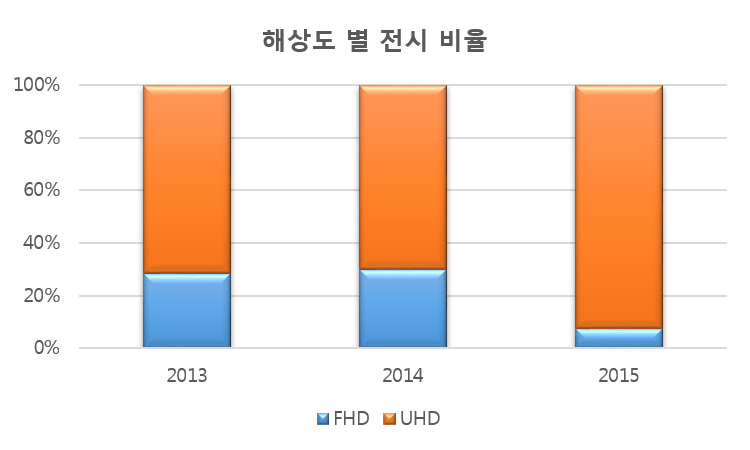
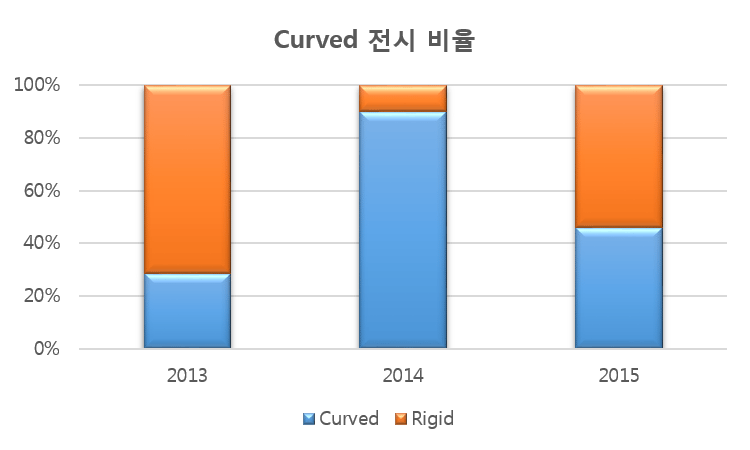
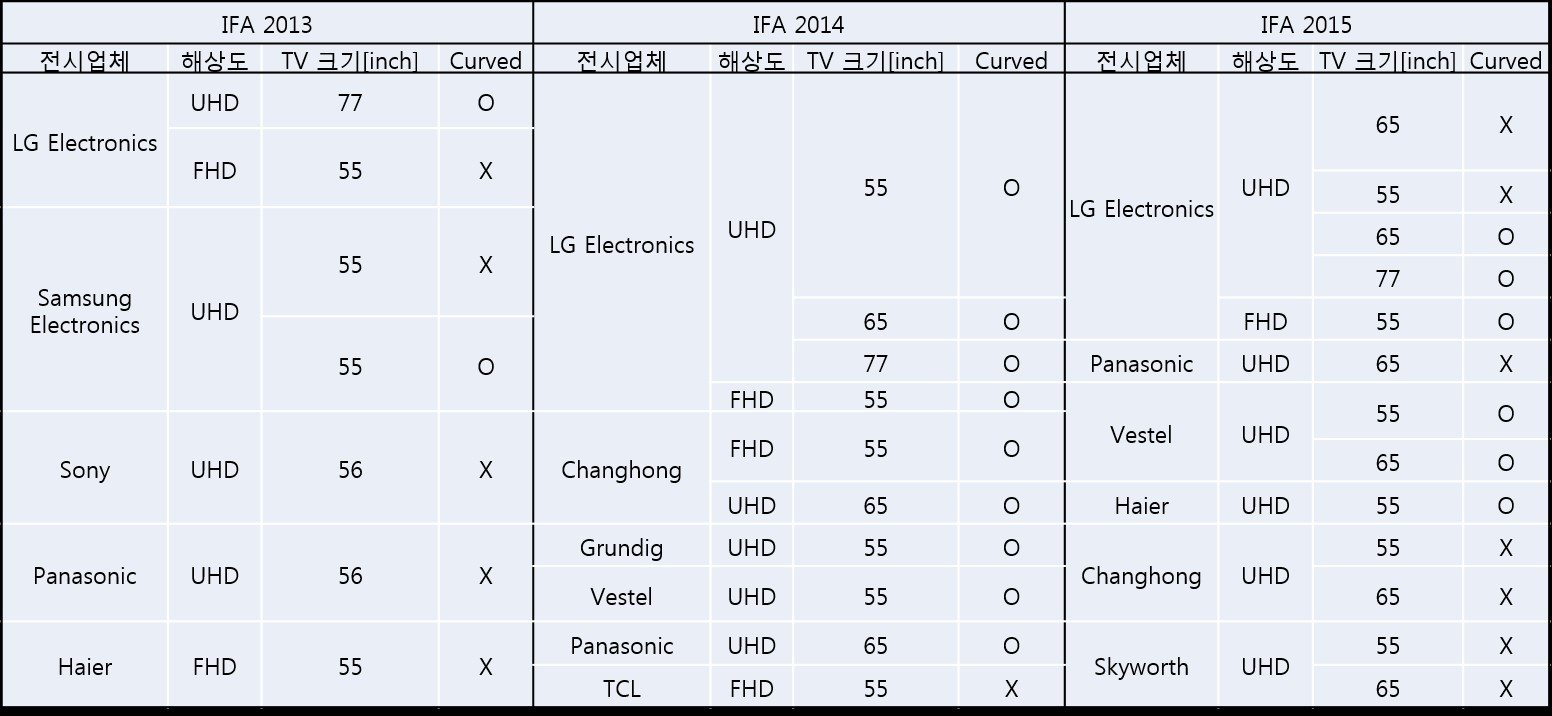
UBI Research Organizes ‘2015 Display Printed Electronics Seminar’
/in Display, Focus on /by OLEDNETThe Opportunity to Understand Printed Electronics Technology
For That Competitive Edge in Global Display Industry

At present there is an intense competition within display industry between countries such as China with aggressive investment, and Japan that is looking for a comeback. For Korea to possess that competitive edge in display industry, a seminar is being prepared. This seminar will provide the opportunity to learn about printed electronics technology that is becoming a key technology and understand latest technology trend.
UBI Research (http://www.ubiresearch.co.kr, President: Dr. Choong Hoon Yi), an OLED specializing company, announced that the 2015 Display Printed Electronics Seminar will be held on October 7. This seminar will take place at The K Seoul Hotel in Seocho-gu in Seoul with a group of key experts who will discuss latest technology development trend in display based on printed electronics.
Printing process or solution process is a new production technology that is the center of much expectation around the world. Dr. Kyung-Tae Kang, the head of printed electronics center of Korea Institute of Industrial Technology, will examine the current printed electronics industry and propose its future. Dr. Kang is also a secretary for IEC TC119 which was established to respond to the printed electronics industrialization.
At this seminar, Professor Yongtaek Hong of Seoul National University will explain technological issues that need to be considered when producing ultra-thin transistor device using printed electronics technology. The printed electronics technology is receiving much attention as it can be applied to flexible elastic substrate, and low temperature process through large area is possible.
Dongguk University’s Professor Yong-Young Noh will give a presentation on printed electronics technology’s development trend and research content for flexible display development.
Also, Dankook University’s Professor Byung Doo Chin will discuss OLED RGB printing technology trend review for efficiency and stability improvement of small molecule and polymer OLED device by solution process, and high resolution OLED technology that can be actualized through inkjet printing. This OLED RGB printing technology based on printing process is a subject of active research as a replacement for the current vacuum thermal evaporation; pixel formation is difficult for large area through this evaporation technique.
Furthermore, essential topics on printed electronics are covered by industry’s top experts.
- Technology Trend for Solution Process OLED Material (Dr. Jae-Min Lee, Korea Research Institute of Chemical Technology)
- Technology Trend for Electrode Material and Process for Printing (Dr. chan-Jae Lee, Korea Electronics Technology Institute)
- Blanket Application for Printed Electronics and Development Status (Dr. Noh-min Kwak, RPE Corporation)
- Printed Electronics R2R Equipment Technology Status
UBI Research will bring together top quality industry experts as speakers toward Korea’s leadership in display industry and host a place of networking where industry-academic professionals can meet. UBI Research seminars, previously held twice a year, will become a monthly event.
Seminar attendance application can be made through the UBI Research homepage (www.ubiresearch.co.kr).
Minus Growth for H1 OLED Material Market with Mere US$ 564 Million*
/in Market /by OLEDNETAccording to UBI Research, the 2015 H1 OLED material market recorded approximately US$ 564 million; this is a 14% increase compared to 2014 H2, but a 24% decrease against 2014 H1.
Despite reports that Samsung Electronics and LG Electronics are selling much larger volumes of flexible OLED applied Galaxy S6 Edge and OLED TV respectively compared to last year, the OLED material market is gradually stagnating.
The main reason for this OLED material market’s downward turn is Samsung Display’s operation level which remained stationary at 50% in H1. This led to stationary material usage compared to the year before. LG Display is producing flexible OLED and large size OLED panel for TV. However, approximately only 100,000 units of OLED panels were sold in H1 and material usage was also lowl. The current capa. is 34K but as the OLED material cost spent in H1 is approximately US$ 36 million, the operation rate is analyzed to be only 30% of the total capa.
The OLED material market is decreasing because the supply price is rapidly falling without increase in production volume. OLED material companies are frustrated at the 10-15% price decrease per quarter. At present, as the only clients are Samsung Display and LG Display, material companies are compelled to reduce the price as the failure to do so could lead toward the termination of business. OLED material companies spend several thousands of millions of dollars annually on development to meet constant improvement demanded by clients. There is much difficulty for OLED material companies as display companies continue with one-sided demands without compensation regarding development cost.
For OLED industry to maintain its continued growth, it requires more than success of panel companies. Material companies that play a pivotal part within the industry have to continue development and production of quality materials in order to create a healthy growth cycle. However, display companies are destroying the ecosystem.
What OLED material companies currently crave is for Chinese display companies to mass produce OLED panels as soon as possible.
* 1 USD = 1,100 KRW
유비산업리서치, ‘2015 Display Printed Electronics Seminar’ 개최
/in 미분류 /by OLEDNET- 국가간 치열한 경쟁의 장이 펼쳐지고 있는 디스플레이 분야에 경쟁력 확보를 위한 인쇄전자 기술을 파악할 수 있는 세미나 장 열려…
- 유비산업리서치, ‘2015 Display Printed Electronics Seminar’ 개최

최근 디스플레이 분야는 중국의 공격적 투자와 재역전을 노리는 일본 등 국가간 치열한 경쟁이 일고 있다.
이에 한국의 디스플레이 분야 경쟁력 확보를 위해 필수 기술로 떠오르고 있는 인쇄전자 기술에 대해 알아보고 최신 기술 동향을 파악할 수 있는 세미나 장이 마련된다.
‘디스플레이 전문 기업’ 유비산업리서치(http://www.ubiresearch.co.kr, 대표 이충훈)는 10월 07일(수) 서울 서초구에 소재한 The K Seoul Hotel에서 핵심 전문가 집단을 모시고 인쇄전자 기반의 디스플레이에 대한 최신 기술 개발 동향에 대해 다루는 ‘2015 Display Printed Electronics Seminar’를 개최한다고 밝혔다.
인쇄공정 또는 용액공정은 세계적으로 많은 기대를 받고 있는 새로운 제조기술이다. 인쇄전자의 산업화에 대응하기 위해 국제표준기구 IEC에서 설립한 TC119 국제 간사를 맡고 있는 한국생산기술연구원 강경태 인쇄전자 센터장이 ‘Printed Electronics 국제표준 동향 및 산업 전망’이라는 주제로 인쇄전자산업의 현재를 검토하고 미래를 제시할 예정 이다.
이 자리에서 서울대학교 홍용택 교수는 유연 신축성 기판에 적용 가능하며, 대면적으로 낮은 온도 공정이 가능하여 많은 관심을 받고 있는 인쇄전자 기술을 이용하여 박막트랜지스터 소자를 제작할 때 고려해야 하는 기술적인 이슈들에 대해 설명하고자 한다.
동국대학교 노용영 교수는 플렉서블 디스플레이 개발을 위한 인쇄전자기술의 개발동향 및 연구내용에 대해서 발표 한다.
아울러 단국대학교 진병두 교수는 현재의 진공 열증착 방식으로는 대면적화에 어려움을 갖고 있는 화소형성기술 문제에 있어, 그 대안 기술로 활발히 연구되고 있는 프린팅 공정 기반의 OLED RGB 인쇄기술에 대하여, 용액공정에 의한 저분자 및 고분자 OLED 소자의 효율 및 안정성 향상을 위한 기술동향 리뷰와 잉크젯 공정을 사용하여 구현할 수 있는 고해상도 OLED 기술에 대해 소개하고자 한다.
이 밖에도 ▲ 용액공정 OLED 소재 기술 동향 (한국화학연구원, 이재민 박사), ▲ 인쇄 공정용 전극 소재 및 공정 기술 동향 (전자부품연구원, 이찬재 박사), ▲ 인쇄전자용 블랑켓 적용 및 개발 현황 (알피이, 곽노민 대표), ▲ 인쇄전자 R2R 장비 기술 현황, 이 인쇄전자 분야 최고 전문가들에 의해 다뤄진다.
유비산업리서치는 연 2회 진행하던 세미나를 매월 개최하며, 디스플레이 전문 기업으로서 디스플레이 분야의 “1등 한국”을 위해 관련 분야의 최고의 전문가 들을 연사로 모시며, 산학연 관계자들이 한 자리에 모일 수 있는 최고의 네트워크 장을 마련할 예정 이다.
세미나 참가신청은 유비산업리서치 홈페이지(www.ubiresearch.co.kr)를 통해 할 수 있다.
[IFA 2015] The Return of the OLED King
/in Exhibition /by OLEDNETSamsung Electronics, the current global leader of smartphone market share, challenged Apple to dominate smartwatch market with Galaxy Gear 2 armed with latest functions.
The exterior of Gear 2 changed to round type. Previous Gear copied rectangular fashion watch, but Gear 2 returned to the classic design.
Gear 2 has the most basic circular shape, but the rotating bezel within the simple design boasts the perfect blend of digital and analog. The rotating bezel design used in stop watch in quality sports watch was applied to add a touch of analog. At the same time, the smartwatch has the digital side from the jog dial used in quality vehicles, merging the analog with digital.
Smartwatches until now had to be touched to change screen. However, Gear 2’s rotating bezel allows the screens to be changed easily through dial rotation.
Gear 2 applied flexible OLED produced by Samsung Display same as Gear with its 1.2inch size and 360×360 resolution. Compared to competitors’ 1.3inch, it might feel smaller but has the highest resolution; Samsung Electronics used a smaller display with better expressiveness. Particularly, absolute black, one of the advantages of OLED, is actualized with this product. The quality of black in previous Gear fell short and the screen wallpaper showed hints of blue. The new display shows that it is of OLED leader, Samsung family, with its brilliant colors using latest OLED materials.
Gear 2 also uses Tizen OS and firmly differentiated itself from other products. In fact, other products employed Google OS and had a problem of basically being the same under the different exterior leading to no particular differentiation factors for the consumers.
However, deserving the title of the leader of the smart device, Samsung Electronics utilized independently developed Tizen and boasted totally different interior.
Samsung Electronics is investing much effort in Gear 2 promotion; with the exclusive booth, visitors can examine diverse forms of Gear 2.
[IFA 2015] OLED TV’s Advantages from Skyworth’s Point of View
/in Exhibition /by OLEDNETIn IFA 2015 (September 4-9), Skyworth exhibited 65inch 4K OLED TV in 3 curved and flat sets each in order to emphasize OLED TV’s advantages. Skyworth presented an interesting booth by providing a large screen in the middle of the booth for the visitors to experience OLED TV playing the F1 racing game.
OLED TV is the best TV to show video with fast movements as it has fast response time of u/sec. As the video is not delayed, the viewers can enjoy the contents without afterimage. This fast response time cannot be actualized in LCD TV.
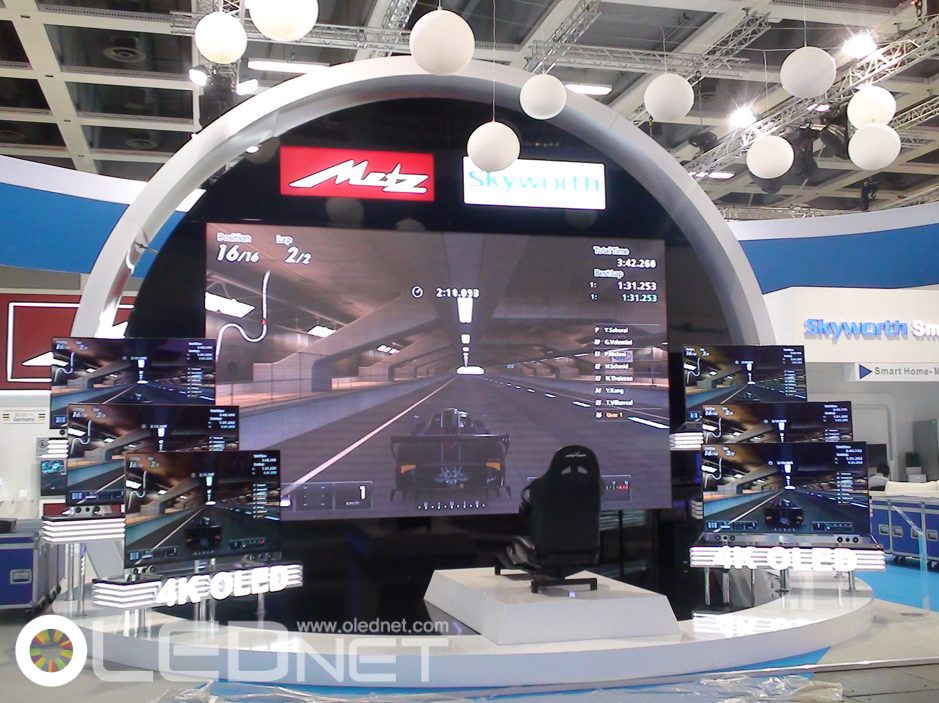
Skyworth booth, IFA 2015
[IFA 2015] Thin Panel Thickness, No Longer Limited to OLED
/in Exhibition /by OLEDNETThe thinness of OLED panels, achieved as OLED does not require backlight, is known as one of the big advantages of OLED. However, at IFA 2015, Sony proved that LCD can also be as thin as OLED.
The product, Perfect Wall-mounted 4K UHD TV, is an LCD TV but the thickness is mere 4.9mm. Compared to LG Electronics’ latest OLED TV’s 4.8mm, the thickness difference practically nonexistent.
In order to develop ultra-thin LCD TV, Sony placed backlight on the base and used glass type light guide.
상반기 OLED 발광재료 시장 2600억원에 불과한 마이너스 성장
/in 미분류 /by oled유비산업리서치에 따르면 올해 상반기 OLED 발광재료 시장 규모는 약 2600억원으로 전 반기대비 14% 상승했지만 전년 동기 대비 24% 감소했다.
올해에는 삼성전자가 flexible OLED를 탑재한 Galaxy S6 Edge를, LG전자에서는 OLED TV를 작년 보다 수십배 이상 판매하고 있다고 하지만 OLED 재료 시장은 점차 얼어 붙고 있는 실정이다.
OLED 재료 시장이 마이너스 성장으로 돌아 선 것은 무엇보다도 OLED 대표 기업인 삼성디스플레이의 상반기 가동율이 50% 수준에 머물러 재료 사용량이 전년 동 반기 대비 늘지 않았기 때문이다. LG디스플레이는 flexible OLED와 TV용 대형 OLED 패널을 생산하고 있지만 상반기 OLED 패널 판매는 약 10만대에 불과하여 재료 소모량 역시 얼마 되지 않는다. 전체 capa는 34K이지만 상반기 구매한 OLED 재료비는 약 400억원 정도에 불과하여 가동율이 전체 capa의 30%에 불과한 것으로 추정된다.
OLED 재료 시장이 줄어든 이유는 생산량 증가 없이 공급 가격만 심하게 깍이고 있기 때문이다. OLED 재료 업체들은 분기당 10~15% 가격이 인하되고 있다고 불만을 토로하고 있다. 현재로서는 수요 기업이 삼성디스플레이와 LG디스플레이 밖에 없는 실정이기 때문에 가격 인하에 불응하면 거래 자체가 단절될 수 있어 울며 겨자 먹기로 가격을 낮추고 있다. OLED 재료 업체들은 수요 기업들이 성능이 향상된 재료 개발을 끊임없이 요구하고 있어 연간 개발비가 수십억원 이상 소요되고 있지만 디스플레이 업체에서는 개발비에 대한 가격 보전 없이 일방적인 요구만 지속되고 있어 사업에 어려움이 심각하다.
OLED 산업이 지속 성장하기 위해서는 패널 업체만 살아서는 유지될 수 없다. 산업을 지탱하고 있는 한 축인 재료 업체들이 좋은 재료를 끊임없이 개발하고 생산해야지만 선순환 구조로 산업이 성장할 수 있다. 하지만 디스플레이 업체들은 생태계를 완전히 망가뜨리고 있다.
OLED 재료 업체들이 현재 가장 바라고 있는 것은 중국 디스플레이 업체들이 하루 속히 OLED를 대량으로 생산하는 것이다.
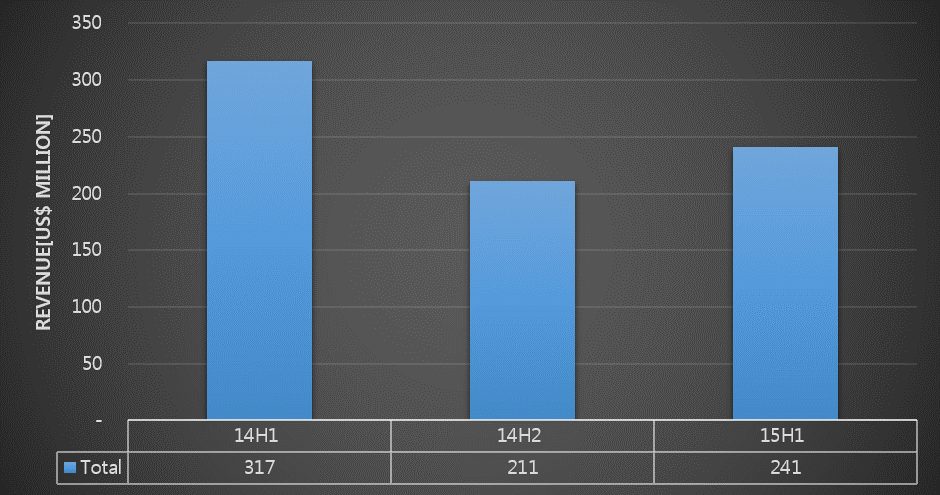
반기별 OLED 발광재료 시장 실적 2014H1~2015H1
[IFA2015] 스마트 제왕의 귀환
/in 미분류 /by OLEDNET스마트폰 시장 세계 점유율 1위를 차지하고 있는 삼성전자가 스마트 워치 시장을 장악하기 위해 최신 기능으로 무장한 Galaxy Gear2로서 Apple에 도전장을 던졌다.
Gear2의 외관은 라운드 타입으로 바뀌었다. 전작인 Gear에서는 사각의 패션 시계를 모방했으나 이번에는 전통적인 시계 모양으로 돌아왔다.

Galaxy Gear2, IFA 2015
Gear2가 가장 기본적인 둥근 형태로 제작되었지만 심플한 디자인 속에 숨어 있는 rotating bezel은 디지털과 아날로그 느낌을 기막히게 조화 시켰다. 고급 스포츠 시계에서 사용되는 스톱워치용 회전 베젤 디자인을 사용하여 아날로그 감각을 부여했으며, 동시에 고급 자동차에 장착되는 조그 다이얼의 디지털 감각을 부가해서 아날로그와 디지털 감각을 일체화 시킨 스마트 워치이다.
현재까지 출시되고 있는 스마트워치는 화면을 바꾸기 위해서는 화면을 터치하며 넘겨야 하는 불편함이 있었으나 Gear2의 rotating bezel은 다이얼 회전에 의해 쉽게 화면을 변경할 수 있도록 만들어졌다.
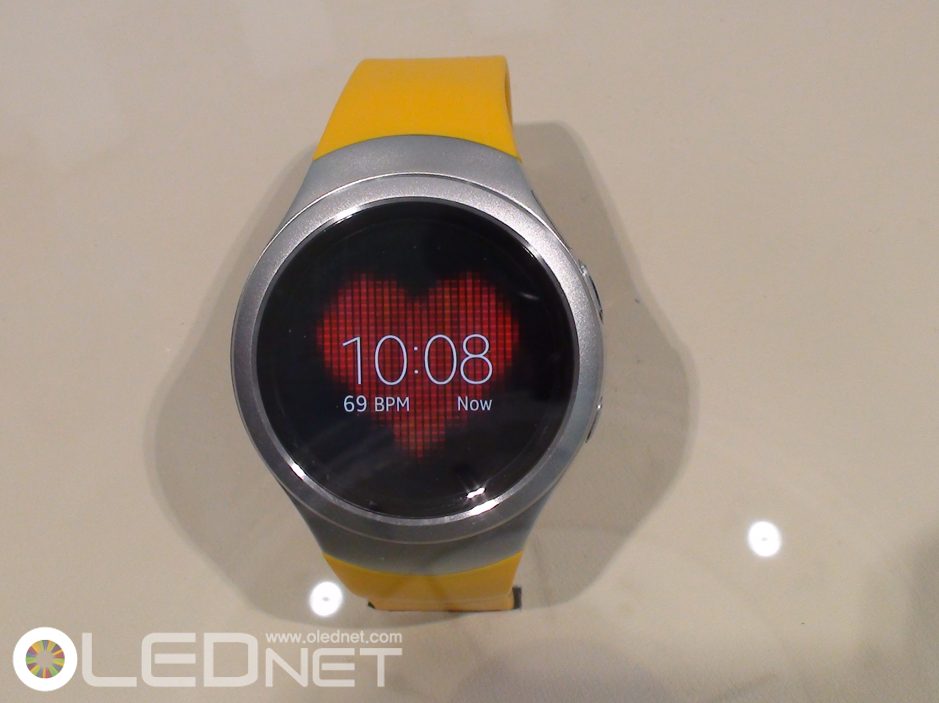
Galaxy Gear2, IFA 2015
Gear2는 Gear와 마찬가지로 삼성디스플레이에서 생산하는 flexible OLED를 사용했다. 디스플레이는 사이즈는 1.2인치이며 해상도는 360×360이다. 경쟁업체들은 1.3인치를 사용하고 있어 조금 작은 느낌이 있지만 해상도는 오히려 최고 수준이다. 크기는 작아도 표현력이 더 훌륭한 강력한 디스플레이를 사용했다. 특히 이번 제품은 OLED의 최고 특성인 black가 완벽하게 표현되고 있다. 전작인 Gear에서는 black 특성이 나빠 바탕 화면이 청색 빛깔을 띠었으나 이번에는 OLED를 사용한 것임을 알 수 있게 하였다. 최근에 개발된 OLED 재료들을 사용하여 색상이 매우 화려하여 OLED 종주 기업인 삼성가(家)의 혙통을 물려 받은 최고의 제품임을 알 수 있다,
삼성전자가 다시 도전장을 내민 Gear2는 타이젠 기반의 OS를 사용하고 있어 타 제품과의 차별화도 분명히 했다. 실제로 타 제품들은 Google의 OS를 사용하고 있어 외양은 다르나 속은 모두 동일하여 고객 입장에서는 차별성이 보이지 않는 문제점이 있었다.
하지만 삼성전자는 스마트 기기 최고 기업답게 독자적으로 개발한 타이젠을 사용하여 내부도 완벽히 새로 디자인하여 차별화하였다.

Galaxy Gear2 Booth, IFA 2015
IFA2015에서 삼성전자는 Gear2 홍보에도 많은 심혈을 기울이고 있다. 전용 부스를 마련하여 다양한 Gear2를 참관자들이 관람할 수 있도록 배려하고 있다.
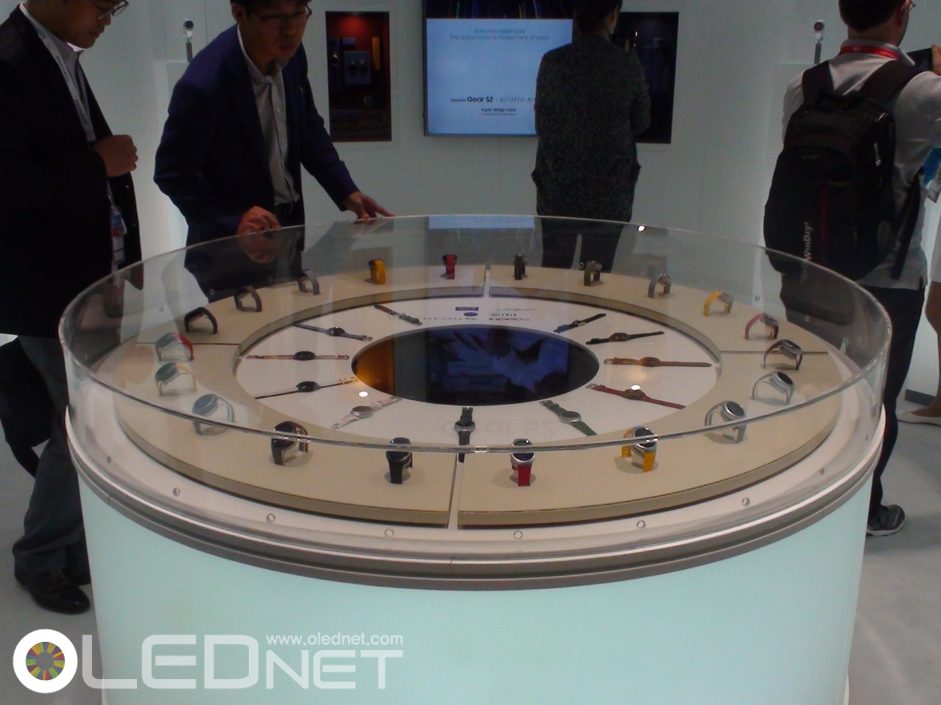
Galaxy Gear2 Booth, IFA 2015
[IFA 2015] Panasonic OLED TV
/in Exhibition /by OLEDNETPanasonic that used to lead Japanese electronics industry with Sony is focusing more on OLED TV industry. Until IFA 2014, Panasonic exhibited self-made OLED TV using oxide TFT and solution process OLED technology. However, since CES 2015 Panasonic presented LG Display’s WRGB OLED panel applied OLED TV. It is unusual to introduce OLED TV through IFA 2015 when Panasonic is only selling TV domestically and stopped TV business abroad. According to Panasonic the company is planning to mass produce within 2015.
OLED TV revealed in IFA 2015 is a CZ950 model with 4K resolution. It is interesting to note that special material is used to cover the back of the set to give a furniture look.
Panasonic is also presenting OLED TV and LCD TV in darkroom to demonstrate OLED TV’s superiority in contrast ratio.
[IFA2015] Skyworth가 생각하는 OLED TV의 장점
/in 미분류 /by OLEDNETIFA2015에서 Skyworth는 OLED TV 장점을 강조하기 위해 curved와 flat 65inch 4K OLED TV를 각각 3대씩 전시하고 가운데는 대형 screen을 준비하여 F1레이서 게임에서 OLED TV로 실감할 수 있는 재미있는 부스를 마련했다.
OLED TV는 응답속도가 u/sec로 빠르기 때문에 고속으로 움직이는 영상을 나타내기에 최적인 TV이다. 화면이 지연되지 않기 때문에 고속 화상을 자연스럽게 느낄 수 있다. LCD TV에서는 구현 할 수 없는 빠름이다.

Skyworth booth, IFA 2015
[IFA2015] 얇은 패널 두께, 더 이상 OLED의 전유물 아니다!
/in 미분류 /by OLEDNETOLED는 backlight를 사용하지 않기 때문에 항상 패널 두께가 얇게 만들 수 있음을 매우 큰 장점으로 알려져 있다. 하지만 이번 IFA2015에서는 LCD도 OLED 만큼 얇아질 수 있음이 Sony에 의해 확인되었다.
Perfect Wall-mounted 4K UHD TV라고 이름 붙은 이 제품은 LCD 패널로 만든 TV이나, 두께는 4.9mm에 불과하다. LG전자가 시판하고 있는 최신 OLED TV의 두께는 4.8mm인 것에 비교하면 LCD TV와 OLED TV 두께 차이가 없어졌다.
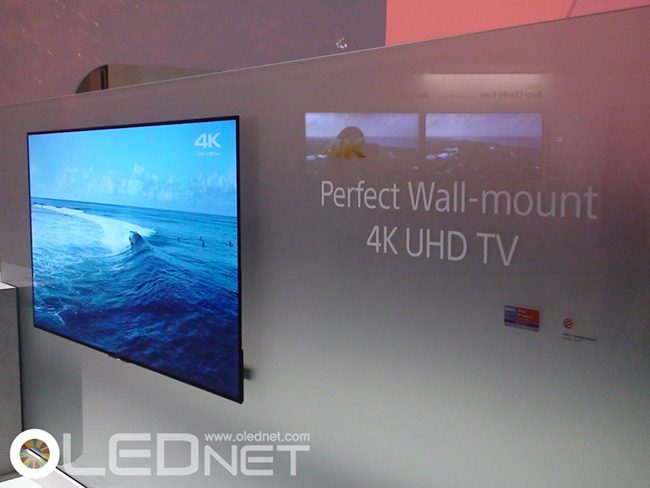
Sony Perfect Wall-mounted 4K UHD TV, IFA 2015
Sony는 초박형 LCD TV를 개발하기 위해 backlight를 하단에 배치하고 glass 방식의 light guide를 사용하고 있다.

Sony Perfect Wall-mounted 4K UHD TV, IFA 2015
[IFA 2015] Directions for LG Electronics’ OLED TV?
/in 미분류 /by OLEDNETDuring the media day event for IFA 2015 (September 4 – 9), LG Electronics introduced diverse products centering around OLED TV such as LCD TV, G4, and G Watch Urbane.
LG Electronics clearly confirmed that the ultimate TV for the company is OLED TV. At the company booth under the title of the Evolution of TV, LG Electronics revealed that the TV’s final destination is OLED TV.
At this exhibition, the OLED TV presentation theme returned to the flat design from HDT’s emphasis on black and previous curved design. Until now, curved design focused OLED TV were exhibited, but with the spotlight on flat design in IFA 2015, LG Electronics strongly hinted that future LG OLED TV will switch to flat products.
Competitors greatly improved contrast ratio through application of LCD TV and HDR. LCD’s basic contrast ratio is approximately 1,000:1, and in premium products currently being mass produced it has improved to 3,000:1. However, as OLED TV does not use backlight, the minimum contrast ratio is 100,000:1 with maximum of infinite contrast ratio. Through IFA 2015 LG Electronics is planning to actively release HDR technology applied products. In order to achieve this, the company will demonstrate HDR transmission with broadcasting companies such as BBC and publicize OLED TV’s black and white’s superiority over LCD TV.
LG Electronics provided ‘perfect color’, ‘perfect black’, and ‘perfect angle’ as the superior characteristics of OLED TV. These advantages are inherent characteristics that LG’s WRGB OLED TV can provide that show excellence over LCD TV in any environment.
However, the OLED TV presented in this exhibition did not show much improvement from one in IFA 2014, leading to disappointment. It is a point of concern whether WRGB OLED TV has already reached its limitation.
[IFA2015] Panasonic OLED TV
/in 미분류 /by OLEDNET소니와 함께 일본 가전 왕국을 리딩했던 Panasonic이 OLED TV 사업에 점차 힘을 싣고 있다. Panasonic은 IFA2014까지는 자사가 oxide TFT와 solution process OLED 기술로 직접 제작한 OLED TV를 전시하였지만 CES2015부터는 LG디스플레이의 WRGB OLED 패널로 제작한 OLED TV를 전시하고 있다. 특히 Panasonic은 자국용 TV만 팔고 해외에서는 TV 사업을 중지한 상황에서 IFA2015를 통해 OLED TV를 소개하는 것은 이례적으로 볼 수 있다. 전시 담당자에 의하면 금년 중에 생산을 시작할 예정이라고 밝혔다.
IFA2015에 소개된 65인치 OLED TV는 CZ950 모델로서 4K 해상도이다. 제품 차별화를 위해 뒷면을 가구 느낌이 날 수 있는 특수 소재를 사용한 cover를 부착한 것이 특징이다.
Panasonic은 OLED TV의 탁월한 contrast ratio를 소개하기 위해 OLED TV와 LCD TV를 암실에서 비교 전시도 진행하고 있다.
[IFA2015] LG전자 OLED TV 방향은?
/in 미분류 /by OLEDNET9월 4일부터 개최된 IFA2015의 Media day에서 LG전자는 OLED TV를 중심으로 LCD TV와 G4, G Watch Urbane 등 다양한 제품들을 소개했다.
우선 LG전자가 추구하는 궁극의 TV는 OLED TV임을 이번 전시회에서 명확히 밝혔다. LG전자는 자사 부스에서 TV의 진화라는 제목하에 TV의 종착역은 OLED TV가 될 것임을 소개하였다.
이번 전시회에서 OLED TV 전시 컨셉은 “black”을 강조한 HDR과 이전의 curved design에서 flat design으로 되 돌아왔다. 이제까지의 전시회에서는 curved design 위주의 OLED TV가 전시되었지만, 이번에는 flat design이 주를 이룸으로 인해 향후 LG전자 OLED TV는 평면 제품으로 전환될 것임을 강하게 암시하였다.
경쟁업체들은 LCD TV와 HDR을 적용하여 contrast ratio를 상당히 향상 시켰다. LCD는 기본적으로 1,000:1 정도이며 최근 생산되고 있는 premium급 제품에서는 3,000:1정도까지 향상되고 있다. 하지만 OLED TV는 backlight를 사용하지 않기 때문에 최소가 100,000:1이며 최대는 무한대의 명암비를 나타내고 있다. 이번 IFA2015를 통하여 OLED TV에도 HDR 기술을 적용한 제품을 본격적으로 출하할 예정이다. 이를 위해 LG전자는 BBC등 방송사들과 함께 HDR 방송을 시연하며 OLED TV의 black과 white가 LCD TV 대비 비교되지 않을 정도로 우수함을 홍보할 예정이다.
LG전자는 OLED TV의 가장 우수한 특성으로 “Perfect Color”와 “Perfect Black”, “Perfect Angle”을 꼽았다. 이 특성들은 LG의 WRGB OLED TV가 나타낼 수 있는 유전적인 특성으로서 어떠한 환경에서도 LCD TV 보다는 우수함을 소개했다.
하지만 이번 전시회에 소개된 OLED TV는 IFA2014에 비해 개선된 특성이 보이지 않아 많은 아쉬움을 남겼다. WRGB OLED TV의 한계가 벌써 도달했는지 걱정되는 시점이다.
Attention Focused on Silver Nanowire as Key Material for Display
/in Technology /by OLEDNETAt IPEC 2015 (International Printed Electronic Conference), held on September 1, Professor Sang-Ho Kim of Kongju National University announced that silver nanowire technology is in initial stages of commercialization and will become display market’s key material.
Kim reported that when the bending radius of flexible display is reduced, 2 key issues occur with silver nanowire used as TSP (touch screen panel) material. First, the wiring that are crossed when bending is loosened as can be seen in figure 1. Due to this effect the bending stability decreases.
Kim explained that this effect can be solved by welding the two wires as shown in figure 2 using thermal annealing technology, laser process, and IPL photo-sintering technology.
Another issue is a decrease in contact stability between nanowires at stress points when bending radius is reduced as shown in figure 3.
During the presentation, Kim explained that this can be solved through undercoating process. This process involves mixing 2 polymers with different Tg (glass-transition temperature) and layering it as in figure 4, and placing TSP on top.
Silver nanowire has benefit of being more flexible and less resistant compared to transparent electrode material, ITO. As such, it was spotlighted as TSP material most suitable for flexible OLED. Nonetheless, silver nanowire has been considered to fall behind ITO in panel mass production unit cost in display market.
However, haze effect which happens when sunlight is reflected off the silver nanowire TSP has been solved recently, and new touch technology that requires improved TSP functions, such as post-touch technology, has been developed. Accordingly, products that use silver nanowire are increasing despite the unit cost difference.
Kim reported that as TSP sheet resistance can be reduced through undercoating and welding technology and greatly increase bending stability, it is estimated that silver nanowire’s marketability will grow for flexible display.
Silver Nanowire, Flexible 디스플레이의 핵심소재로 주목받다.
/in 미분류 /by OLEDNET공주대학교 김상호 교수는 9월 1일 서울 코엑스에서 개최된 IPEC(International Printed Electronic Conference) 2015에서 “Silver nanowire 기술은 현재 상업화 초기 과정에 있으며, 앞으로 디스플레이 시장의 핵심 소재가 될 것이다.”라고 말했다.
김교수는 flexible display의 bending radius가 감소할 때 TSP(Touch Screen Panel)소재로 쓰이는 silver nanowire에 2가지 주요 이슈가 생긴다고 발표하였다. 먼저 bending시 겹쳐져 있는 배선이 그림 1과 같이 느슨해지는 현상이 발생하며, 이 현상으로 인해 bending stability가 낮아진다고 밝혔다.
김교수는 이 현상을 그림 2와 같이 두 배선을 thermal annealing 기술과 레이저 공정, IPL 광소결 기술을 활용한 welding (용접)하는 공법으로 해결이 가능하다고 발표하였다.
다른 이슈로는 bending radius가 감소할 때 그림3과 같이 stress point에서 nanowire 사이의 contact stability가 낮아지는 현상이 나타난다고 밝혔다.
김교수는 이 문제는 Tg값이 서로 다른 2개의 polymer를 섞어 그림 4와 같이 층을 깔고 경화시킨 후 그 위에 TSP를 올라는 undercoating 공정을 통해 해결할 수 있다고 발표하였다.
Silver nanowire는 기존에 쓰이던 투명전극 소재인 ITO보다 flexibility가 높고 저항이 적은 장점이 있어 flexible OLED에 최적화된 TSP(Touch Screen Panel)소재로 각광받았지만 디스플레이 시장에서 패널 양산 시 단가경쟁에서 ITO에 밀린다는 평가를 받아왔다.
하지만 최근 silver nanowire TSP에 햇빛이 반사되어 전체 스크린이 뿌옇게 보이는 haze 현상이 해결되고 포스터치 기술 등 향상된 TSP 성능이 요구되는 새로운 터치 기술이 등장하면서 단가의 차이에도 불구하고 silver nanowire를 차용하는 제품이 점점 증가하는 추세이다.
김상호 교수는 “Undercoating 기술과 welding 기술을 함께 사용하여 TSP의 면저항을 낮추고 bending stability를 크게 높일 수 있기 때문에 차후 flexible 디스플레이에서 silver nanowire의 시장성이 커질 것으로 전망된다.” 라고 발표하였다.
Korea’s Large Area AMOLED Manufacturing Equipment Market To Record Approx. US$ 8,640 Million For Next 5 Years
/in Focus on, Market /by OLEDNETAccording to UBI Research’s OLED Manufacturing Equipment Annual Report (published on August 31), the complementary investment market in Korea is expected to record approx. US$ 8,640 million between 2016 and 2020.
According to the report, once Chinese new LCD lines actively begins to operate, panels produced by Korea’s Gen8 a-Si LCD lines are estimated to fall behind in price competitiveness. Therefore, complementary investment should be processed to transform the a-Si LCD line to OLED line. The report estimated that if complementary investment for OLED is carried out, oxide TFT with less masks is the most suitable backplane structure. This has the advantage of utilizing the most of the existing a-Si LCD line. The report also forecast that future large area AMOLED mass production investment will mainly be complementary investment rather than new investment. Complementary investment signifies investing in evaporation and encapsulation manufacturing equipment while using the existing a-Si line backplane. New investment means investing from the backplane stage. The report analyzed that complementary investment will lead to the decrease of large area OLED panel’s production cost.
Investment cost comparison shows that approx. US$ 600 million is required for new investment in Gen8 Oxide TFT key equipment (20K). However, complementary investment requires approx. US$ 80 million and can save the investment cost by approx. 7 times compared to the new investment.
한국 대면적 AMOLED 장비시장, 향후 5년간 약 9조원 규모 예상
/in 미분류 /by OLEDNET유비산업리서치에서 8월 31일 발간한 OLED manufacturing Equipment Annual Report에 따르면 한국에서 진행될 것으로 예상되는 보완투자 시장은 2016년부터 2020년까지 총 약 US$ 8,640 million 이 될 것으로 전망하였다.
보고서에 따르면 중국의 LCD 신규라인들이 본격적으로 가동을 하게 되면 한국의 Gen8 a-Si LCD line에서 생산되는 panel들은 가격경쟁력에서 열세에 놓일 것으로 예상했으며, 이에 따라 a-Si LCD line이 OLED line으로 보완투자가 되어야 할 것으로 내다봤다. 특히 OLED로의 전환투자가 진행될 시 기존의 a-Si LCD라인을 최대한 활용할 수 있는 저 마스크 구조의 oxide TFT가 최적의 backplane 구조가 될 것으로 예상하였다. 따라서 앞으로의 대면적 AMOLED 양산 투자는 backplane부터 새로 투자하는 신규투자가 아닌 backplane은 기존 a-Si라인을 활용하고 증착기와 encapsulation 장비만 투자를 진행하는 보완투자가 주를 이룰 것으로 전망하였으며, 보완투자를 통해 대면적 OLED panel의 원가를 줄일 수 있다고 분석했다.
투자비용을 비교해보면 Gen8 Oxide TFT의 핵심장비에 대한 신규투자(20K기준)는 약 7000억원이 소요되지만 보완투자를 진행할 경우 약 800억원이 소요되어 신규투자보다 투자비용을 7배정도 줄일 수 있다고 분석하였다.
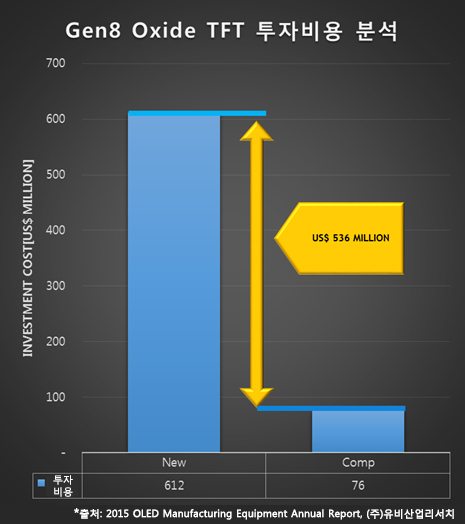
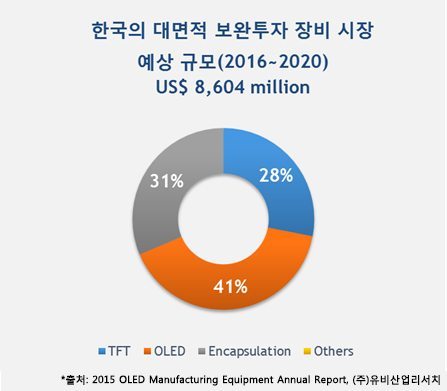
Mitsubishi Chemical and Pioneer Develops Bluelight-less OLED Lighting
/in Lighting /by OLEDNETJapan’s Mitsubishi Chemical and Pioneer announced their success in developing the first bluelight-less OLED lighting module. The two companies produced this module through a wet coating process for the light-emitting layer and began shipping samples on August 1.
The new OLED lighting module does not use blue emitting materials in the OLED panel and the light from the panel contains a minimal portion of blue light. According to the companies, this is less than 1% of the amount in the 3000K-type OLED lighting module developed by Mitsubishi Chemical and Pioneer.
The panel is a candle-color type with a 1900K color temperature; this is suitable for storage lighting of light-sensitive items such as cultural heritage and paintings, as well as lighting for bedrooms and medical practices.
Blue light, which has a wavelength of between 380 and 495 nanometers, has the highest energy among visible light. This is enough to reach the retina at almost full strength. This can cause eye fatigue as well as reduction in quality sleep.
With the increase of smartphone and PC use, the amount of time exposed to blue light is also increasing. Therefore, as the interest in eye health rises, this bluelight-less OLED lighting module development is worthy of attention.
[IMID 2015] UDC Develops OLED Patterning Technology with Less Masks
/in Technology /by OLEDNETAt present, FMM (Fine Metal Mask) is considered the main method for large area RGB OLED panel production. However, due to shadow effect, mask total pitch fluctuations, and mask slit tolerance issues, there is a yield limitation to this technology. This limitation increases as the resolution becomes higher; minimizing the number of FMM during the OLED panel production has been a key issue in RGB OLED production.
In SID 2014, through a paper titled “Novel Two Mask AMOLED Display Architecture”, UDC revealed a technology that can reduce the number of masks used in RGB-FMM method to 2 from previous 3.

Source : UDC, SID 2014
As shown above, this technology coats yellow and blue subpixels using 1 mask each. Following this process, green and red color filters are applied above the subpixels. Pixels are formed as illustrated below.
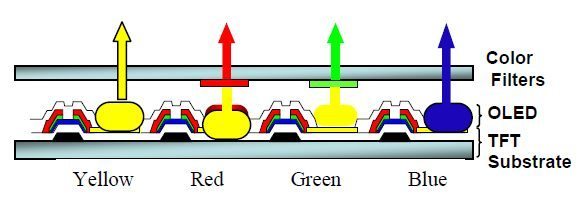
Source : UDC, SID 2014
UDC explained that this technology improves lifetime of the display overall and reduces energy consumption as blue voltage can be lowered. Additionally, tact time can be reduced through this technology, and increase the yield.
In IMID 2015, UDC presented research of the same title. However, the content of the presentation unveiled more developed research compared to 2014. First of all, in 2014, UDC announced that the panel’s lifetime could be improved by 2 times compared to the RGB method. In IMID 2015, UDC’s announcement changed the figure to 3.3 times increased lifetime.
UDC also revealed that the technology can be actualized through printing method, and has the advantage of being able to print 2 rows of pixels at once. UDC announced that this is most suitable when OVJP (Organic Vapor Jet Printing) applies the printing method.
A new technology called SPR (Sub-Pixel Rendering) was also announced by UDC in this paper. The 2014 SID paper included a method that did not uses SPR. As shown below in figure 1, 4 subpixels of RGY and B are used per pixel.
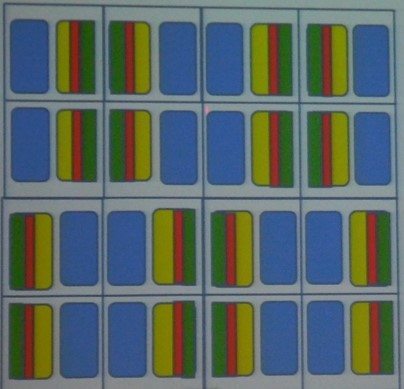
[Fig. 1], Source: UDC, IMID 2015
During IMID 2015, UDC presented APR technology applied pixel structure. Figure 2 shows 3 subpixels per pixel.

[Fig. 2], Source: UDC, IMID 2015
In this case, as the pixels can be arranged as shown in figure 3, smaller number of subpixels can be used.
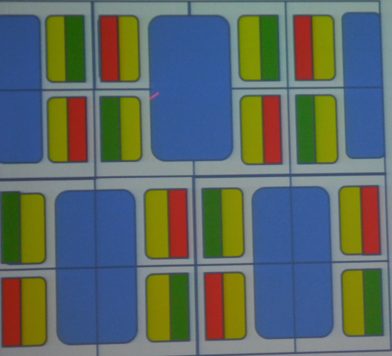
[Fig. 3], Source: UDC, IMID 2015
UDC announced that because APR technology allows the number of subpixels per pixel to be reduced to 3 or less, the number of data lines and TFT per pixel can also be reduced together.
UDC explained that this technology can be applied regardless of the display area or resolution, and will be able to be applied to different types of panels.
[IMID 2015]UDC, 저 Mask OLED Patterning 기술 개발
/in 미분류 /by OLEDNET현재 대면적 RGB OLED 패널을 제조할 수 있는 주요 방법으로 FMM(Fine Metal Mask)가 꼽히고 있지만 shadow effect와 mask total pitch 변동, mask slit tolerance의 문제로 수율이 제한적인 한계가 있다. 이런 한계는 해상도가 올라갈수록 점점 커지고 있어 OLED 패널 제조 시 사용되는 FMM 개수의 최소화는 RGB 방식 OLED의 주요 이슈였다.
UDC에서는 작년 SID 2014에서 “Novel Two Mask AMOLED Display Architecture”의 논문을 통해 기존의 3 mask를 사용하는 RGB-FMM 방식에서 mask 사용을 2장으로 줄일 수 있는 기술을 공개하여 큰 화제를 모았다.

Source : UDC, SID 2014
이 기술은 위의 그림과 같이 yellow와 blue 서브픽셀을 각각의 mask를 써서 증착한 후 green과 red 서브픽셀 위에 각 색의 color filter를 올리는 방식이다. 이 때 공정 후 아래 그림과 같이 픽셀이 형성된다.

Source : UDC, SID 2014
UDC는 이 기술을 통해 blue 전압을 줄일 수 있기 때문에 display 전체적인 수명이 향상되고 소비전력이 감소하는 장점을 가질 수 있다고 설명한 바 있다. 또한 이 기술을 통해 tact time을 감소하고 수율을 증가할 수 있다고 밝혔다.
이번 IMID 2015에서 UDC는 같은 제목의 연구를 발표하였다. 하지만 구체적인 내용은 작년에 발표한 내용보다 한 단계 발전하였다. 먼저 작년 SID에서 UDC는 RGB방식에 비해 패널의 수명을 2배 향상할 수 있다고 발표했지만 이번 IMID에서는 3.3배 향상할 수 있다고 발표하였다.
또한 printing 방식으로도 기술 구현이 가능하며, 이 때 한번에 2줄의 픽셀을 print할 수 있는 장점이 있다고 밝혔다. UDC는 OVJP(Organic Vapor Jet Printing)가 printing방식을 적용할 때 가장 적합한 방식이라고 발표하였다.
UDC는 이번 논문에서 SPR(Sub-Pixel Rendering)이라는 새로운 기술을 발표하였다. 작년 SID에서 발표한 논문은 SPR이 적용되지 않은 방식으로 아래 [그림1]과 같이 한 픽셀당RGY와 B의 4개의 서브픽셀로 구동된다.

[그림1], Source: UDC, IMID 2015

[그림2], Source: UDC, IMID 2015

[그림3], Source: UDC, IMID 2015
UDC는 “이 기술은 면적이나 해상도에 관계없이 적용할 수 있기 때문에 앞으로 다양한 종류의 패널에 적용이 가능할 것으로 보인다.”고 밝혔다
Mitsubishi Chemical과 Pioneer, Bluelight-less OLED 조명 개발
/in 미분류 /by OLEDNET일본의 Mitsubishi Chemical과 Pioneer가 최초로 Bluelight-less OLED 조명 모듈 개발에 성공했다고 발표했다. 두 회사는 wet coating 공정을 통해 발광층을 만든 이 모듈을 생산하고 지난 1일부터 샘플을 출하하기 시작했다.
이번 새로운 OLED 조명 모듈은 blue 발광 재료를 사용하지 않은 OLED 패널로 발산하는 빛은 최소한의 blue light를 포함하고 있다. Mitsubishi Chemical과 Pioneer는 새로 개발한 OLED 조명 모듈이 이전에 출시한 3000K-type OLED 조명 모듈의 1% 보다 적은 양의 blue light를 낸다고 밝혔다.
패널의 candle-color type은 1900K 색온도를 가지고 있다. 이는 빛에 민감한 문화 유산이나 페인팅 같은 것을 보관하는 곳의 조명뿐만 아니라 의료용과 침실용 조명으로도 적합하다.
380nm에서 495nm 사이의 파장을 가진 blue light는 가시광선 중 가장 큰 에너지를 가지고 있다. 이 빛은 거의 최대 에너지로 망막에 도달하기 충분하다. 망막에 도달한 빛은 눈의 피로뿐만 아니라 숙면을 방해의 원인이 된다.
스마트폰과 PC의 사용 증가로 blue light에 노출되는 시간이 길어지고 있다. 때문에 눈 건강에 대한 관심이 증가되고 있는 상황에서 이번 Bluelight-less OLED 조명 모듈 개발은 주목해야 할 성과가 될 것으로 예상된다.
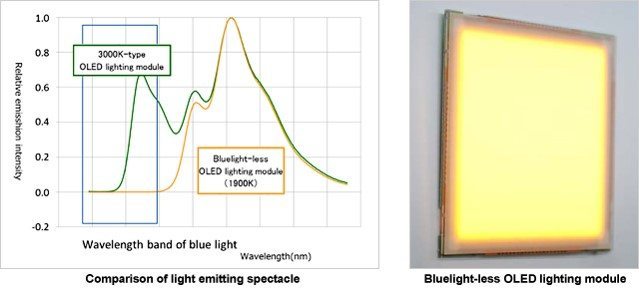
Source : MPOL

Source : MPOL
LG Electronics’ OLED TV, Increasingly Competitive in Price
/in Set /by OLEDNETOLED TV price, which was considered the biggest issue compared to LCD TV, has fallen once again. LG Electronics’ 2015 new model 65inch 4K Ultra HD curved OLED TV (65EG9600) is now priced US$ 5,999 on Amazon (www.amazon.com). The price that used to be US$ 8,999 even in June fell to US$ 6,999 in July, and it is now down to US$ 5,999, showing rapid decrease. Furthermore, the price decrease is not limited to 65inch products as 55inch 4K Ultra HD curved OLED TV (55EG9600) also fell by US$ 1,000, from US$ 4,999 to US$ 3,999.
There is a difference of US$ 1,500 in price between LG Electronics’ 65inch 4K OLED TV and Samsung Electronics’ premium model 65inch 4K SUHD TV (US$ 4,499). Analysis shows that the monthly average price decrease for OLED TV between June and August is 18% while SUHD TV’s is 5%.
During the last earnings results announcement, LG Electronics reported that UHD OLED TV will achieve price competitiveness in 2016. If the price decrease continues at this rate, OLED TV will be able to aim for market expansion against LCD TV through price as well as its many advantages such as design freedom, thickness, and picture quality.
LG Electronics reduced the price of 55inch Full HD curved OLED TV (55EC9300), released last year, from US$ 2,499 to US$ 1,999.
LG전자의 OLED TV, 가격 경쟁력 점점 모습을 드러내나
/in 미분류 /by OLEDNETLCD TV와 가격 경쟁력이 가장 큰 문제로 대두되었던 OLED TV의 가격이 또 한번 하락했다. 미국의 인터넷 소매점 아마존(www.amazon.com)에서 LG전자의 2015년 신모델인 65inch 4K Ultra HD curved OLED TV(65EG9600) 가격을 US$ 5,999로 공시했다. 이전 6월까지만 해도 US$ 8,999였던 가격이 지난 7월 US$ 6,999까지 내려간 데에 이어 US$ 5,999로 빠른 하락세를 보이고 있다. 65inch급 제품뿐만 아니라 55inch 4K Ultra HD curved OLED TV(55EG9600)도 기존 US$ 4,999에서 US$ 3,999로 US$ 1,000의 하락폭을 보였다.
삼성전자의 프리미엄 모델인 65inch급 4K SUHD TV 가격이 US$ 4,499로 LG전자의 65inch급 4K OLED TV와 US$ 1,500의 가격 차이가 나는 것으로 나타났다. 지난 6월부터 8월까지 월평균 가격 하락률이 18%인 OLED TV에 비해 SUHD TV는 5%로 분석되었다.
LG전자는 지난 실적 설명회에서 2016년에 UHD OLED TV 제품의 가격 경쟁력을 갖출 것이라고 발표했다. 지금과 같은 하락폭이 지속된다면 내년 상반기에는 LCD TV와 가격을 포함해 자유로운 디자인, 두께, 화질의 장점을 통해 시장 확대를 노릴 수 있을 것으로 예상된다.
또한, LG전자는 작년에 공개한 55inch Full HD curved OLED TV(55EC9300)의 가격을 US$ 2,499에서US$ 1,999로 내렸다.
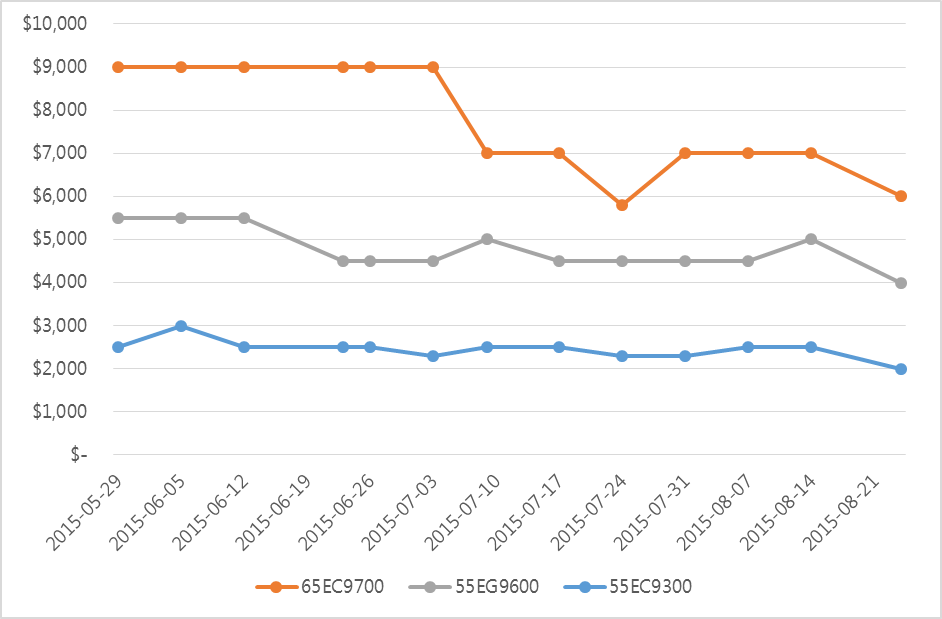
AUO Unveils New AMOLED Panels in Touch Taiwan 2015
/in 미분류 /by OLEDNETOn August 24, AUO announced a lineup of mobile device displays and technologies for Touch Taiwan 2015 (August 26-28).
According to AUO, the lineup includes slim, light and power-saving displays for wearable devices, UHD 4K displays for smartphone and notebook PC, oTP-Lite (on-cell touch panel) supporting professional graphic stylus, in-cell touch panels, and a complete series of ultra-high resolution car displays.
Out of AUO’s releases for Touch Taiwan 2015, two are of interest for OLED experts. AUO’s ultra-thin AMOLED display panels are one. These 1.5 and 1.6inch square AMOLED displays reduced the panel thickness to 0.45mm using the glass thinning method. AUO’s 1.4inch full circle AMOLED display which was unveiled earlier this year in SID 2015 will also be presented.
A 5inch bendable AMOLED prototype that will be shown at the exhibition is another. This plastic substrate applied display integrates a sensor. AUO explains that this sensor allows users to bend the panel intuitively to manipulate the size and direction of the display active area. Until now, other panel companies presented flexible or foldable AMOLED displays only in exhibitions. There is much interest in how AUO’s bendable AMOLED prototype works and differentiated.
AUO, Touch Taiwan 2015에서 새로운 AMOLED panel 공개
/in 미분류 /by OLEDNET지난 24일, AUO는 Touch Taiwan 2015에서 공개할 모바일용 디스플레이와 기술 라인업을 발표했다.
AUO는 웨어러블 디바이스용으로 얇고 가벼운 절전형 디스플레이, 스마트폰과 노트북 PC용 UHD 4K 디스플레이, in-cell 터치와 전문적인 그래픽 스타일러스를 지원하는 oTP-Lite(on-cell touch panel), ultra-high 해상도의 자동차용 디스플레이가 라인업에 포함되었다고 자사 홈페이지를 통해 밝혔다.
Touch Taiwan 2015에서 AUO가 공개하는 것 중 OLED 전문가라면 두 가지의 흥미로운 것이 있다.
첫 번째는 AUO 의 ultra-thin AMOLED 디스플레이 패널이다. 1.5인치와 1.6인치 크기의 square AMOLED 디스플레이는 glass thinning 기법을 사용해 두께를 0.45mm 줄였다. 또한 지난 SID 2015에서 공개한 AUO의 1.4인치 full circle AMOLED 디스플레이도 전시할 예정이다.
두 번째는 5인치 bendable AMOLED 프로토타입이다. 이 플라스틱 기판이 적용된 디스플레이는 센서를 통합되어 있는 제품이다. AUO는 이 센서를 통해 사용자가 디스플레이 활성 영역의 크기와 방향을 직관적으로 조작할 수 있다고 설명했다. 이전 다른 패널 업체들은 여러 전시회를 통해 rollable과 foldable AMOLED만 공개했었다. 이번 Touch Taiwan 2015에서 처음으로 공개하는 bendable AMOLED 디스플레이에 AUO가 어떠한 형태로 구현을 했을지에 대한 기대를 모으고 있다.
[IMID 2015] Hyundai Motors, “OLED Application of Automotive Display, Soon to be a Reality”
/in 미분류 /by OLEDNETOn 19 August at IMID 2015 (August 18 – 21), a keynote speaker Munhyun Kim of Hyundai Motors forecast that automotive display market will become more active, digitalized, and simplified. Kim categorized automotive display applied sectors into 4: cluster, HUD (head-up display) and CID (central information display), and RSE (rear seat entertainment).
Kim revealed that technological trends of cluster are full color, high resolution, and customizability, particularly it can be customized to suit the user through diverse modes. Full color, high resolution, and AR (augmented reality) are the main trends for HUD. Distance guide, direction guide, and lane guide were suggested as examples of AR. CID’s main technological trends are integrated display and insertion of diverse functions. OLED applied CID is being researched. Enlargement, individuality, and mobility were mentioned as technological trends of RSE.
Kim revealed that compared to automotive market which records 3-6% of growth each year, cluster and CID are forecast to grow by 10% a year. He added that although the weight of automotive LCD within the total LCD market is slight, the automotive OLED’s importance is forecast to grow to record 30% or over in 2017.
In the past, 4inch or larger display were mainly installed in vehicles, but it is estimated that small display of less than 4inch will be increasingly introduced. Kim also added that he expects automotive display in diverse shapes and forms will be applied in future.
In CES 2015, Hyundai Motors exhibited AR grafted HUD, 3D-gesture control technology, wearable devices connected to the vehicle, next generation infortainment technology, and ADAS (advanced driver assistance systems).
Kim expected the OLED display application will actively occur in the order of cluster, HUD, CID, and entertainment display. He also evaluated OLED panel that can easily actualize flexibility higher than LCD panel.
[IMID 2015] LG Display Reveals Detailed OLED Plans
/in 미분류 /by OLEDNETDuring the keynote session of IMID 2015 (August 18 – 21), LG Display’s Sang Deog Yeo, the head of OLED division revealed LG Display’s intention to change the world with OLED together with everyone and strength in OLED industry expansion. Yeo explained that the most important factor in the success of large area OLED is strong conviction in OLED’s success and courage; he also announced further investment for OLED as future growth stimulus.
Yeo reported that TV’s first revolution was a change from black and white TV to color. The second revolution was the appearance of flat panel display and that the third revolution will be OLED. He explained that the key factors in TV panels are design and picture quality. He evaluated that these factors are advancing separately in other display while OLED is improving these issues together.
Explaining in more detail, Yeo reported that OLED has high design freedom as OLED structure is simple, a self-emitting light without BLU. Additionally, each pixel of OLED can operate independently and actualize true black, leading to differentiated picture quality.
In the beginning, LG Display struggled in applying WRGB technology and oxide TFT to OLED TV, which resulted in almost 0% of yield. Even within the company, there were opinions that oxide TFT application to Gen8 panel or larger will be almost impossible. However, the effort including introduction of external compensation circuit and coplanar structure, and compensation algorithm application to brightness and color brought LG Display’s current success of OLED TV mass production.
Yeo announced that much like how LG Display solved OLED TV’s technological problems of the past, they will improve the oxide TFT mobility to 50. He also revealed that LG Display is searching for a method of applying top-emission technology to mass production in order to improve transparent and flexible OLED technology, and researching light shutter technology and improved plastic substrate application technology.
LG Display recently announced their decision to invest approximately US$ 9,300 million centering around OLED. During the keynote session, Yeo reported that LG Display will increase the large area OLED panel’s production rate through investment, specifically from current 600 thousand units to 2 million units in 2017. He also announced that they will expand Gumi Gen6 line which will be used to increase production rate of small to medium-sized OLED panels and plastic OLED panels.
Although there has been speculation regarding this investment, through this keynote speech, it can be forecast the investment will be used in specific roadmap of large and small to medium-sized OLED. For the progress of OLED industry, which is growth stimulus of the future, Yeo emphasized the need for closer cooperation between materials, components, manufacturing equipment, and set companies, and laboratories and universities.
[IMID2015] 현대자동차, “차량용 디스플레이 OLED 적용, 머지 않은 현실이 될 것”
/in 미분류 /by OLEDNET8월 19일 IMID 2015의 keyneote session에서 현대자동차의 김문현 상무는 자동차 디스플레이 시장이 앞으로 더욱 활성화 되고 디지털화되며 단순해질 것이라고 전망하였다. 김상무는 자동차용 디스플레이가 적용되는 주요 분야는 4가지로, 클러스터와 HUD(Head Up Display), CID(Central Information Display), RSE(Rear Seat Entertainment)로 구분지었다.
먼저 클러스터는 full color와 high resolution, customizable이 기술적인 트렌드이며 특히 사용자에 맞는 다양한 모드로 customizable을 구현할 수 있다고 밝혔다. HUD는 full color와 high resolution, AR(Augmented Reality:가상현실)이 주요 기술 트렌드이며 AR의 예로 distance guide와 direction guide, lane guide를 제시하였다. CID는 집적된 디스플레이와 다양한 기능을 삽입하는 것이 주된 기술적 트렌드이며 특히 OLED를 CID에 적용하는 것이 연구 중이라고 밝혔다. 또한 RSE는 대면적화, 개인화, 이동 가능한 기능 등을 기술 트렌드로 꼽았다.
김상무는 “매년 자동차 시장이 3~6%의 성장세를 기록하는데 비해 클러스터와 CID는 매년 10%의 성장세를 기록할 것으로 예상된다”라고 밝혔다. 또한 전체 LCD 시장 중 자동차용 LCD의 비중은 미미하지만 전체 OLED 시장 중 자동차용 OLED의 비중은 증가할 것으로 전망되며 2017년에는 30%이상이 될 것으로 기대하였다.
또한 과거에는 4인치 이상의 디스플레이가 주로 차량에 장착되었지만 앞으로는 4인치 이하의 소형 디스플레이가 차량에 설치되는 비중이 크게 증가할 것으로 전망하며 다양한 형태의 차량용 디스플레이가 미래에 적용될 것으로 보인다고 예상했다.
현대자동차는 CES 2015에서 증강현실을 접목한 HUD와 3D동작 컨트롤 기술, 웨어러블 기기와의 연동 기술,차세대 인포테이먼트 기술, ADAS(지능형 운전자 보조시스템)기술을 대거 선보인 바 있다.
김상무는 OLED 디스플레이가 클러스터와 HUD, CID, 엔터테인먼트 디스플레이 순으로 활발히 적용될 것으로 전망하며. LCD 패널보다는 플렉시블 구현이 용이한 OLED 패널의 가치를 높이 평가하였다.
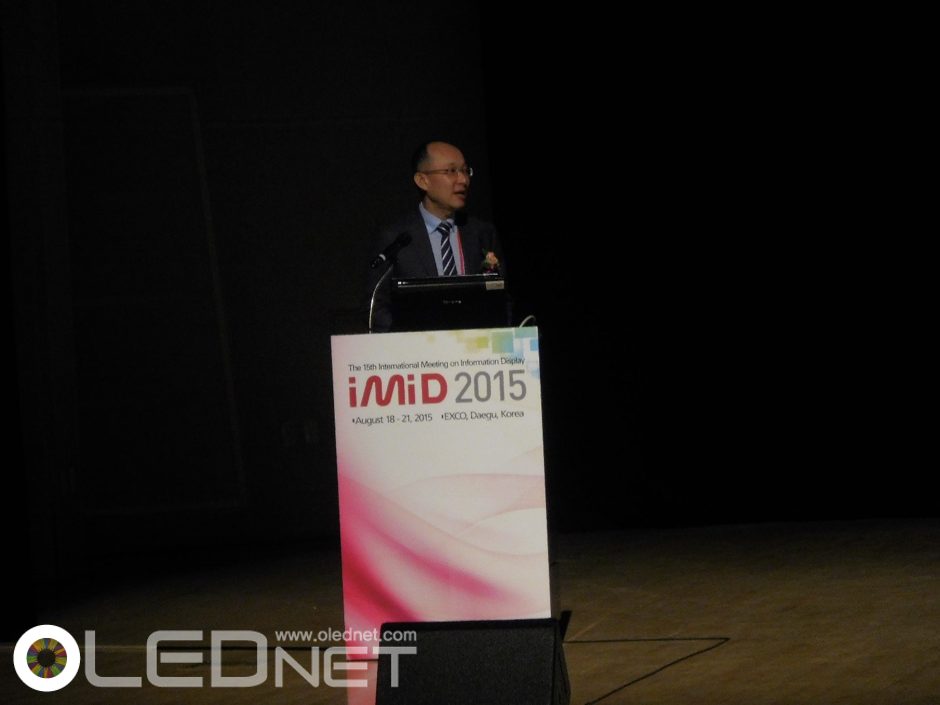
현대자동차 김문현 상무, IMID 2015
[IMID 2015] LG디스플레이, 구체적인 OLED 계획을 밝히다.
/in 미분류 /by OLEDNET대구 엑스코에서 8월 18일 개막한 IMID 2015의 keynote session에서 LG 디스플레이의 여상덕 사장은 “여러분과 함께 OLED로 세상을 바꾸고자 한다.”고 밝히며 OLED 산업 확장에 대한 의지를 내비쳤다. 여사장은 대형 OLED 성공의 가장 중요한 요소는 OLED 성공에 대한 강한 확신과 용기라며 미래 성장동력인 OLED에 대한 투자를 더욱 강화할 예정이라고 밝혔다.
여사장은 TV 시장의 첫번째 혁명은 흑백에서 컬러로 바뀐 것이며 두 번째 혁명은 flat panel display의 등장이며 3번째 혁명은 OLED가 될 것이라고 발표하였다. TV용 패널의 중요 요건으로 디자인과 화질을 꼽으며 다른 디스플레이는 이런 요건이 각각 발전하고 있지만 OLED는 중요 요건이 함께 발전하고 있다고 평가하였다.
구체적으로 OLED는 구조가 단순하며 특히 BLU 없이 자체 발광하기 때문에 디자인 자유도가 높다고 하였다. 또한 OLED는 픽셀 개별 구동이 가능하며 완전한 black을 구현할 수 있기 때문에 화질적인 측면에서 다른 디스플레이와 수준이 다르다고 말했다.
LG디스플레이는 WRGB기술과 oxide TFT를 OLED TV에 적용하는 과정에서 수율이 0%에 가까울 정도로 초반에 고전하였다. 특히 회사 내부에서도 8세대 이상 패널에 oxide TFT를 적용하기는 불가능에 가깝다고 평가될 정도였다. 하지만 외부 보상회로의 도입과 coplanar구조 도입, 밝기와 color에서 보상 알고리즘 적용 등의 노력으로 현재의 OLED TV 양산에 성공하게 되었다.
여사장은 “LG디스플레이는 과거 OLED TV의 기술적 문제를 해결한 것처럼 oxide TFT의 mobility를 50까지 올릴 것이며 transparent와 flexible OLED 기술 향상을 위해 양산에 top-emission 기술을 적용하는 방안을 찾고 있으며 light shutter 기술과 향상된 plastic기판 적용기술을 연구하고 있다.”고 발표하였다.
최근 LG디스플레이는 OLED를 중심으로 10조원을 투자할 것이라고 밝혔다. 이 날 발표에서 여사장은 투자를 통해 대형 OLED 패널의 생산량을 늘릴 것이며 구체적으로 현재 60만장에서 2017년까지 200만장으로 생산량을 늘릴 예정이라고 밝혔다. 또한 구미 6세대 라인을 확장할 것이며 이를 통해 중소형 OLED패널과 plastic OLED 패널 생산량을 늘릴 계획에 있다고 발표하였다.
10조원의 LG디스플레이 투자에 대해 지금까지 대략적인 추측만 있었지만 이 날 발표를 통해 이번 투자가 대형과 중소형 OLED 각각의 구체적인 로드맵에 투입될 것으로 전망된다. 여사장은 소재, 부품, 장비, set 업체와 연구소, 학교가 미래성장동력인 OLED 산업 발전을 위해 더 긴밀한 협력이 필요하다고 강조하였다.
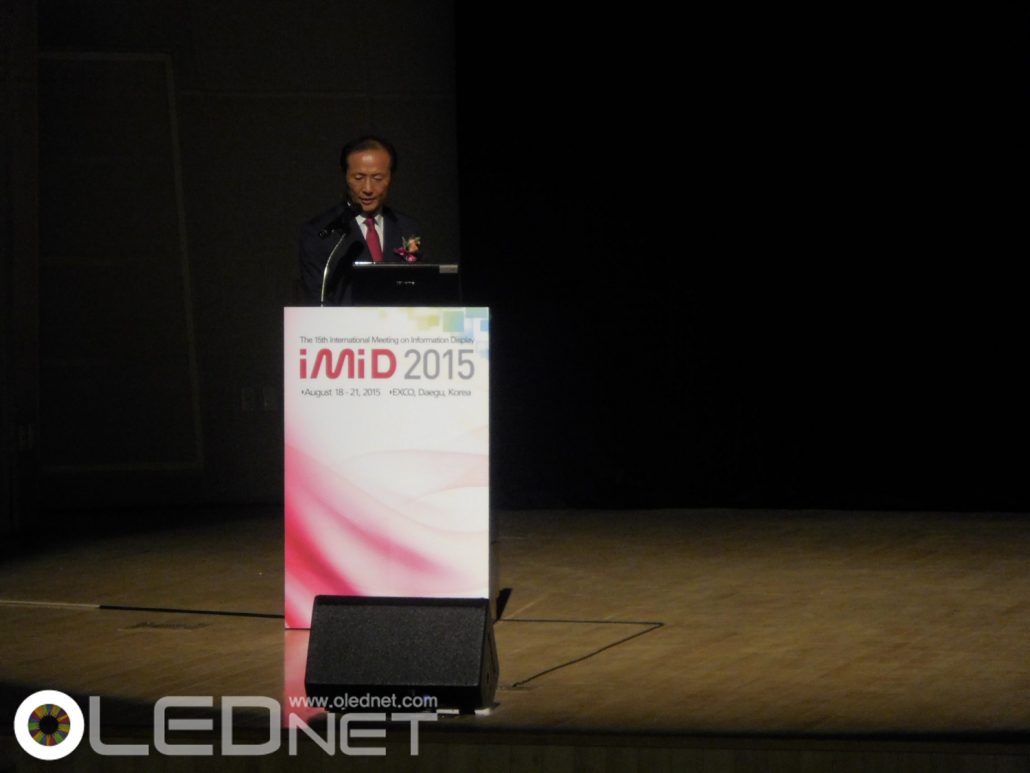
LG Display 여상덕 사장, IMID 2015
LG디스플레이, 여상덕 사장 “OLED, 상상 그 이상의 변화”
/in 미분류 /by OLEDNET■ IMID 2015에서 ‘우리의 삶을 변화시킬 OLED’ 주제로 기조 연설
■ OLED는 궁극의 디스플레이, OLED의 성장을 위해 산-학-연 전방위적 협력 제안
LG디스플레이 OLED 사업부장 여상덕 사장이 “OLED가 화질과 디자인의 강점을 바탕으로 우리의 삶에 상상 그 이상의 변화를 가져올 것”이라고 역설했다.
LG디스플레이(대표이사 사장 한상범, 韓相範 / www.lgdisplay.com) OLED 사업부장 여상덕 사장은 19일 대구 EXCO에서 개최된 ‘IMID(International Meeting on Information Display) 2015’ 개막식에서 ‘우리의 삶을 변화시킬 OLED(OLED, it will change our life)’라는 주제로 기조 연설을 진행했다.
이날 여상덕 사장은 기조 연설에서 디스플레이 및 TV 기술의 발전과 이를 통한 우리 삶의 변화를 살펴보고, 큰 잠재력을 가진 기술인 OLED가 가져올 미래 청사진을 제시했다. 그리고 OLED 개발 및 발전 과정을 소개하고, LG디스플레이의 OLED 사업 전략을 밝혔다.
특히, 여 사장은 “OLED는 TV 발전의 키워드인 화질과 디자인을 동시에 만족시키는 디스플레이로, 전혀 차원이 다른 디스플레이 즉, 궁극의 디스플레이(Ultimate Display)”임을 강조했다. 특히 “OLED는 완벽한 ‘블랙(Black)’으로 구현하는 무한대의 명암비, 풍부하고 정확한 색표현 등 화질뿐만 아니라 초박형 구현이 가능해 투명, 플렉서블(Flexible), 벤더블(Bendable)과 같은 디자인 등에서 새로운 부가가치를 가져다 줄 것”으로 기대했다.
더불어 여 사장은 “LG디스플레이는 WRGB와 Oxide 기술을 기반으로 대형 OLED 시장을 열었으며, 55, 65, 77인치 UHD OLED TV 등을 선보이는 등 그 동안의 축적된 기술력을 바탕으로 향후 대형 및 중소형 OLED 시장 확대를 위한 노력을 경주할 계획”이라고 말했다.
또한, 차세대 OLED 기술과 제품으로 변화될 미래 생활 모습을 예측하면서, 이를 바탕으로 미래 디스플레이가 가야 할 방향을 제시했다.
마지막으로 여 사장은 디스플레이 산업의 미래 성장 동력이 될 OLED의 성장을 위해, 패널업체를 중심으로 세트업체, 재료, 소재, 부품, 장비 등 산업은 물론 학계와 연구기관 등 전방위적인 협력을 제안했다.
한편, ‘IMID 2015’는 8월 18일부터 21일까지 대구 EXCO에서 열리며, 올해는 디스플레이 특별 전시도 마련된다. LG디스플레이는 기조 연설을 비롯해 OLED, 3D 등 디스플레이 기술에 관한 총 9편의 논문을 발표하고, 종이처럼 얇은 55인치 월페이퍼(Wall Paper)를 비롯한 65, 77인치 UHD TV 등의 대형 OLED와 플라스틱 OLED를 기반으로 한 중소형 OLED 등 앞선 기술과 제품을 선보일 예정이다.
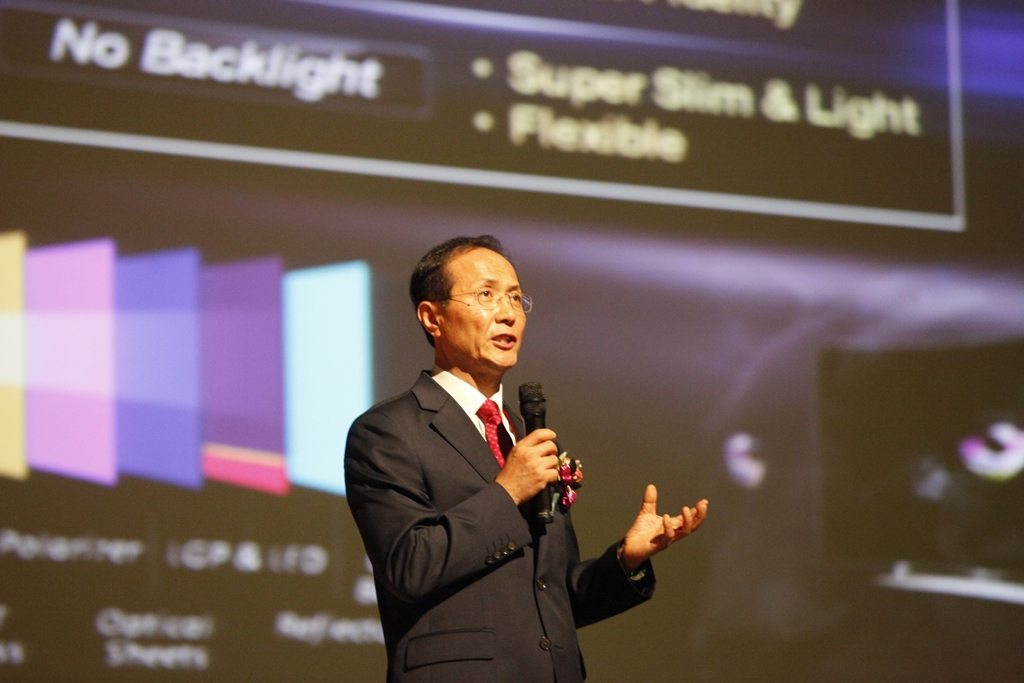
LG디스플레이 OLED 사업부장 여상덕 사장이 19일 대구 EXCO에서 개최된 ‘IMID 2015’ 개막식에서 ‘우리의 삶을 변화시킬 OLED’라는 주제로 기조 연설을 하고 있는 모습.
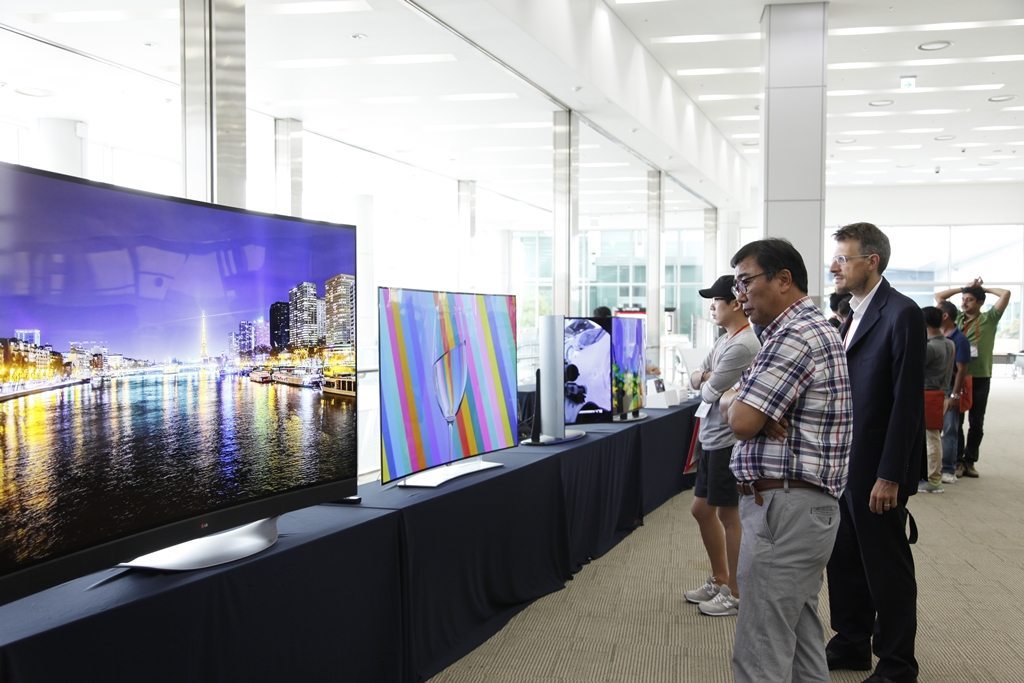
LG디스플레이는 19일 대구 EXCO에서 개최된 ‘IMID 2015’ 개막식에서 OLED 사업부장 여상덕 사장의 기조 연설을 비롯해 월페이퍼 TV 및 65, 77인치 UHD TV 등 OLED 제품을 전시하고 관람객에게 선보였다.
Samsung Electronics Unveils Galaxy Note5 and Galaxy S6 Edge Plus
/in 미분류 /by OLEDNETOn August 13 (local time), Samsung Electronics unveiled Galaxy Note5 and Galaxy S6 Edge Plus in Lincoln Center for the Performing Arts in New York, US. JK Shin, president and CEO of Samsung Electronics presented the new products. Shin emphasized that Galaxy Note5 is focused on practicality and Galaxy S6 Edge Plus on design.
Galaxy Note 5 has 5.7inch QHD (2560X1440) AMOLED panel with Exynos 7422 processor and 4GB of RAM. With a curved back, it is easier to hold in hand. The thickness was reduced to 7.6mm from Galaxy Note4’s 8.5mm. Another new feature is having the S Pen popping out like a spring, and improved writing function. Additionally, even when the screen is off, memo app can be turned on by removing the S Pen.
Galaxy S6 Edge Plus has curved sides to its display, much like Galaxy S6 Edge. The size increased to 5.7inch, 0.6inch larger than Galaxy S6 Edge’s 5.1inch. With the resolution of 2560X1440, Galaxy S6 Edge Plus generally shares same specs as Galaxy Note5.
As both products utilize Samsung Pay and wireless charging, it is analyzed that these features will continue to be applied to future products.
Samsung Electronics have been unveiling new releases of Galaxy Note series at IFA held in September each year. However, they moved up the release by approximately 1 month, and chose Lincoln Center, in New York, US, Apple’s playground, showing active response against iPhone 6S which will be released in 1 month.
Gear A, although anticipated to be revealed during this event, was not presented. It is now more likely that it will be shown in IFA next month.

삼성전자, 언팩행사를 통해 ‘Galaxy Note5’와 ‘Galaxy S6 Edge Plus’ 공개.
/in 미분류 /by OLEDNET삼성전자는 13일(현지시간) 미국 뉴욕 링컨센터에서 ‘Galaxy Note5’와 ‘Galaxy S6 Edge Plus’를 언팩행사와 함께 공개하였다. 신종균 삼성전자 IM부문 사장은 이번 언팩 행사를 진행하며 직접 공개 프리젠테이션을 하였다. 신종균 사장은 “Galaxy Note5는 중심을 실용성에 맞췄고, Galaxy S6 Edge Plus는 디자인에 초점을 맞춘 제품”이라고 강조하였다.
‘Galaxy Note5’는 5.7인치 QHD(2560X1440) AMOLED 패널을 장착하였으며 엑시노스 7422 프로세서, 4GB 램 등을 탑재했고 뒷면 모서리를 둥글게 처리해 손에 쥐었을 때 밀착력을 높였다. 두께는 Galaxy Note4의 8.5mm에서 7.6mm로 줄였다. 전작에 비해 S펜이 스프링처럼 나오는 기능를 추가했고 필기 성능을 향상시켰다. 또한 스마트폰이 꺼진 상태에서 S펜을 꺼내면 메모장이 뜨도록 하는 기능을 선보였다.
‘Galaxy S6 Edge Plus’는 Galaxy S6 Edge와 마찬가지로 양쪽 테두리에 곡면을 사용하였지만 5.7인치의 크기로 Galaxy S6 Edge의 5.1인치보다 0.6인치 커졌다. 또한 2560X1440 해상도를 지원하는 등 전체적으로 ‘Galaxy Note5’와 동일한 스펙을 보유하였다.
이번에 공개된 두 제품 모두 삼성 페이와 무선 충전 기술이 적용됨에 따라 차기 제품에도 두 기술이 지속적으로 적용될 전망이다.
삼성전자는 매년 9월 독일 베를린에서 열리는 국제가전박람회(IFA)에서 Galaxy Note 시리즈의 차기 모델을 공개해왔다. 하지만 이번에는 기존보다 공개시점을 한 달 가량 앞당겼고, 애플의 텃밭인 미국 뉴욕 링컨센터라는 공개장소를 택하며 한 달 뒤에 공개될 애플의 iPhone6S에 대비해 적극적으로 견제하는 모습을 보였다.
이번 언팩행사에서 공개될 것으로 예상되었던 Gear A는 공개되지 않았으며 이에 따라 다음달에 열리는 IFA에서 공개될 확률이 높아졌다.
삼성전자는 언팩행사에서 공개한 두 제품을 빠르면 오는 21일에 시장에 출시한다는 방침이다.
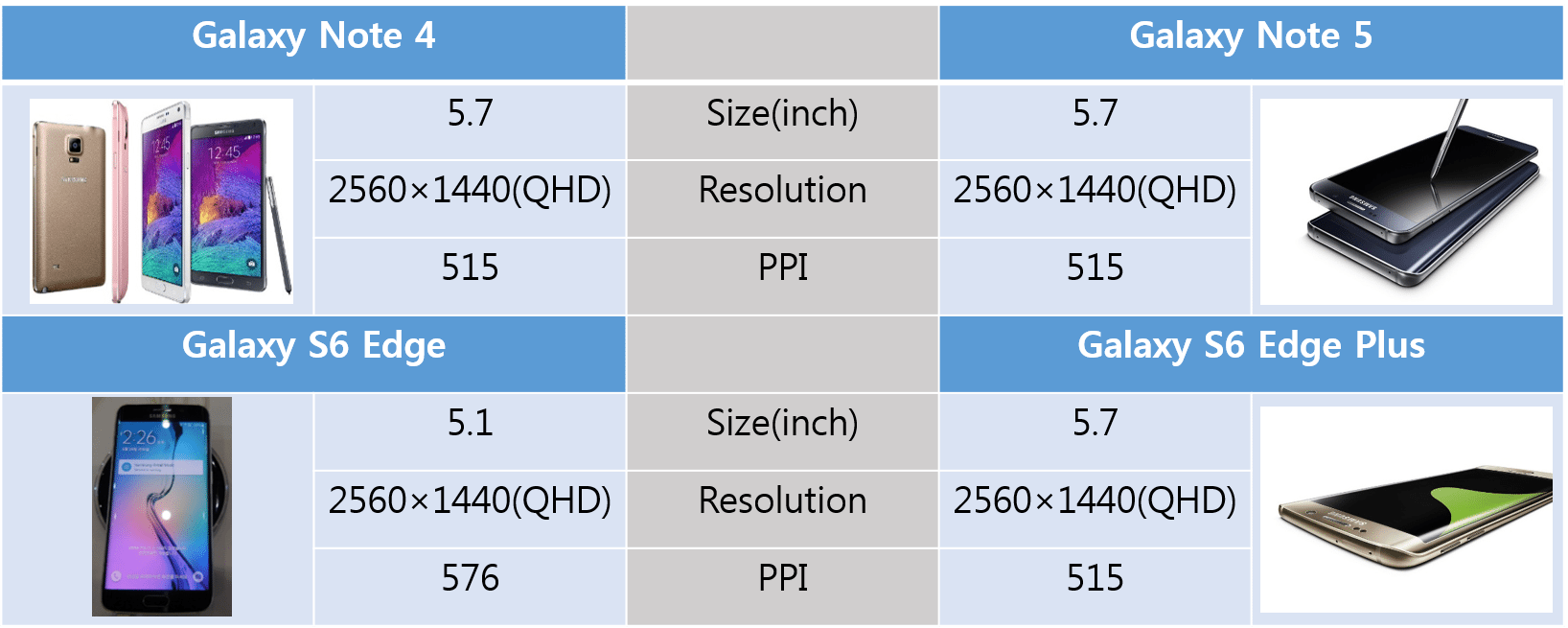
How Can Small and Medium-Sized OLED Panel Companies Survive?
/in Lighting /by OLEDNETWith the great increase of interest in flexible OLED from China and Taiwan’s small and medium-sized panel companies, diverse issues related to this are emerging.
Recent smartphone trend is moving from high resolution and specs toward diverse designs such as curved or bendable/foldable and flexible display that can differentiate applications. AMOLED flexible display is currently being applied to smartphone and smartwatch. However, only 2 companies, Samsung Display and LG Display, are supplying these high spec flexible AMOLED panel.
Small and medium-sized panel companies do not have the technology to mass produce high performance flexible AMOLED panel and cannot invest in mass production. For these reasons, Chinese and Taiwanese small and medium-sized companies are aiming for finding new applications where flexible PMOLED or low resolution flexible AMOLED can be applied and make mass production investment. Accordingly, set companies’ interest in flexible OLED applied application is also increasing.
Additionally, companies are in agreement that yield of flexible PMOLED that is applied to some smartbands does not meet demand. Taiwan’s wisechip and RiTdisplay, key PMOLED companies, are concentrating on developing flexible PMOLED and flexible OLED lighting. Taiwan’s AUO and Innolux, and China’s Visionox and EDO are also among those that are developing wearable flexible AMOLED.
Diverse application development where lower resolution flexible AMOLED, flexible PMOLED, or flexible OLED lighting, instead of expensive high-end smartphone and smartwatch, can be applied is essential. The outcome of this is forecast to greatly affect the growth of small and medium-sized OLED panel companies.
중소형 OLED panel 업체들의 살길은 어디?
/in 미분류 /by OLEDNET중국과 대만의 중소형 panel 업체들의 flexible OLED에 대한 관심이 증폭됨에 따라 이와 관련된 다양한 이슈들이 나오고 있다.
최근 스마트폰의 트렌드는 고성능 고해상도의 높은 스펙의 high-end panel에서 curved나 bendable/foldable 등의 디자인과 application을 차별화 시킬 수 있는 flexible display 적용에 업체들의 관심이 쏠리고 있는 추세이다.
현재 flexible display로서 AMOLED가 smart phone과 smart watch에 적용이 되어 출시되고 있지만 이러한 고스펙의 flexible AMOLED panel을 공급하고 있는 업체는 삼성디스플레이와 LG디스플레이 두 업체에 불과하다.
중소형 패널업체 입장에서는 이러한 고성능의 flexible AMOLED panel 양산할 기술이 없을뿐더러 양산에 투자할 여력이 없기에 중국과 대만의 중소형 업체들은 flexible PMOLED나 저해상도의 flexible AMOLED이 적용될 수 있는 신규 application을 발굴하고 양산 투자를 하는 것을 목표로 하고 있다. 이에 따라 세트업체들의 flexible OLED를 적용한 어플리케이션에 관한 관심 또한 높아지고 있는 것으로 보여진다.
또한, 현재 smart band 일부에 적용되는 flexible PMOLED는 생산이 수요에 못 미치고 있다는 것이 업체들의 공통된 의견이다.
대표적인 PMOLED 업체인 대만의 wisechip과 RiTdisplay는 flexible PMOLED와 flexible OLED lighting에 대한 개발에 집중하고 있으며, AUO와 Innolux, 중국의 Visionox와 EDO등도 wearable용 flexible AMOLED에 대한 개발을 진행 중이다.
고가의 high-end smart phone과 smart watch가 아닌 저해상도의 flexible AMOLED나 flexible PMOLED, flexible OLED lighting등이 적용될 수 있는 다양한 application 발굴이 앞으로 중소형 OLED panel업체들의 성장에 큰 영향을 미칠 전망이다.
[Analyst Column] Korean Display Industry Is On Descent
/in Analyst column, Focus on /by OLEDNETDr Choong Hoon Yi, UBI Research Chief Analyst, ubiyi@ubiresearch.co.kr
The analysis of 2015 2Q results of Samsung Display and LG Display shows clear indication that Korean display industry is on descent.
[2015 Q2 Korean Display Total Sales Analysis]
According to the results announcement of the 2 companies, the total of 2015 Q2 sales is approximately US$ 11,000,000,000. Compared to the total sales in 2013 Q2 which was US$ 13,000,000,000, Korean display industry trend is exhibiting clear downward tendency.
2015 Q2 Korean display sales records -4% QoQ, and 8% YoY.
The main reason for the decrease in sales is Samsung Display’s deterioration of earnings results. While LG Display’s sales of the past 3 years remain fairly consistent but Samsung Display’s sales is gradually decreasing.
[2015 Q2 Korean Display Total Business Profit Analysis]
Connecting the high points of the total of 2 companies’ business profit reveal that the business value is worsening as the trend moves downward. This also is much contributed to Samsung Display’s business profit decrease.
[Samsung Display and LG Display Sales Analysis]
According to the earnings announcement of both companies, Samsung Display and LG Display recorded sales of approximately US$ 5,500,000,000 and US$ 5,600,000,000 respectively. LG Display is maintaining higher sales results compared to Samsung Display for the past 5 quarters. Each company’s QoQ showed to be -4% (LGD) and -3% (SDC) and YoY to be 12% (LGD) and 5% (SDC). The simultaneous decrease of QoQ sales of both companies demonstrates that the Q3 sales could also fall.
[Samsung Display and LG Display’s Competitiveness Analysis]
Looking at the profit/sales graph of Samsung Display and LG Display, it is apparent that Samsung Display showed superior competitiveness until 2013 Q3, but since then LG Display averaged higher.
[Conclusion]
The reason for the downward trend of Korean display industry is analyzed to be the fall of display panel price due to the Chinse display companies’ mass production through aggressive investment. Particularly, in or after 2017 when China’s BOE is estimated to begin Gen10.5 LCD line, LCD panel price will fall even more rapidly. This is forecast to lead Korean LCD industry to suddenly lose competitiveness. For Korean display companies that have immense LCD sales to show positive growth, it is time to expand OLED business that can be differentiated from Chinse display companies.
The only solutions for Korean display industry are OLED investment in large scale and conversion of LCD line to OLED line. At the time of BOE’s Gen10.5 line operation, Korean display companies also should respond with Gen6 flexible OLED investment and early establishment of Gen8 OLED line.
HUD and HMD Meet Virtual Reality and Soar
/in Technology /by OLEDNETAt SID 2015 Review Workshop held in Konkuk University on July 31, Inha University’s Associate Professor Jae-Hyeung Park announced that interest in HUD (head-up display) and HMD (head-mounted display) increased at SID 2015.
HUD signifies technology that provides diverse information for the driver beyond the role of a front glass that simply allows the outside to be viewed and provides protection. Through HUD, drivers can grasp vehicular and destination information without having to take eyes off the road. At this juncture, AR (augmented reality) HUD is more than a simple display as it recognize the user’s movements and applies it to the display.
In SID 2015 paper, Japan’s Ricoh termed the device that self-intervenes in the vehicular operation as ADAS (Advanced Driving Assistance System) and announced that the information from the device applied to HUD will be able to help the user’s recognition and decision making. It was also added that improved AR can be realized when the contrast range is increased to be equal to reality and reiterated and the distance from the virtual image is 5m.
HMD, as a head-mounted device, provides differentiated feelings of immersion compared to other displays. Due to the increased realism from the wide viewing angle, HMD was widely used as an entertainment display, but with the recent increased interest in AR, it is receiving much spotlight as an AR display device.
At SID 2015, the West Saxon University of Applied Sciences of Zwickau revealed an HMD device that actualizes AR naturally by changing the distance where image is shown according to the use by adjusting the focal distance. Zhejiang University’s college of Optical Science and Engineering used method of showing hologram to each user’s eyes using the light field concept that realizes the light strength to all directions from all points in 3D and produced improved AR.
Park explained that with SID 2015 as a starting point, the AR related HMD and HUD interest and research will increases greatly and that the trend will continue in future.
Samsung Electronics released HMD device Samsung Gear VR that can be used by plugging in to Galaxy S6 or Galaxy S6 Edge. Oculus VR and Sony Computer Entertainment each revealed OLED applied VR headset Oculus Rift and Project Morpheus, and scheduled release regular product in Q1 and H1 of 2016 respectively. Korea’s HLB released AproVIEW S2 which used virtual image distance actualization method, a first for HUD.

Inha University’s Associate Professor Jae-Hyeung Park at SID 2015 Review Workshop
[Analyst Column] 한국 디스플레이 사업 하향길에 들어서다!
/in 미분류 /by OLEDNET이충훈/Chief Analyst
2015년 2사분기 삼성디스플레이와 LG디스플레이의 실적을 분석한 결과 한국 디스플레이 사업이 내리막을 걷고 있는 것이 명확하게 드러났다.
[2015년 2사분기 한국 디스플레이 전체 매출 분석]
양사의 실적 발표에 의하면 2015년 2사분기 합계는 13.33조원이다. 한국 디스플레이 전체 매출은 2013년 2사분기가 16.05조원이었나 현재는 13.33조원으로 나타나며 전반적인 흐름이 하락세를 나타내고 있다.

2015년 2사분기 한국의 디스플레이 매출은 전 분기 대비 QoQ -4% 성장을 나타내었으며, 작년 동 분기에 비해서는 YoY 8% 상승을 보이고 있다.
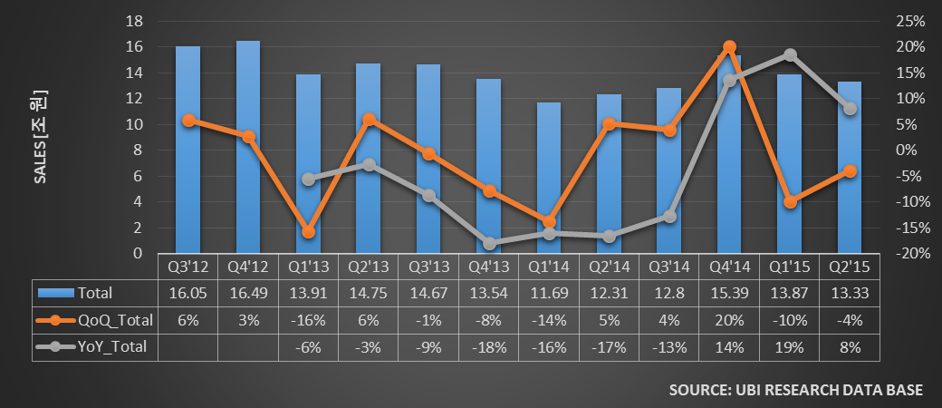
한국 디스플레이 매출이 하락하고 있는 것은 삼성디스플레이의 실적 악화가 주된 요인이다. LG디스플레이는 최근 3년간 매출 변동이 적으나 삼성디스플레이의 매출은 점차적으로 줄어 들고 있기 때문이다.
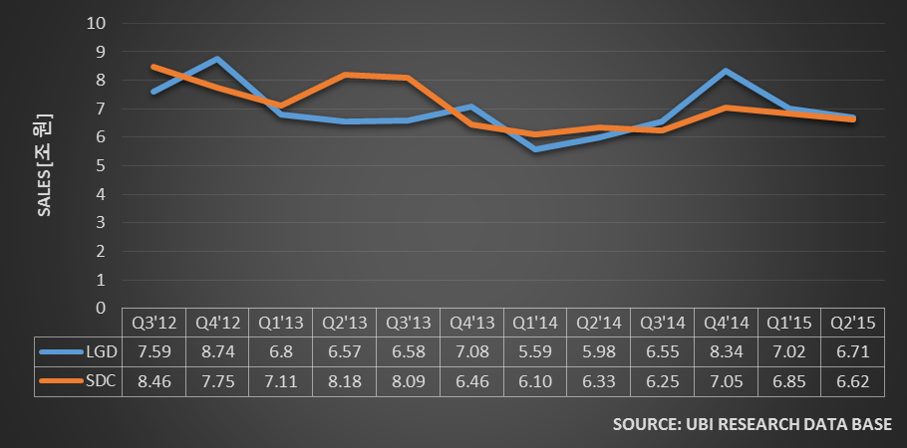
[2015년 2사분기 한국 디스플레이 전체 영업 이익 분석]
양사의 영업 이익 합계에서 고점을 연결해 보면 하락세에 접어들어 사업성이 악화되고 있음을 알 수 있다.
이 결과 역시 삼성디스플레이의 영업 이익 감소가 크게 작용하고 있는 것으로 분석된다.
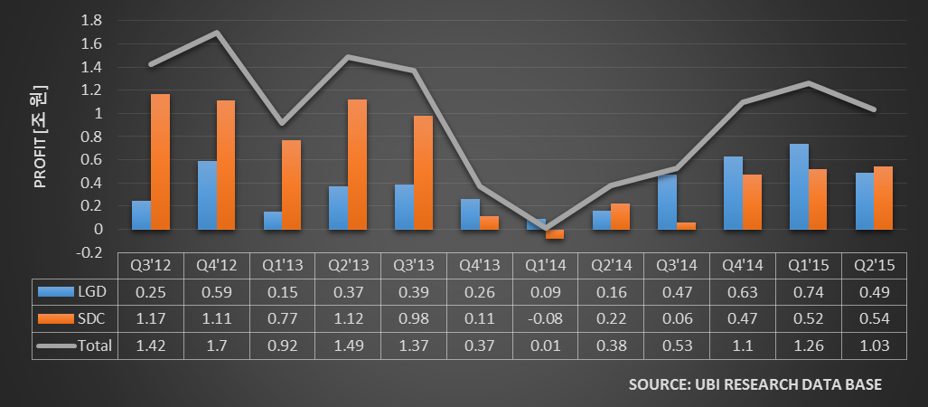
[삼성디스플레이와 LG디스플레이 매출 분석]
양사의 실적 발표에 의하면 삼성디스플레이(SDC)와 LG디스플레이(LGD)는 각각 매출 6.62조원와 6.71조원을 나타냈다. LG디스플레이는 5분기 연속 삼성디스플레이 보다 매출 우위를 점유하고 있다. 양사의 QoQ 각각 -4%(LGD)와 -3%(SDC)를, YoY는 각각 12%(LGD)와 5%(SDC)를 나타내었다. 양사의 2사분기 매출이 1사분기 대비 동시에 하락한 것은 3사분기 매출 역시 하락할 수 있음을 보여주고 있다.
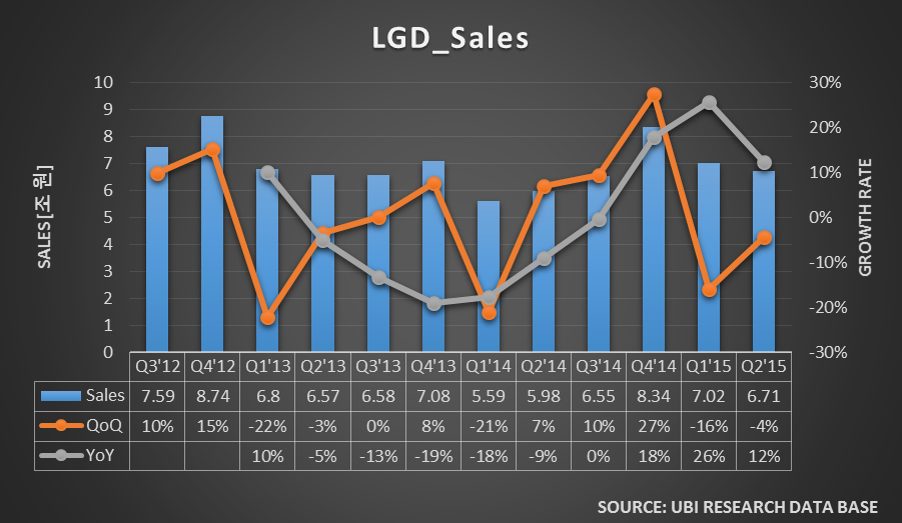

[삼성디스플레이와 LG디스플레이의 경쟁력 분석]
삼성디스플레이와 LG디스플레이의 사업성을 나타내는 영업이익(profit)을 매출(sales)로 나눈 profit/sales에서 보면 2013년 3사분기까지는 삼성디스플레이가 월등한 경쟁력을 보여주었으나, 그 이후에는 평균적으로 LG디스플레이가 높게 나타나고 있다.
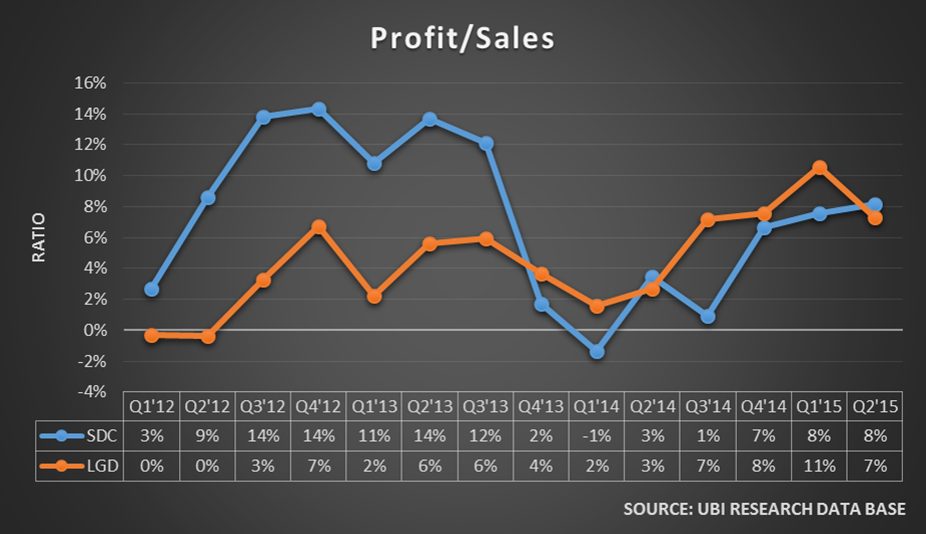
[마무리]
한국 디스플레이 사업이 하락세로 들어선 것은 중국 디스플레이 기업들의 공격적인 투자에 의한 대량 생산이 디스플레이 패널 가격 하락을 유도하고 있기 때문으로 분석된다. 특히 중국 BOE의 Gen10.5 LCD 라인 가동이 예상되는 2017년 이후에는 LCD 패널 가격 인하가 더욱 빨라져 한국의 LCD 사업은 경쟁력을 급격히 상실할 것으로 전망된다. LCD 매출이 압도적으로 많은 한국 디스플레이 기업들이 성장세로 돌아서기 위해서는 중국 디스플레이 기업들과 차별화 할 수 있는 OLED 사업 확대가 필요한 시점이다.
대규모 OLED 투자와 LCD 라인을 빨리 OLED 라인으로 전환해야만 한국 디스플레이 사업이 살 수 있는 유일한 대안이다. BOE의 Gen10.5 라인이 가동되는 시점에는 한국 디스플레이 기업들 역시 Gen6 flexible OLED 투자와 Gen8 OLED 라인 조기 구축으로 대응해야 한다.
HUD와 HMD, 가상현실을 만나 날아오르다.
/in 미분류 /by OLEDNET7월 31일 건국대학교에서 진행된 SID 2015 리뷰 워크샵에서 인하대학교 박재형 부교수는 SID 2015에서 HUD(Head Up Display)와 HMD(Head Mount Display)에 대한 관심이 증가했다고 발표하였다.
HUD는 단순히 외부를 보여주고 비바람을 막아주는 기존 앞 유리의 역할을 넘어서서 운전자에게 다양한 정보를 제공하는 기술을 의미한다. HUD의 도입으로 운전자들은 도로에서 눈을 떼지 않고도 차량과 목적지 정보를 파악할 수 있다. 이 때 단순한 디스플레이가 아니라 사용자의 동작을 인식하여 디스플레이에 반영한다는 것이 AR(증강현실) HUD이다.
일본의 Ricoh사는 SID 2015의 논문을 통해 차량이 자발적으로 조작에 개입하는 장치를 ADAS(Advanced Driving Assistance System)라고 명칭하면서 여기서 얻은 정보를 HUD에 반영하여 사용자의 인식과 판단을 도와줄 수 있다고 발표하였다. 이 때 명암비를 높여 디스플레이가 현실과 일치되어 중첩되게 하고 허상과의 거리가 5m 정도가 될 경우 더 향상된 AR을 구현할 수 있다고 발표하였다.
HMD는 머리에 착용하는 디스플레이 장치를 말하며 다른 디스플레이와 차별화되는 몰입감을 가지고 있다. 또한 넓은 시야각을 가지고 있기 때문에 현장감이 증대되어 엔터테이먼트용 디스플레이 장비로 많이 쓰였지만 최근 AR에 대한 관심이 높아지면서 AR용 디스플레이 기기로 각광받고 있다.
이번 SID 2015에서 Zwickau 응용과학 대학은 초점거리를 조절하여 상이 맺히는 거리를 사용자에 맞게 바꾸어 AR이 자연스럽게 구현되는 HMD 장치를 설계하였다. 중국 저장대학교 광학공학과에서는 3차원 공간상의 모든 점에서 모든 방향으로 빛이 얼마만큼의 세기를 가지는지를 표현하는 Light Field라는 개념을 사용하여 각각의 눈에 홀로그램의 보여주는 방식으로 향상된 AR을 구현하였다.
박재형 부교수는 “SID 2015를 기점으로 하여 AR과 연계된 HMD와 HUD에 대한 관심과 연구가 크게 증가할 것이며 앞으로 이런 경향이 지속될 것으로 보인다.”라고 설명하였다.
삼성전자는 헤드셋에 갤럭시 S6 또는 갤럭시 S6 엣지를 꽂아서 사용하는 HMD 기기인 ‘삼성기어 VR’을 출시하였다. Oculus VR와 Sony Computer Entertainment는 각각 OLED를 적용한 VR 헤드셋 제품인 ‘Oculus Rift’와 ‘Project Morpheus’의 시제품을 발표하고 내년 1분기(Oculus)와 상반기(SCE) 중에 소비자용 정식 버전을 출시할 예정이다. 에이치엘비는 HUD 최초로 ‘허상 거리구현방식’을 적용한 제품인 ‘AproVIEW S2’를 출시한 바 있다.

박재형 인하대 부교수, SID 2015 리뷰 워크샵
Encapsulation Technology That Can Greatly Increase OLED Lifetime Unveiled
/in Technology /by OLEDNETOn July 29, at Chungcheong Display Forum held in Hoseo University in South Korea, an encapsulation technology that can greatly increase OLED lifetime was revealed.
Encapsulation technology prevents permeation of oxygen and moisture from affecting OLED panel’s performance and increases lifetime. As it is also the last process that decides OLED panel yield, OLED panel manufacturing companies are focused on finding the most optimal encapsulation technology.
The flexible OLED panel that is currently being mass produced uses hybrid structure of encapsulation where gas barrier cover plate is applied to the organic and inorganic stacks of passivation.
During this process, because cover plate with gas barrier characteristics is the key factor in deciding encapsulation performance the materials and technology are very important. The level of encapsulation that OLED panel requires is approximately 10-6g/m2day. The unit signifies the amount of permeation for 1m2 area a day. This amount is same as 1 drop of water in an area size of 6 World Cup stadiums.
Generally sputtering technology is used to form gas barrier layer. Sputtering technology is an evaporation technique where ions of the target material is coated to the substrate as noble gas, ionized via high voltage, collides against coating material.
This type of sputtering technology creates particles and defects during process. As such, in order to be applied to OLED, multilayer is required leading to a decrease in productivity and increase in production cost.
However, at the Chungcheong Display Forum, Professor MunPyo Hong of Korea University, revealed that defect that occurs during the existing sputtering process can be reduced by stabilizing target layer through installing reflector which induces neutral beam to be released.
According to Hong, this technology is sufficient to achieve the OLED level encapsulation standard of 10-6g/m2day even using a single layer. He revealed that this technology will be able to reduce the production cost and increase the productivity.

(a) Device Immediately After Production (b) Device with Insufficient Encapsulation with Insufficient Encapsulation (dark spot and pixel shrinkage occurs after certain amount of time) Source: UBI Research
[Analyst Column] LG Display Q2 Earnings Analysis and Signification of Flexible OLED Investment
/in Analyst column, Focus on /by OLEDNETDr Choong Hoon Yi, UBI Research Chief Analyst, ubiyi@ubiresearch.co.kr
On July 23, LG Display announced its earnings results at LG Twin Towers in Yeouido, South Korea. LG Display reported that their Q2 sales recorded approximately US$ 5,700,000,000 with business profit of approximately US$ 420,000,000.
Although sales fell by approximately US$ 260,000,000 (-5%) compared to the previous quarter, it was an increase of US$ 620,000,000 (12%) compared to the year before. Business profit showed approximately US$ 210,000,000 decrease (-34%) QoQ, and YoY US$ 280,000,000 increase (206%).
LG Display’s sales and business profit of Y/Yo (green line) showed U shape of trend of growth in previous 5 quarters but this quarter recorded a fall. It is analyzed that the growth could slow down from 2H 2015.
The drop of the LG display’s Y/Yo growth in this 2Q is much attributed to smartphone market’s slow down and TV market reduction. It is also estimated the panel price reduction due to Chinese display companies’ aggressive investment is reflected.
For LG Display to stop the degrowth, mass production of products that are differentiated from competition, is urgently needed, away from LCD panel that is LGD’s current major business.
On the day, LG Display’s management announced approx. US$ 900,000,000 investment for Gen6 flexible OLED line in order to lead flexible OLED market. The investment location is Gumi factory. Investment location is Gumi factory with the initial investment of 7.5K. It is expected world’s second flexible OLED exclusive line will established following Samsung Display. It is anticipated that up to 15K will be established for this line.
Considering last year’s LG Display’s business profit was approx. US$ 1,100,000,000, the US$ 900,000,000 flexible OLED investment is very large. The investment decision must have been very difficult. However, the reasons for LG Display’s drastic flexible OLED exclusive line investment are because companies that produce LTPS-TFT LCD (LGD’s existing main market) is increasing, and because Samsung Display is already monopolizing rigid OLED market and therefore difficult to secure market share.
LG Display’s CFO Kim Sang-don explained that flexible OLED Gen6 line investment was decided at the board of directors meeting on July 22, and was made official on the morning of July 23. Kim added that the decision was reached so that LG Display can lead the OLED business in terms of technology and to occupy initial market in foldable and rollable technologies. He also commented the monthly capa. of the flexible OLED line will be 7.5K.
Regarding large area OLED panel, it was emphasized that this year’s panel production target remains to be 600,000 units and 1,500,000 units next year, same as the ones announced during the Q1 earnings results presentation. It was also revealed that 34K, approximately 9K higher than current capa., will be in operation in 2016. Addressing the concern of oversupply of next year’s 1,500,000 units while the OLD TV market is still small, LG Display suggested the solution of increasing the demand by active promotion from the second half of this year.
Despite the fall of mid to large size panels’ sales price, from the enlargement of sets and AIT technology applied sales performance, the business profit of approximately US$ 4,000 million was recorded. This is a 34% decrease compared to the previous quarter but a 199% increase from the same period in 2014. LG Display estimates that the sales will increase in the third quarter due to seasonal factors and panel’s enlargement trend.
OLED의 수명을 획기적으로 높일 수 있는 encapsulation 기술 공개
/in 미분류 /by OLEDNET7월 29일 호서대에서 개최된 충청 디스플레이 포럼에서 OLED의 수명을 획기적으로 높일 수 있는 encapsulation 기술이 공개되었다.
Encapsulation 기술은 OLED panel의 성능에 영향을 주는 수분과 산소의 투습을 방지하여 수명을 증가시키는 기술이다. 또한 OLED panel의 수율을 결정짓는 마지막 공정이기 때문에 각 OLED panel 제조 업체는 최선의 encapsulation 기술을 찾는데 집중하고 있다.
현재 양산되고 있는 flexible OLED panel은 유무기 적층의 passivation에 gas barrier cover plate가 합착되는 hybrid 구조의 encapsulation이 적용되고 있다.
이 때 gas barrier 특성이 있는 cover plate가 encapsulation 성능을 결정짓는 핵심 요소이기 때문에 형성하는 재료와 기술이 매우 중요하다. OLED panel에서 요구되는 encapsulation의 수준은 10-6g/m2day이다. 이 단위의 의미는 1일에 1m2의 넓이에 투습되는 양을 의미한다. 이 정도의 양은 6개의 월드컵 경기장을 합친 크기의 공간에 한 방울의 물이 떨어지는 것과 같은 아주 작은 규모이다.
일반적으로 gas barrier layer를 형성하는 데에는 sputtering 기술이 사용되고 있다. Sputtering 기술은 고전압을 통해 이온화된 불활성기체가 코팅재료에 충돌하게 되고, 이 때 타깃물질의 이온이 튀어나와 기판에 달라붙어 코팅이 되는 증착기술이다.
이러한 sputtering 기술은 공정 중 particle이 발생하고 defect가 형성되기 때문에 OLED에 적용하기 위해서는 multilayer로 쌓아주어야 했다. 이 경우 생산성이 약화되고 원가가 증가되는 단점이 있었다.
하지만 충청 디스플레이 포럼에서 고려대학교 홍문표 교수는 sputtering 장비에 반사판을 설치하여 중성화 빔이 방출하도록 유도하면 target 박막을 안정화시켜 기존 sputtering 공정 중에 발생되는 defect를 줄일 수 있다고 발표하였다.
홍문표 교수에 따르면 이 기술은 single layer를 사용하면서도 OLED panel에서 요구하는 encapsulation의 수준인 10-6g/m2day를 달성하기 충분하기 때문에 원가를 낮추고 생산성을 높일 수 있다고 밝혔다.
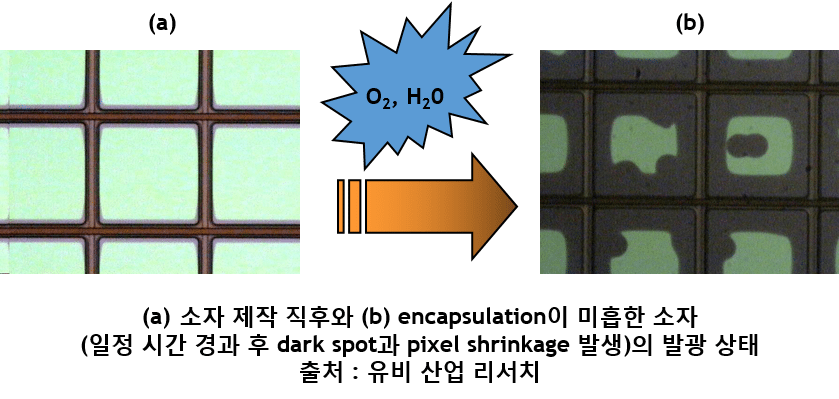
ADDRESS: A-1901, Samho Moolsan Bldg, 83, Nonhyeon-ro, Seocho-gu, Seoul, Republic of Korea (Zip) 06775 TEL:+82-2-577-4390 / E-MAIL:marketing@ubiresearch.com









